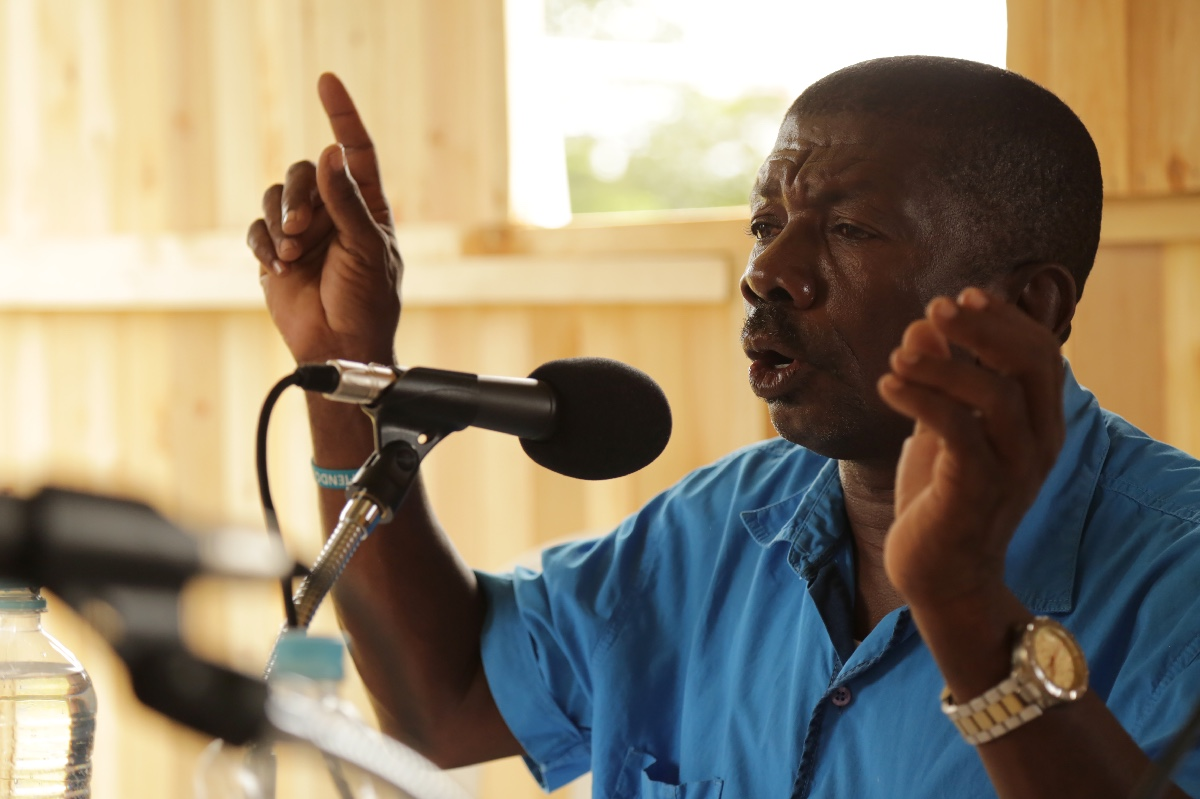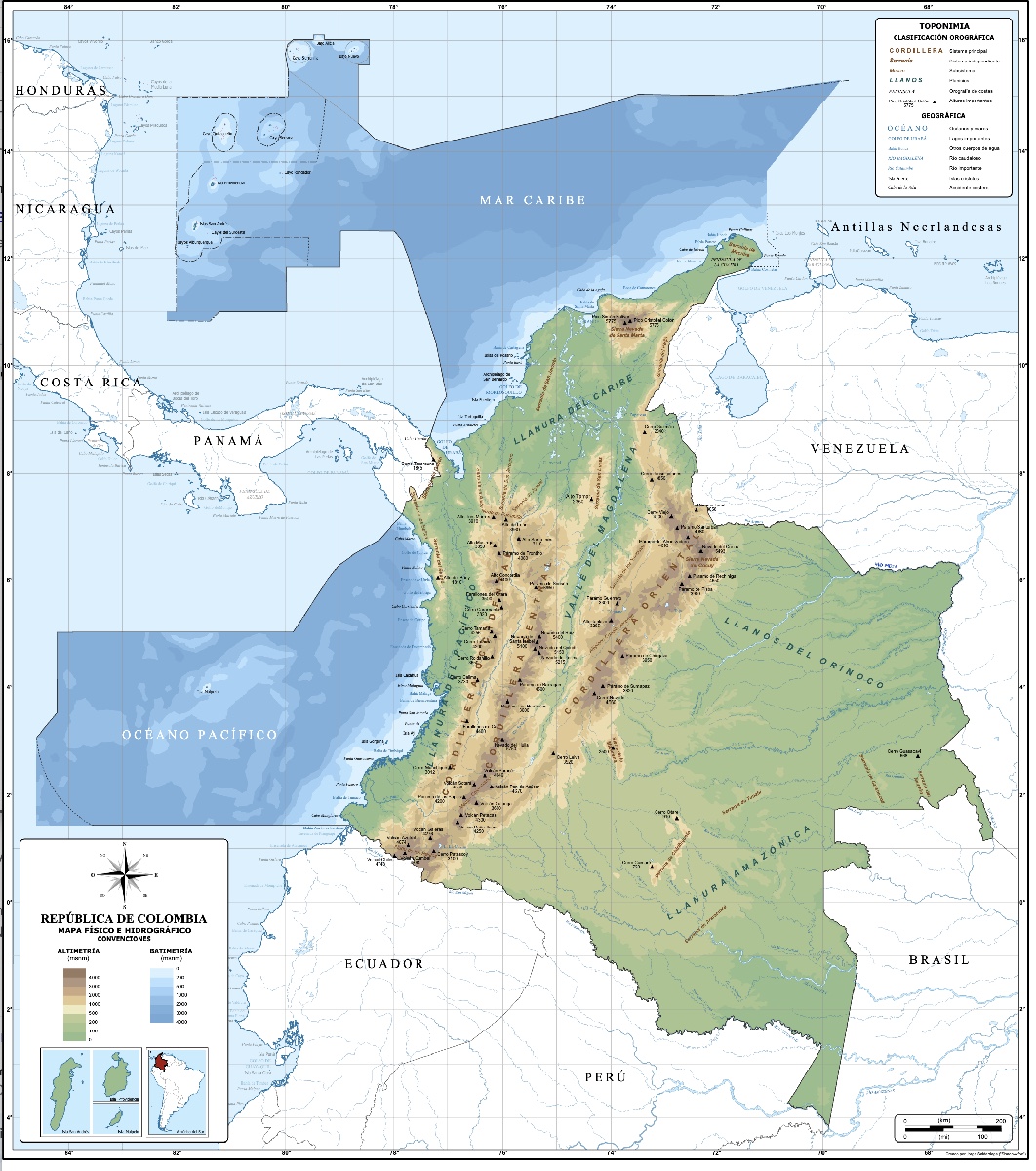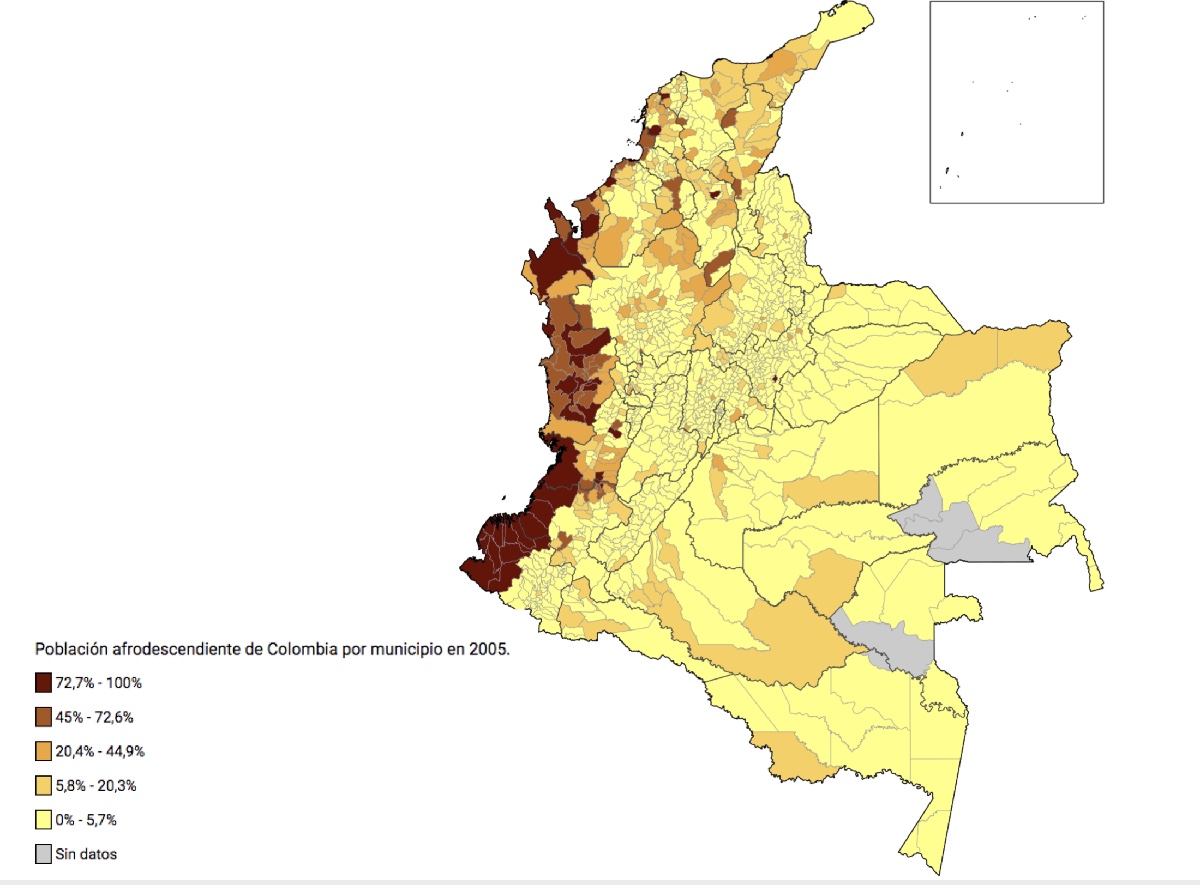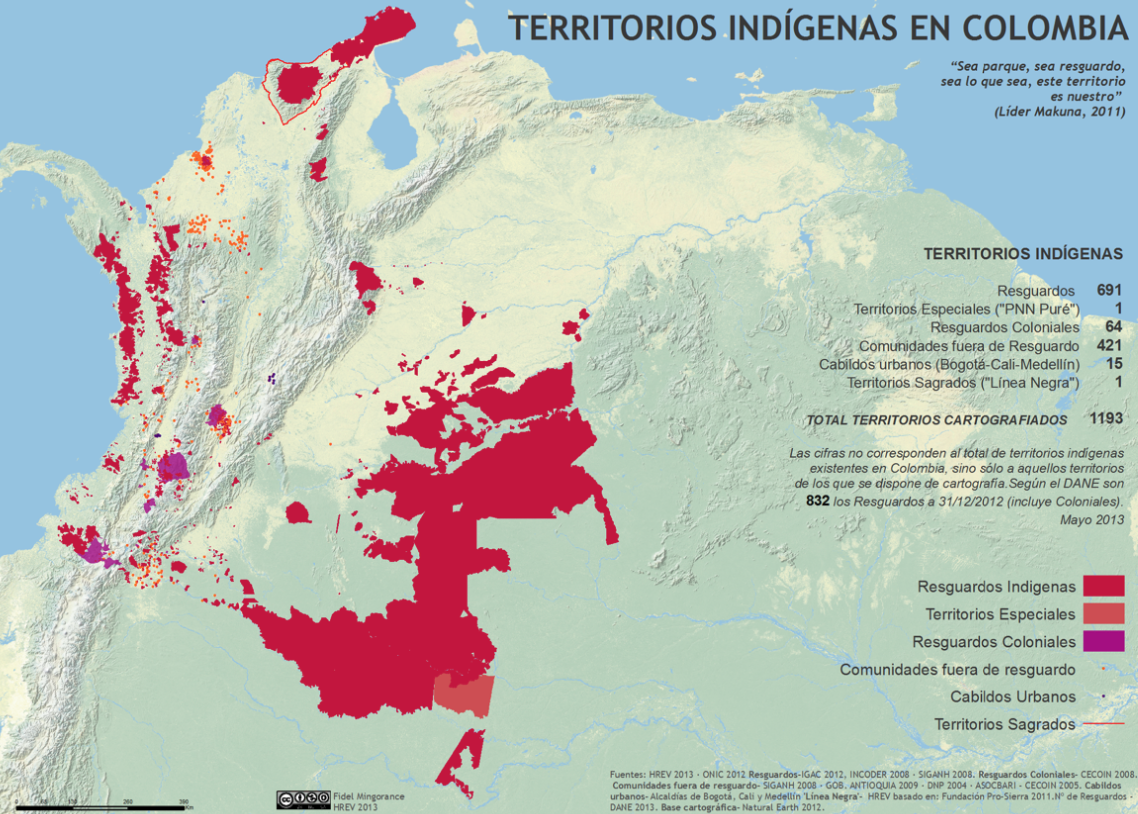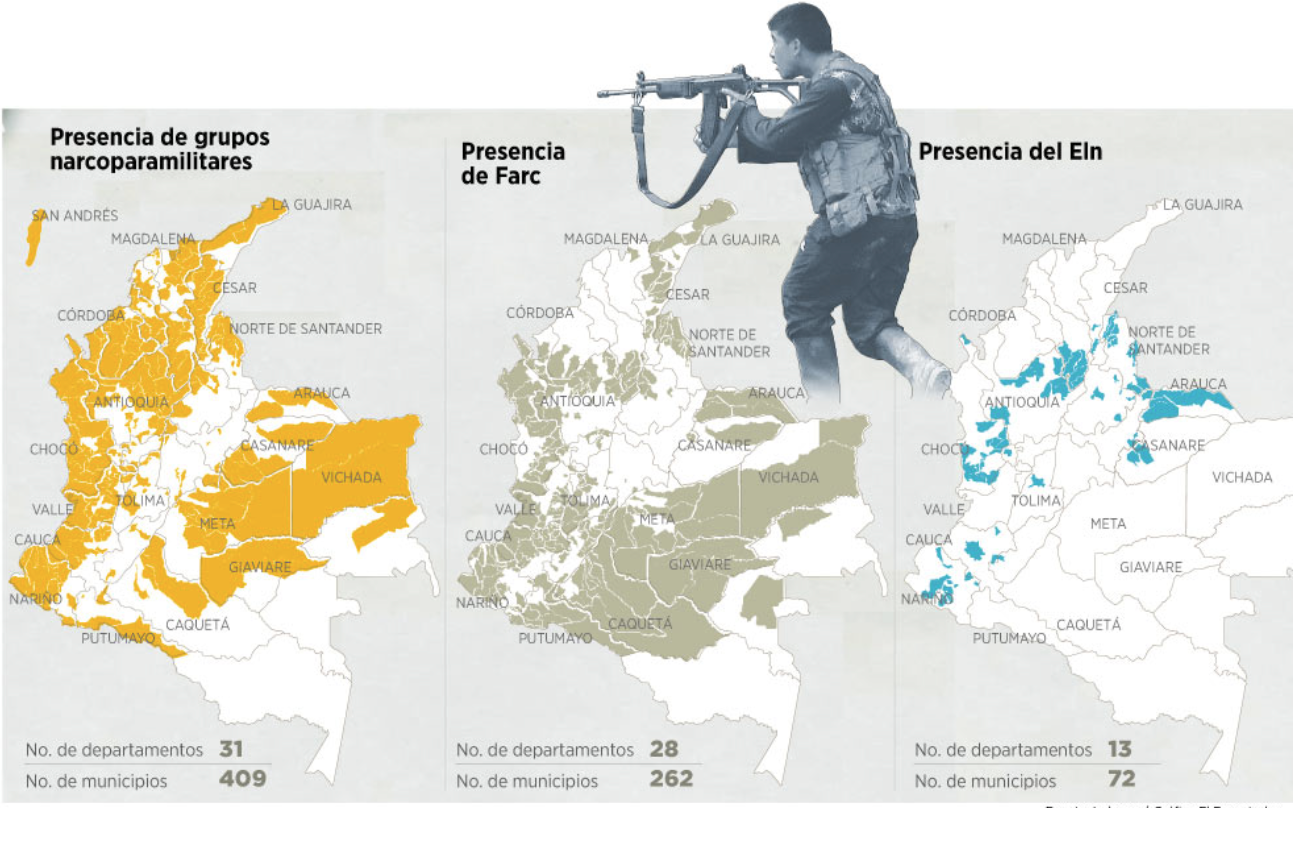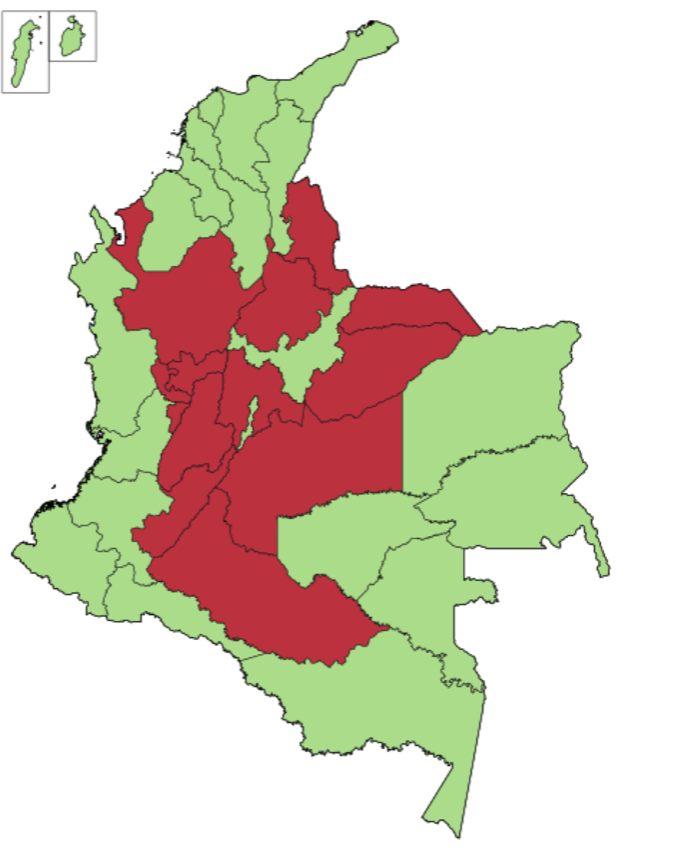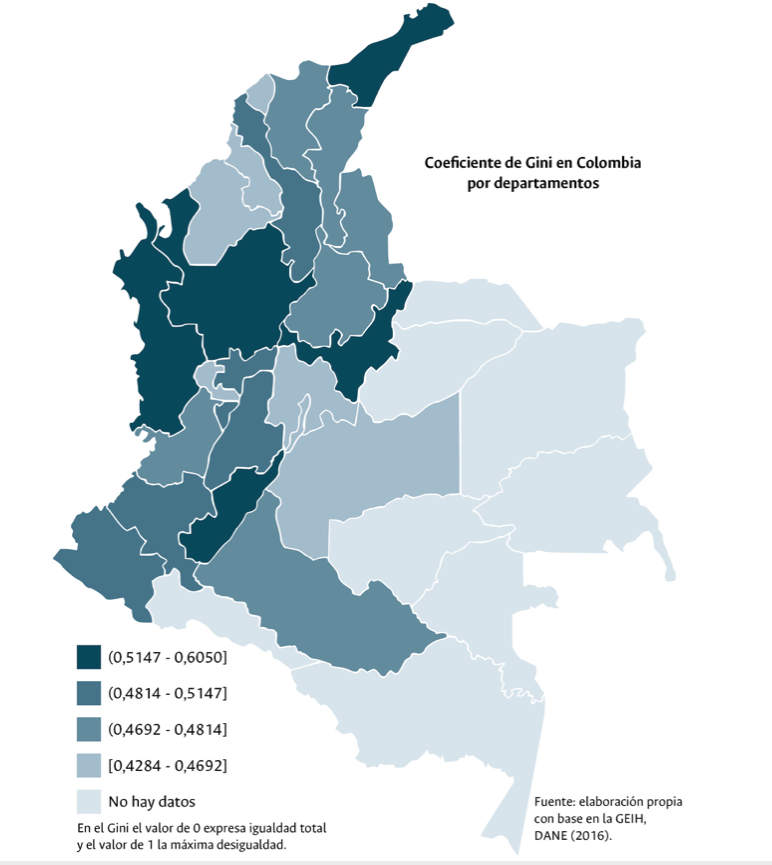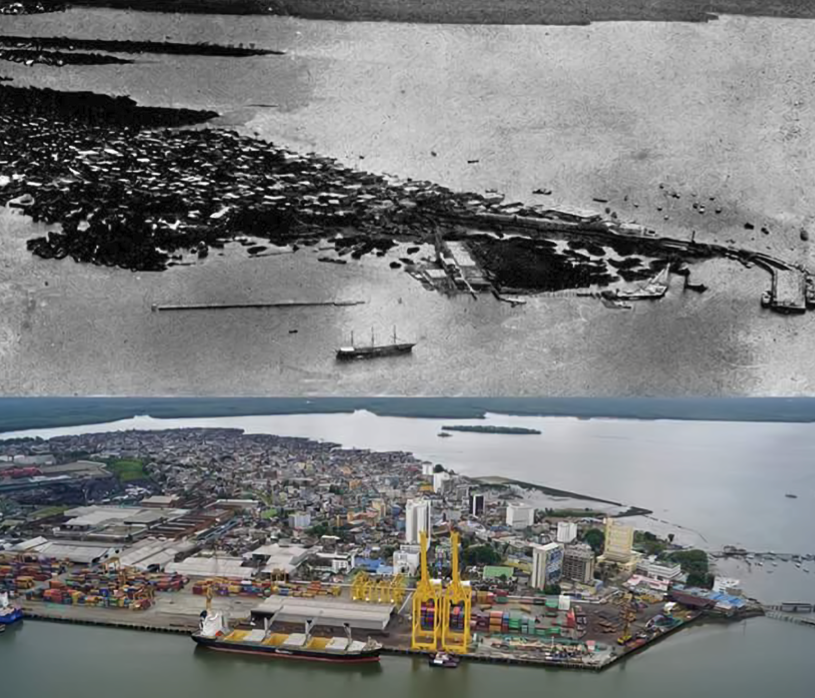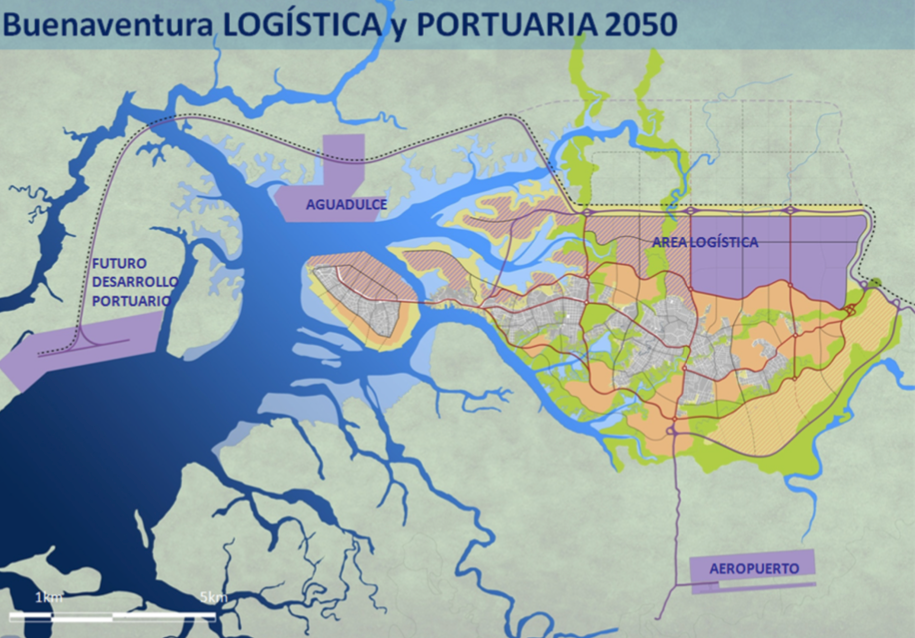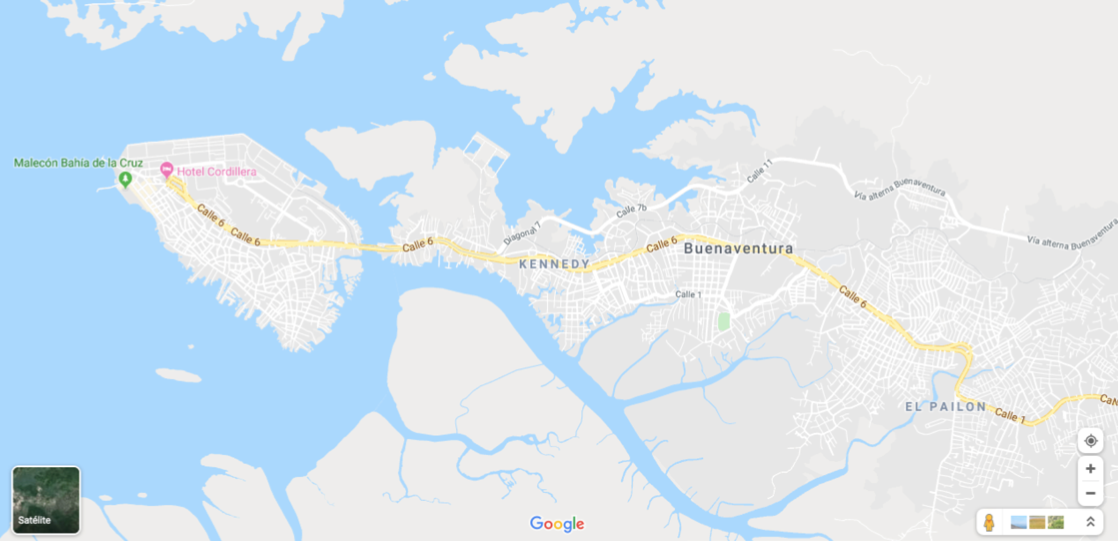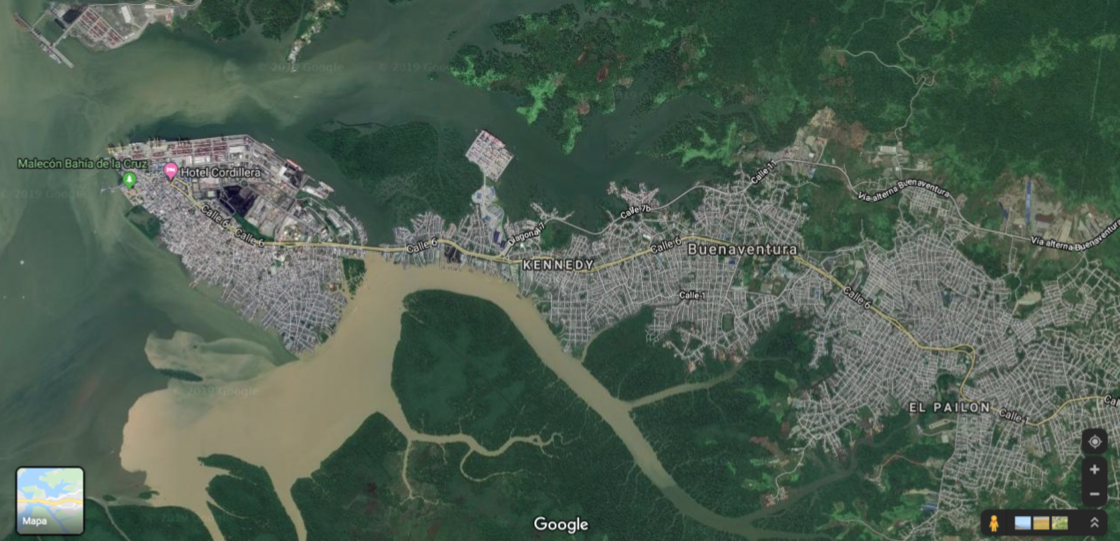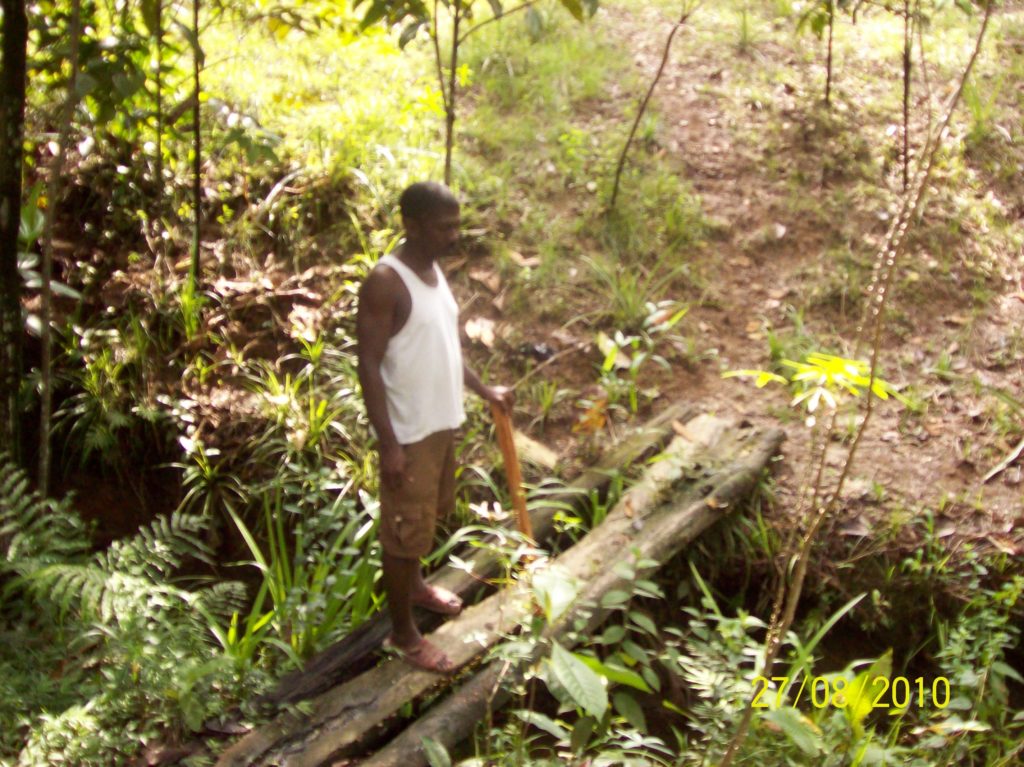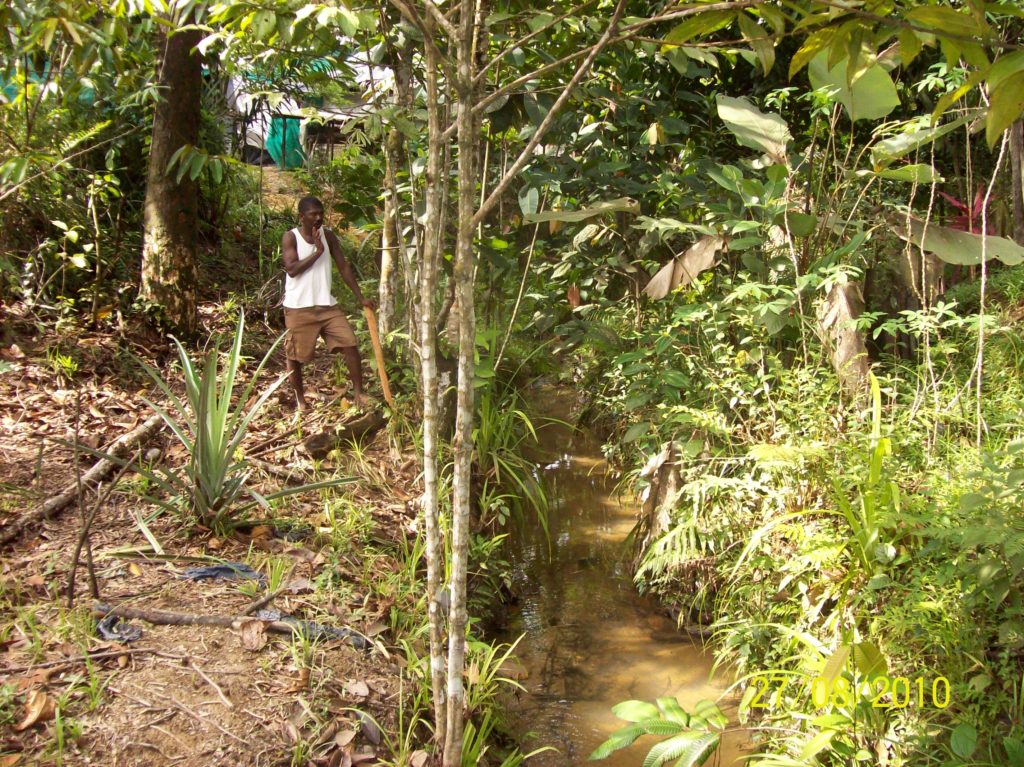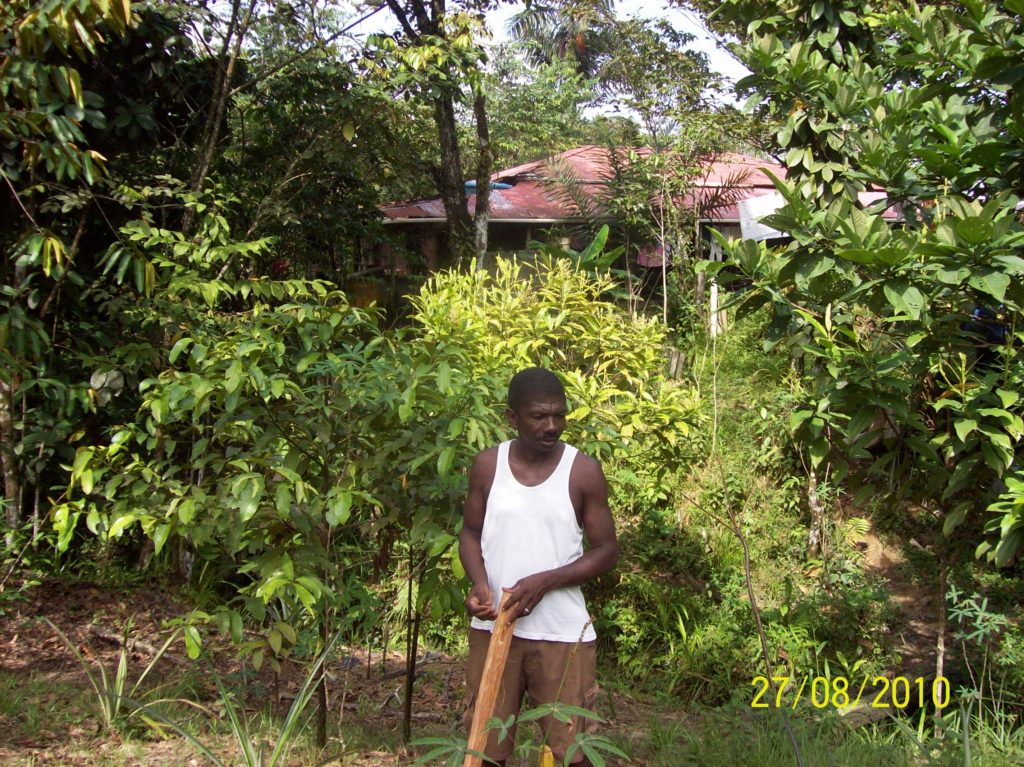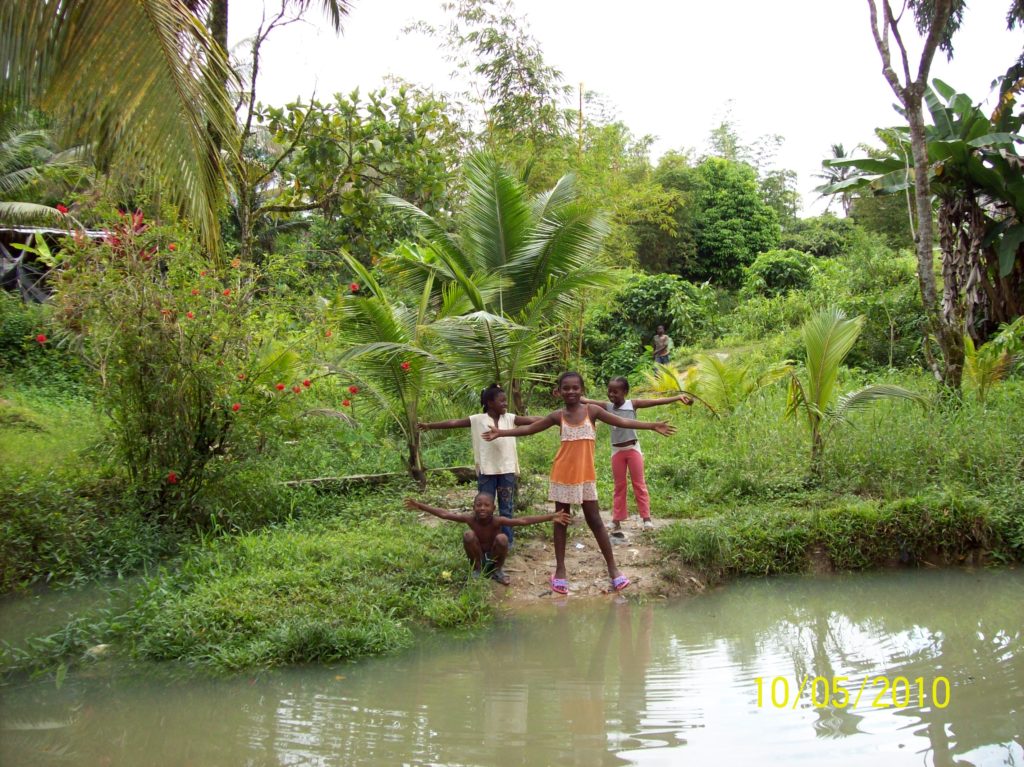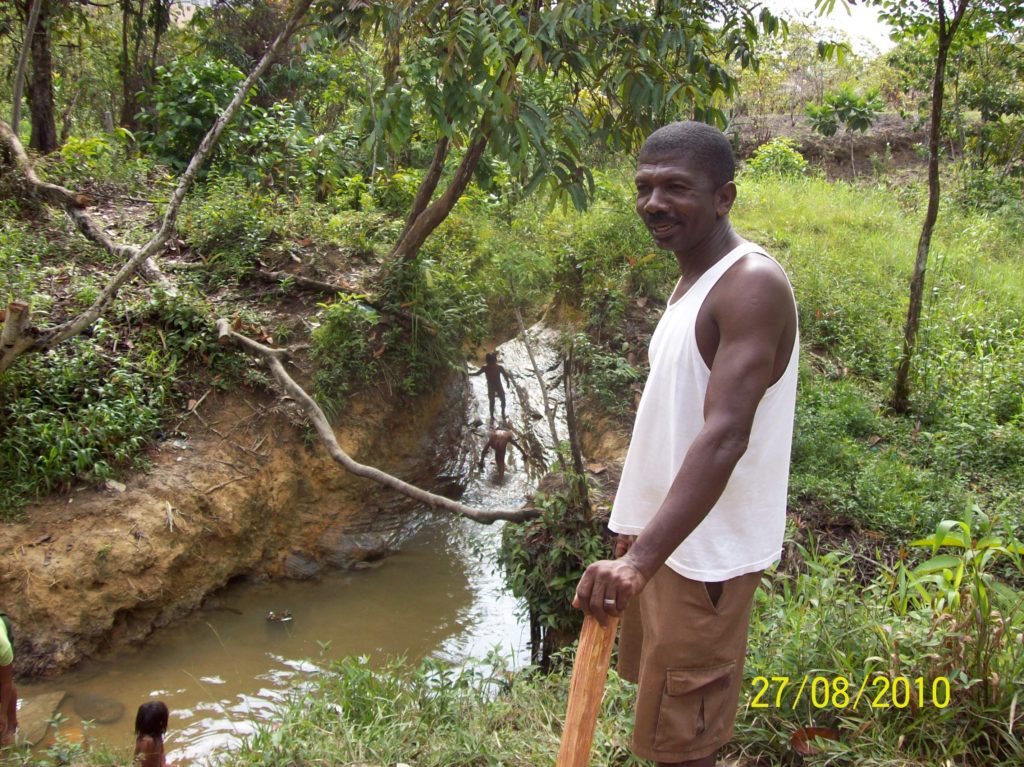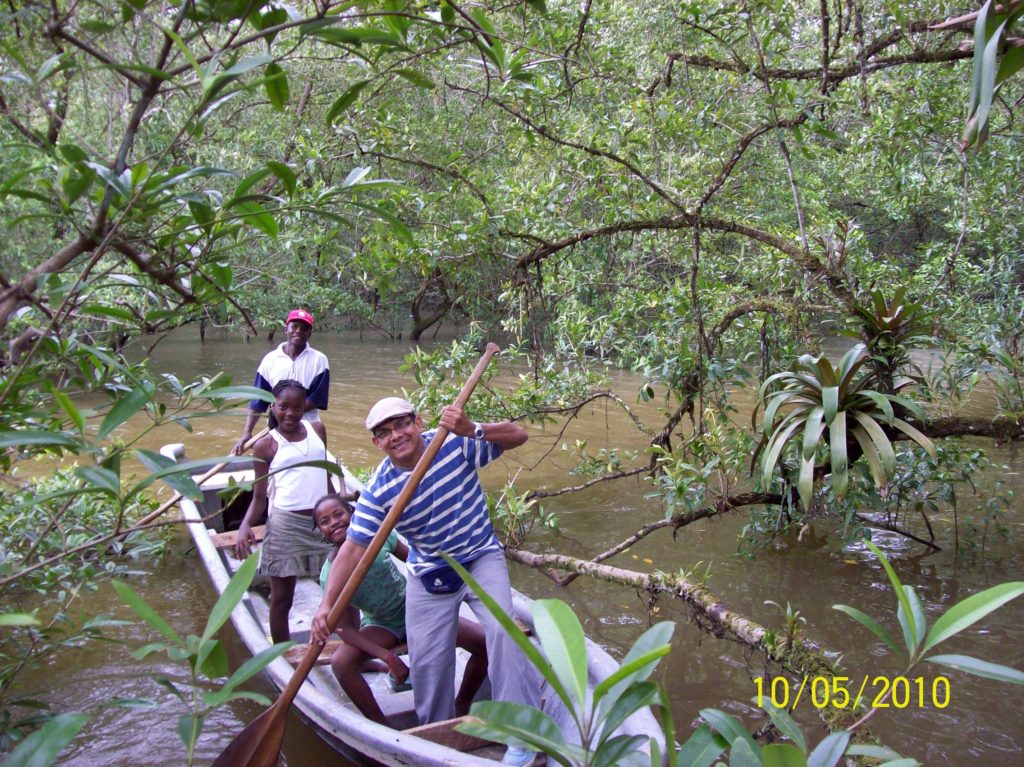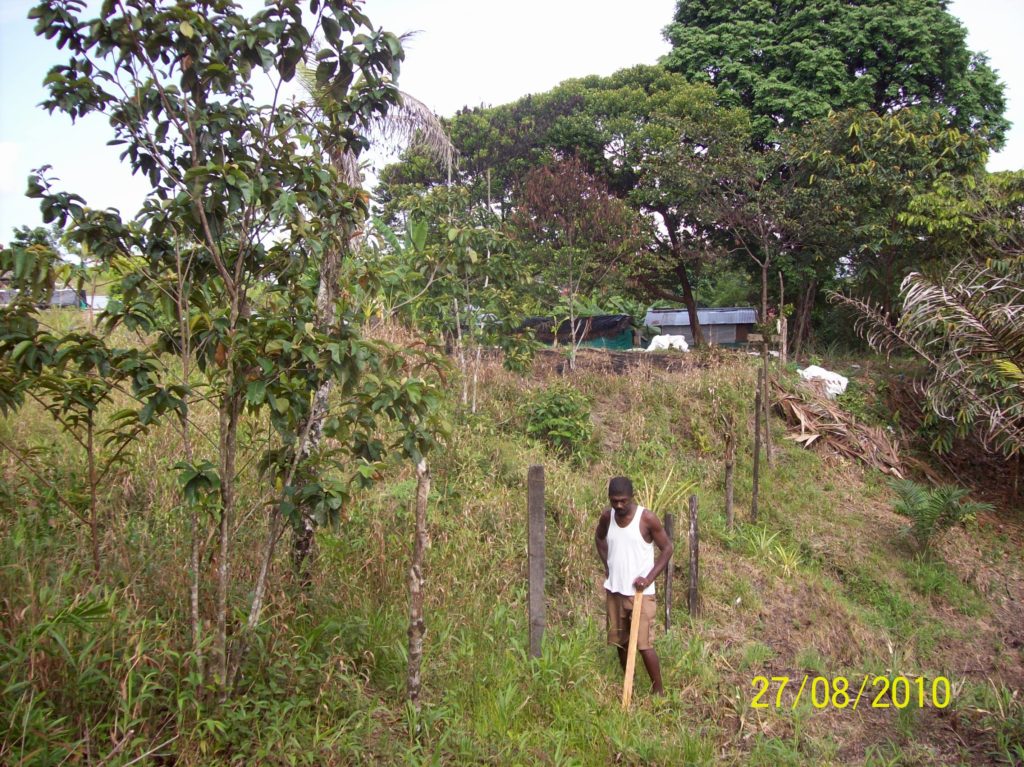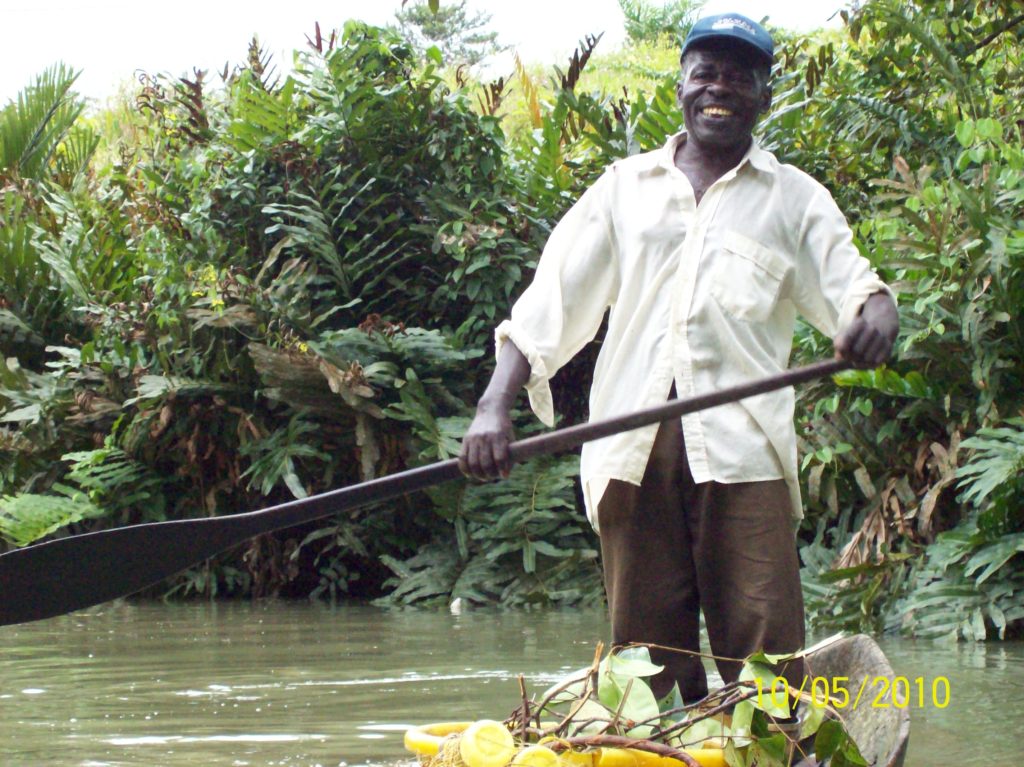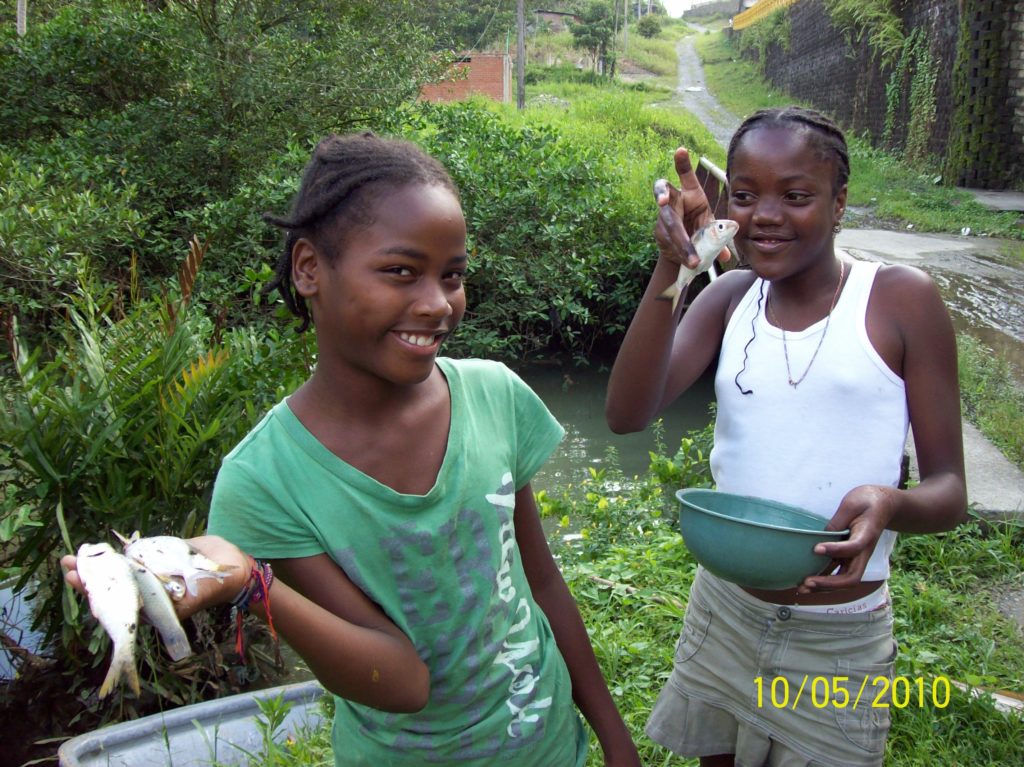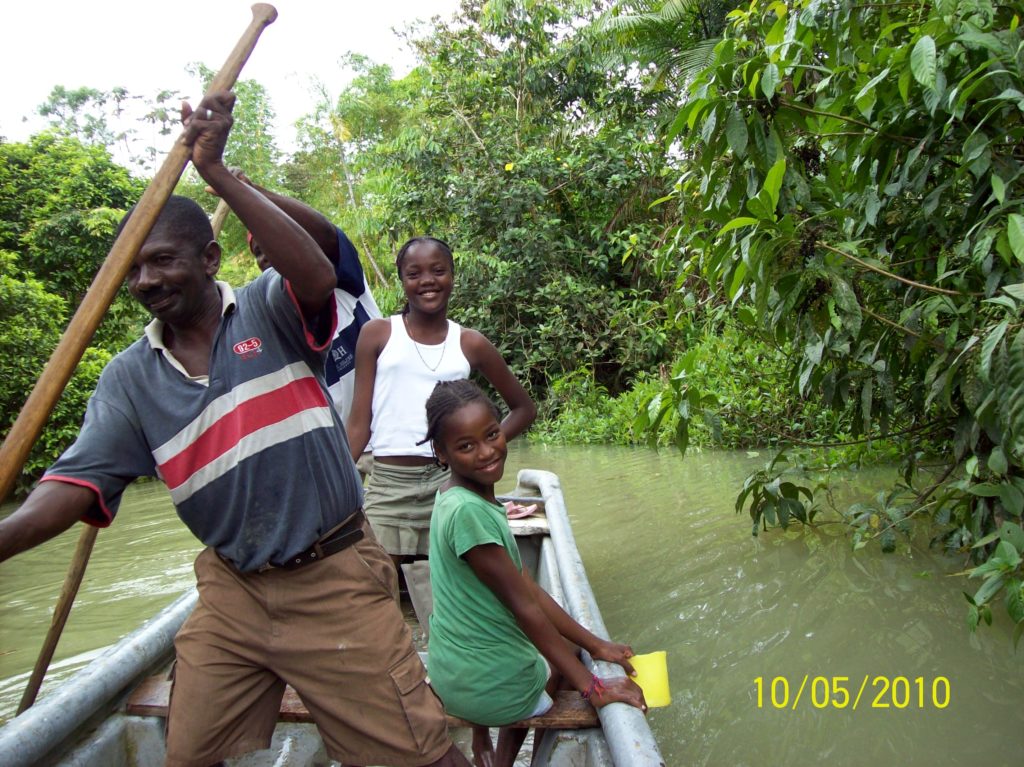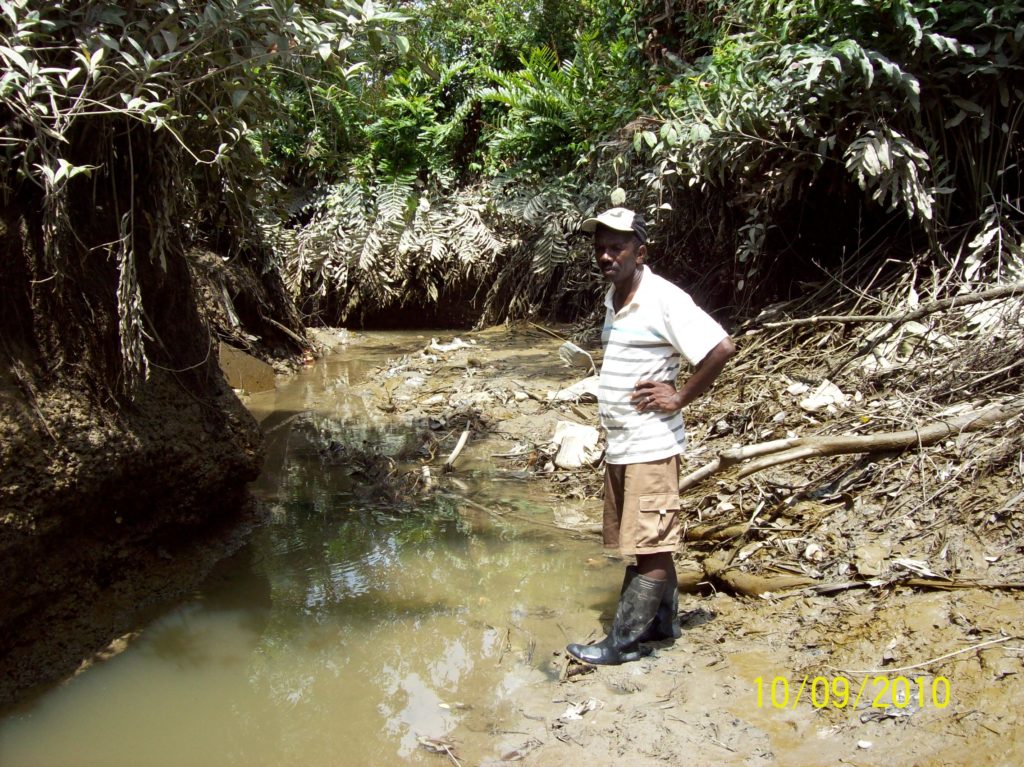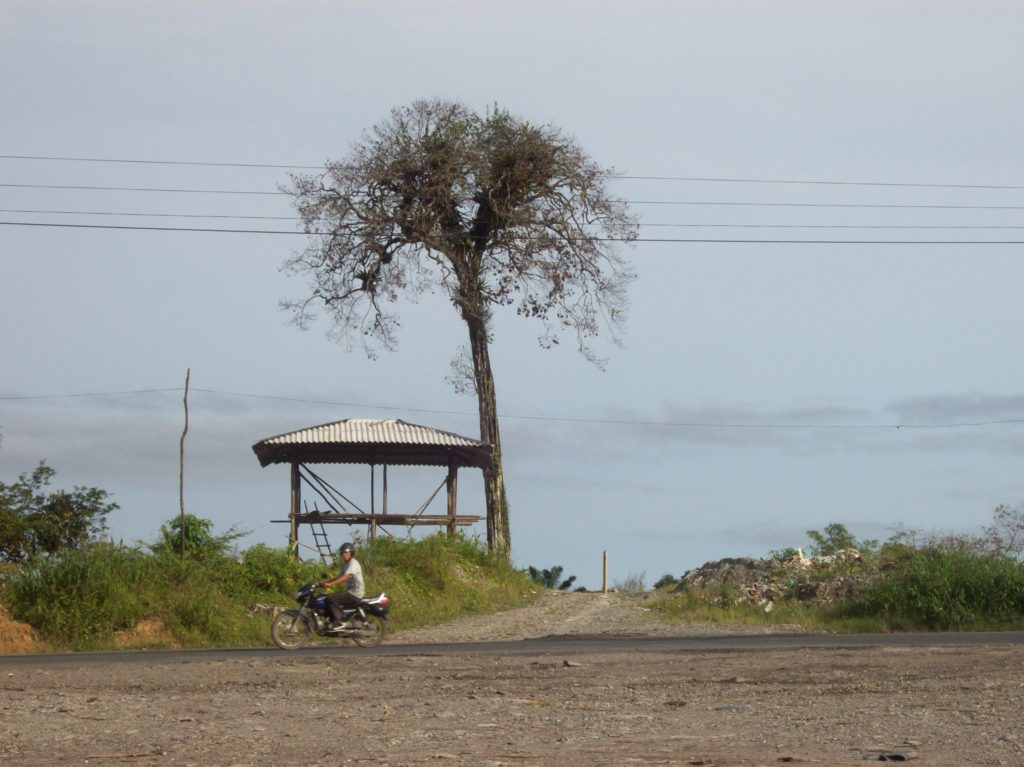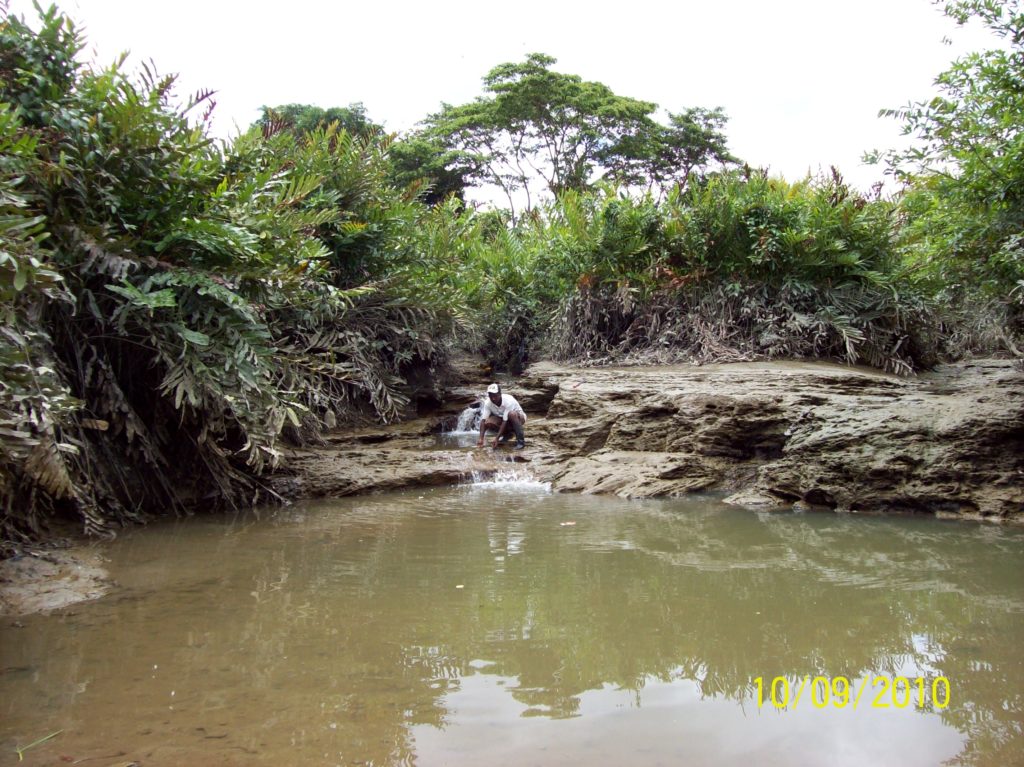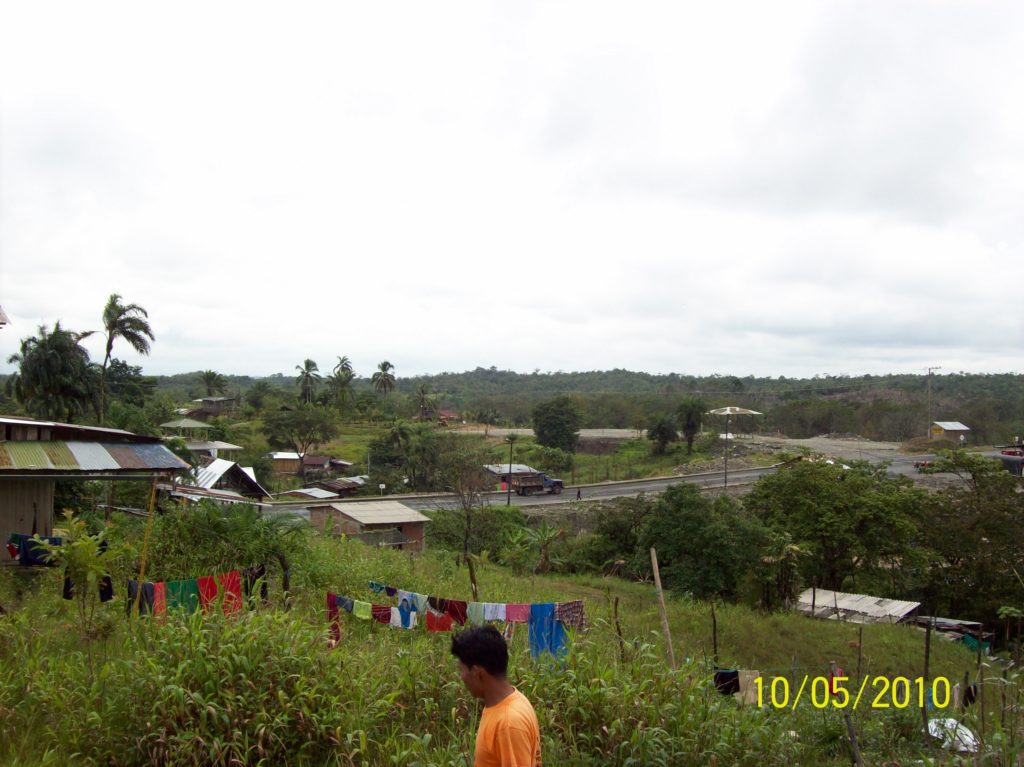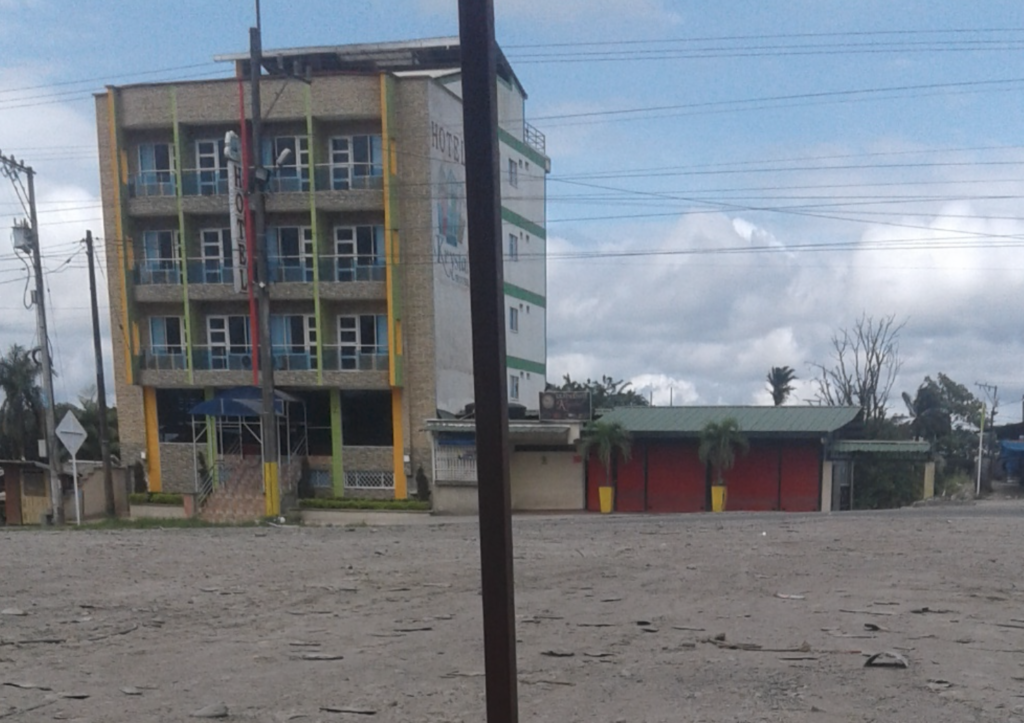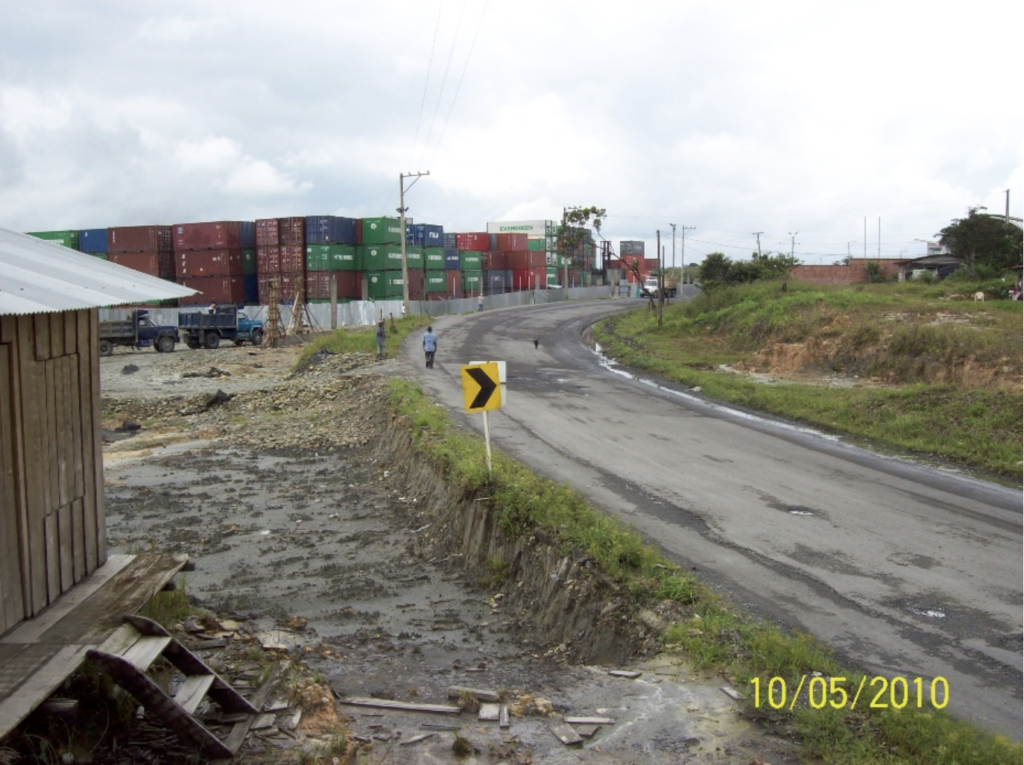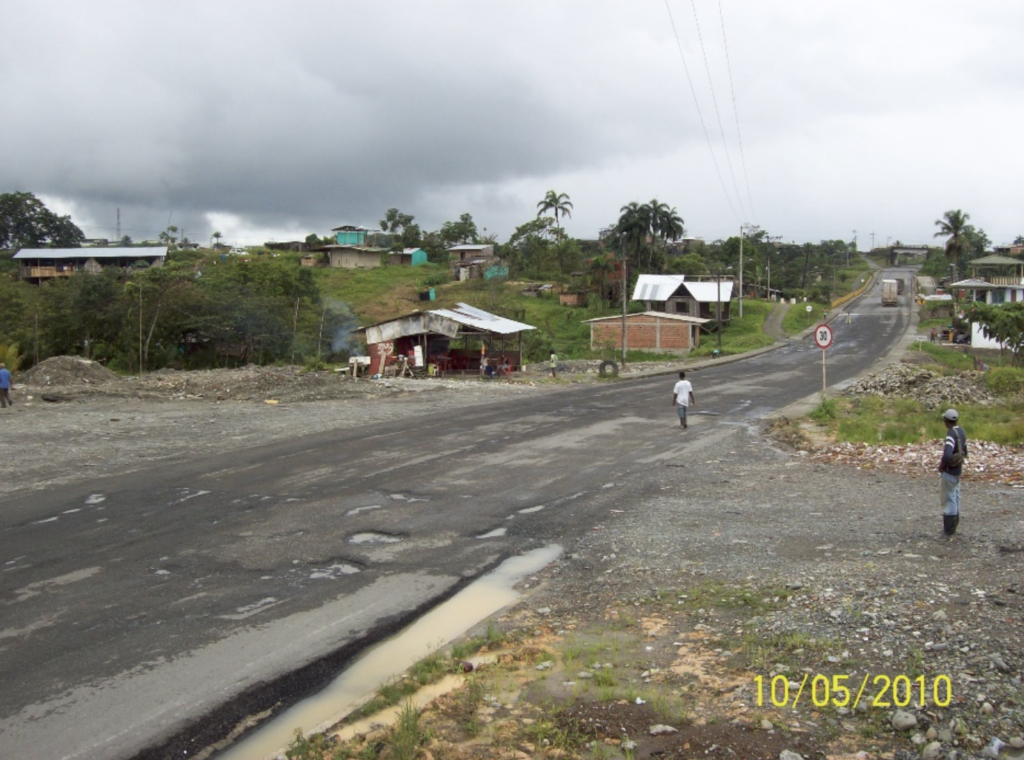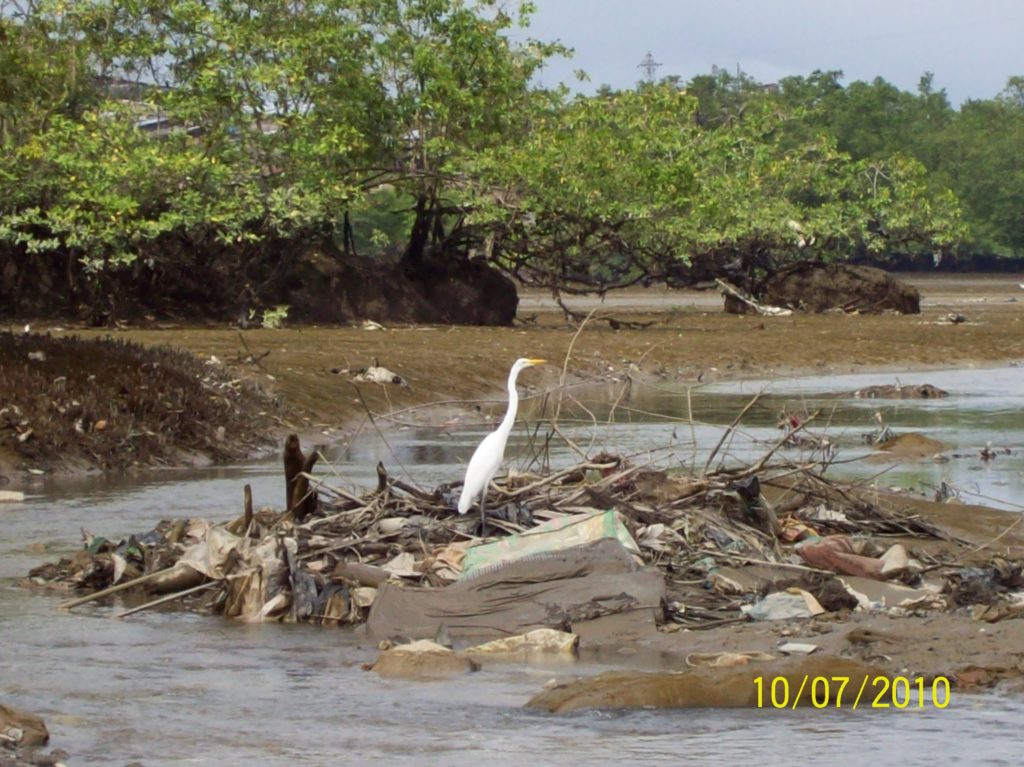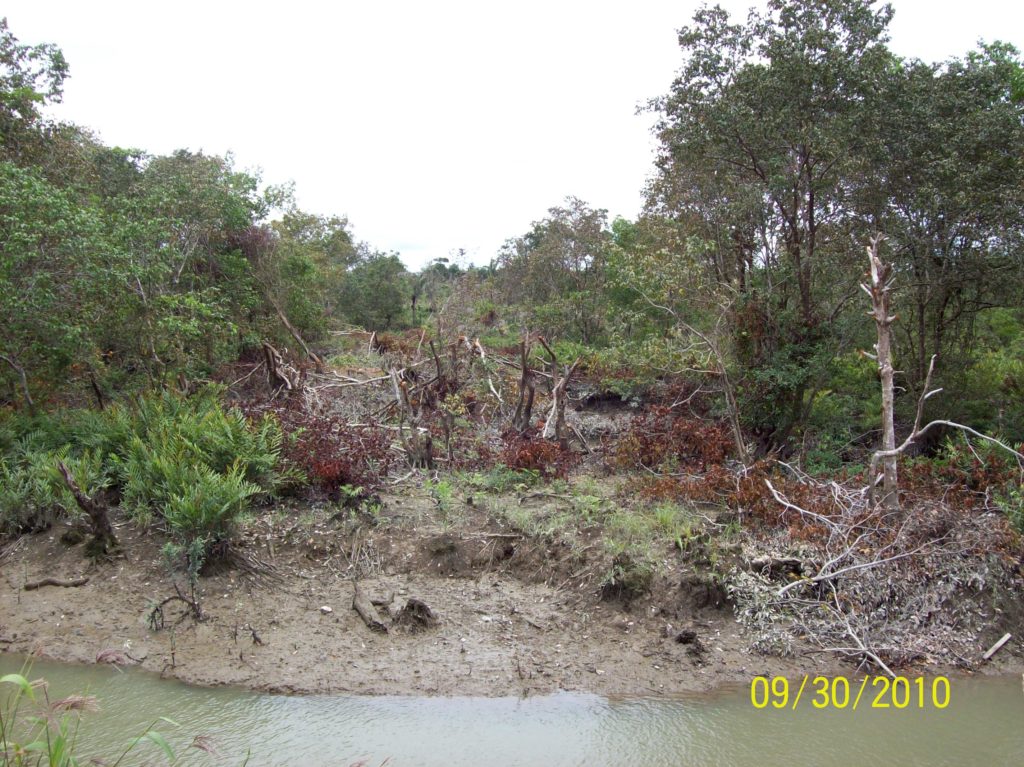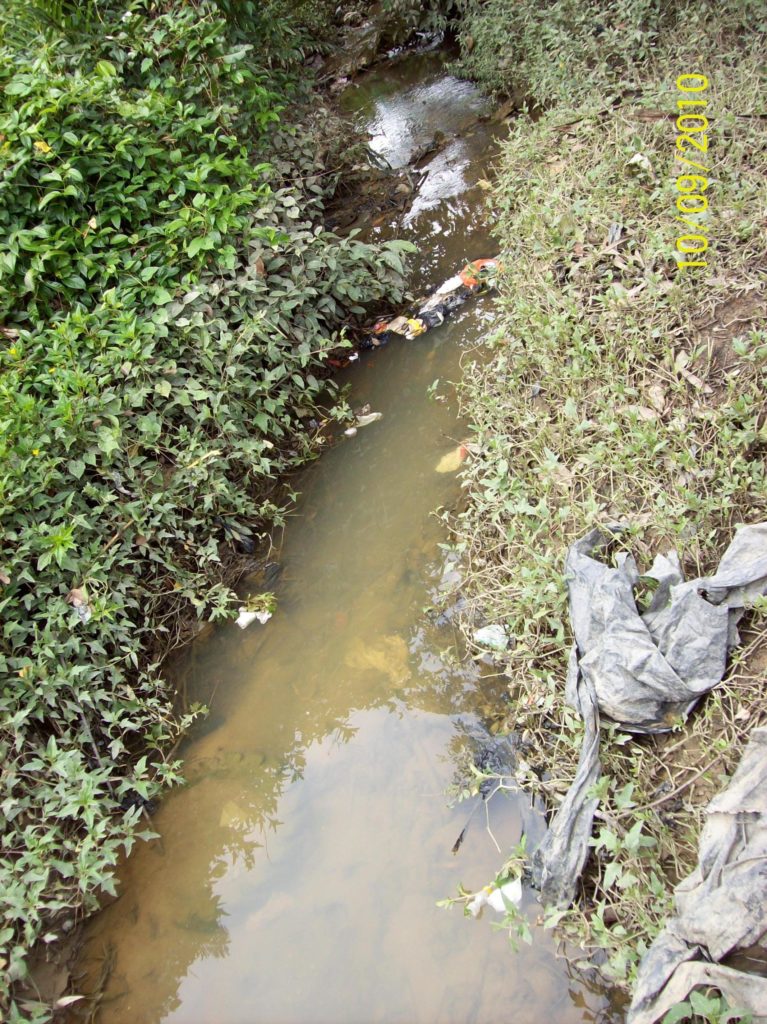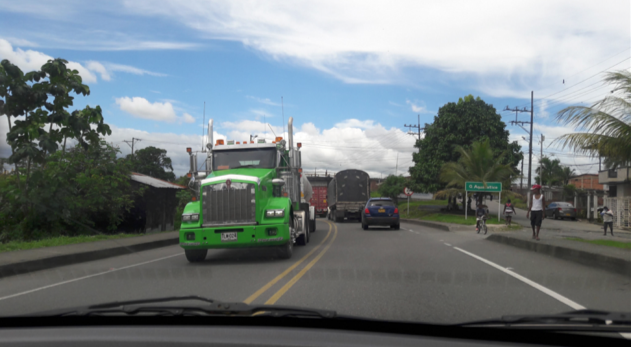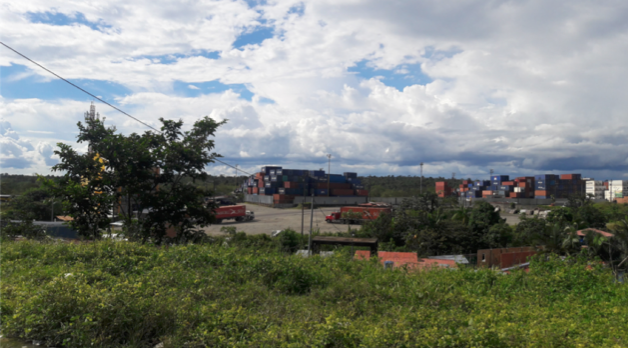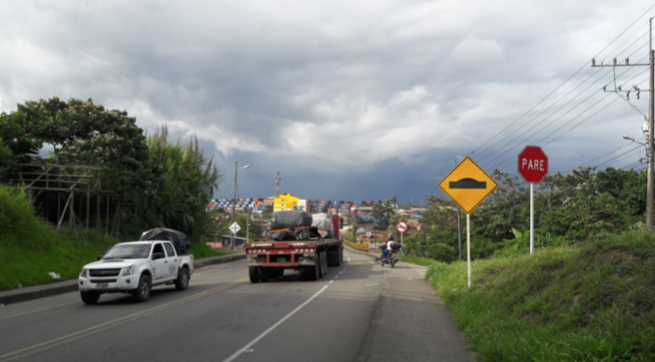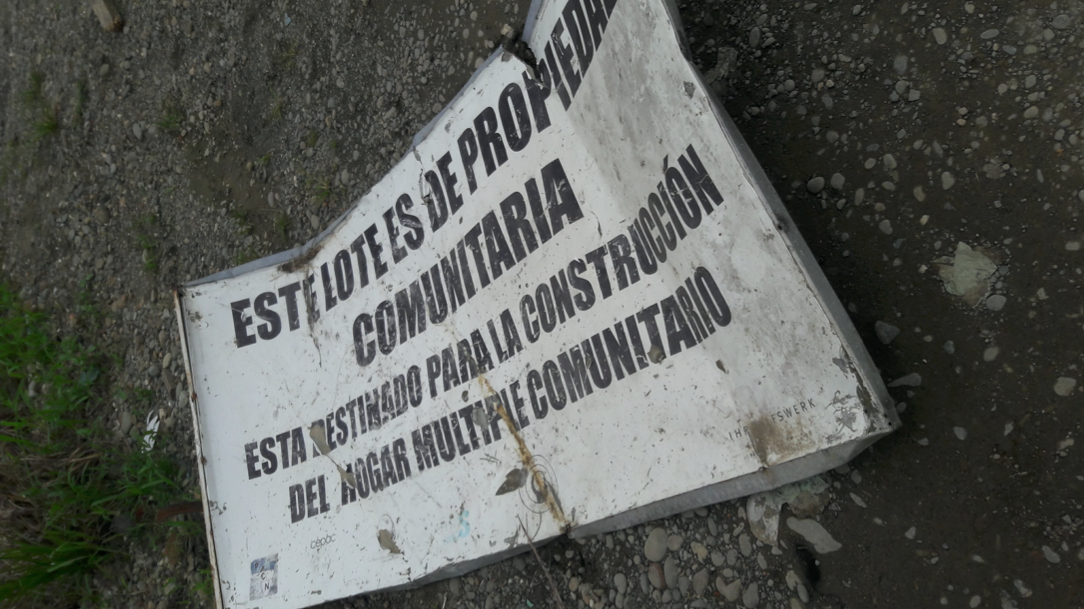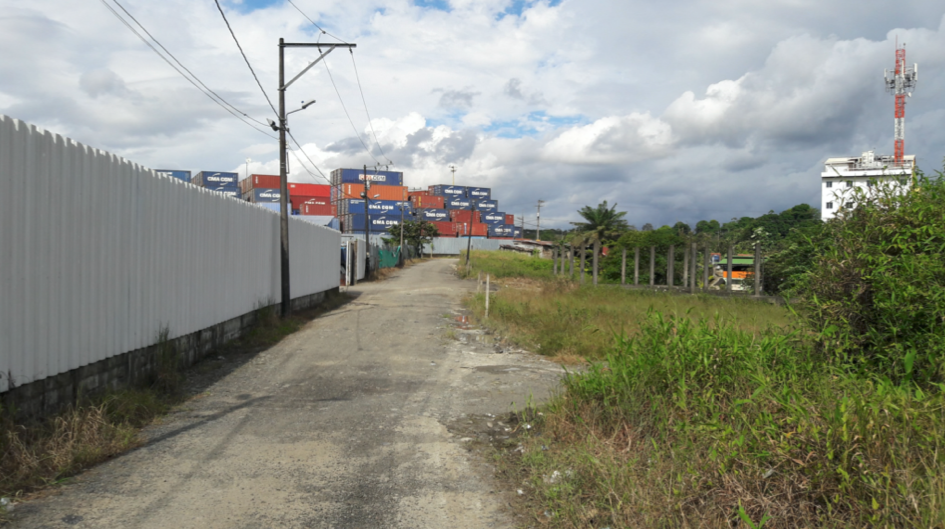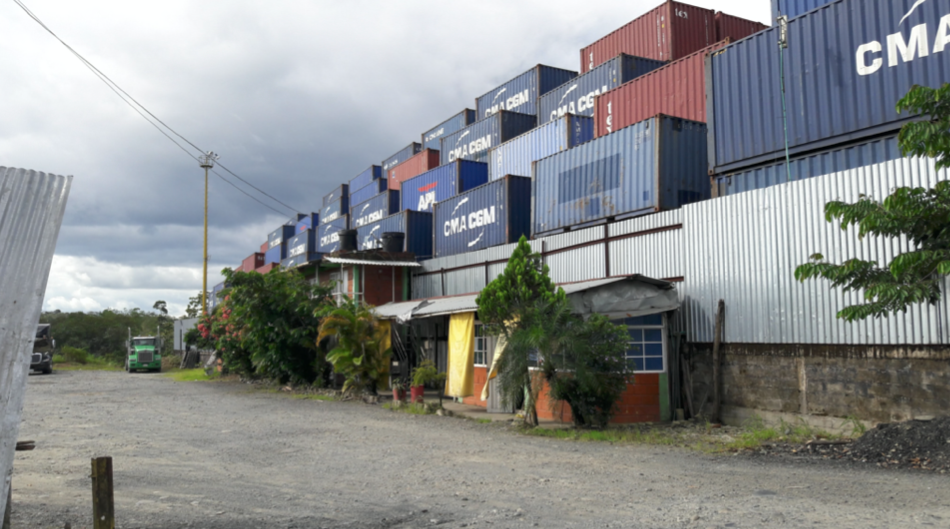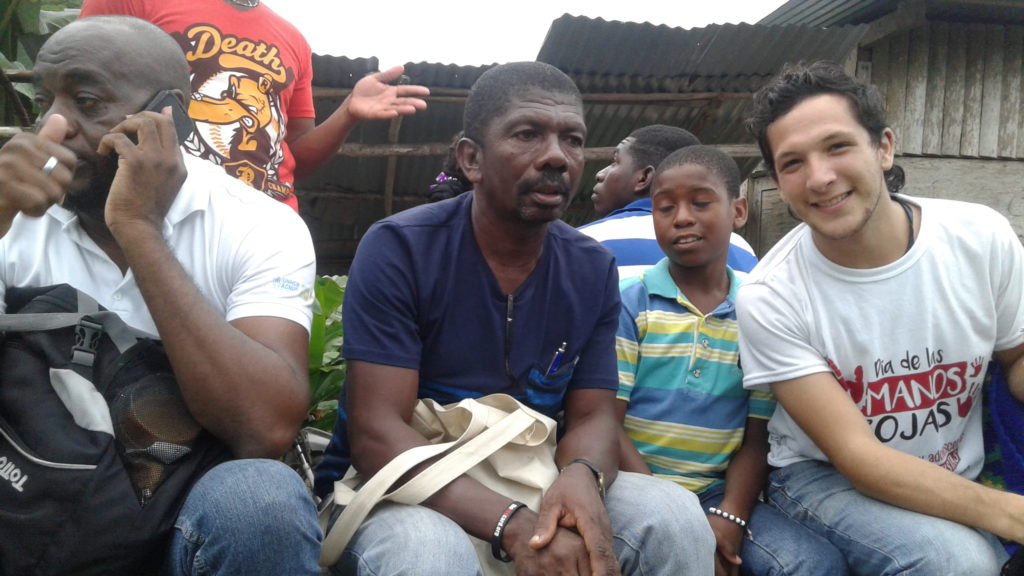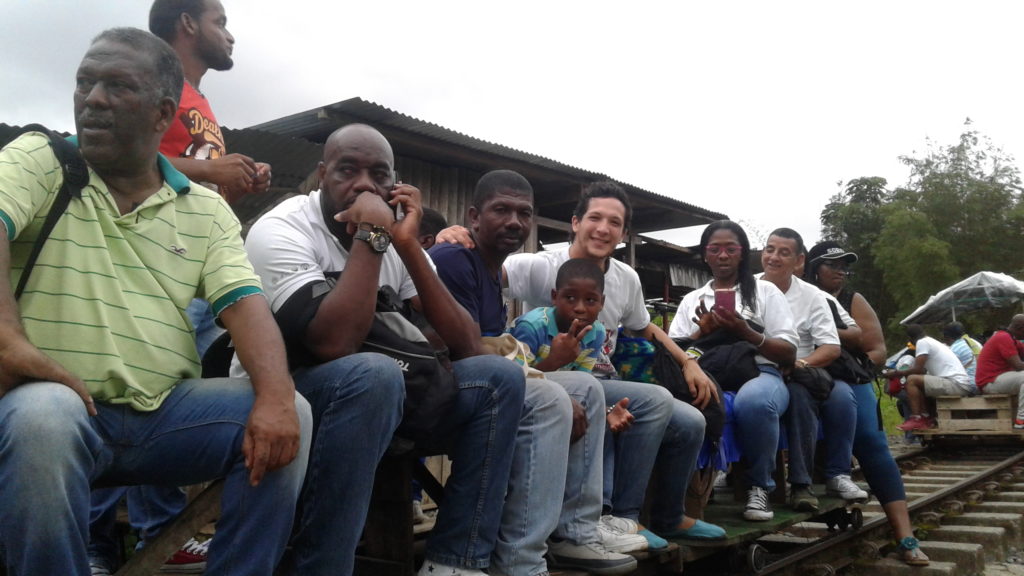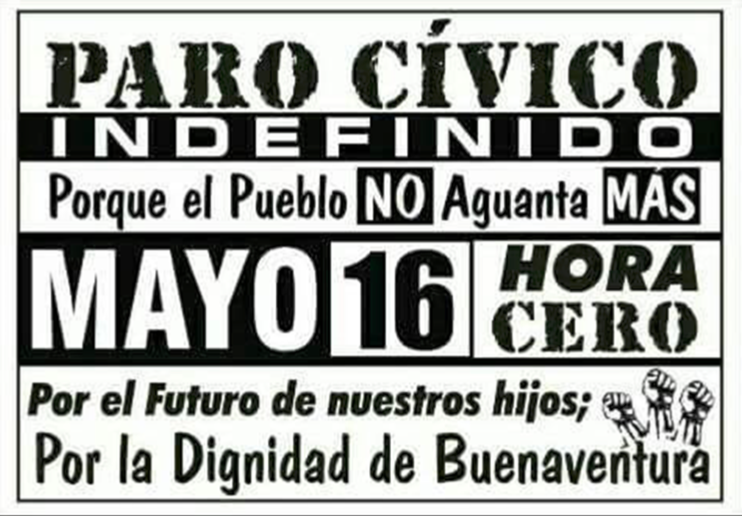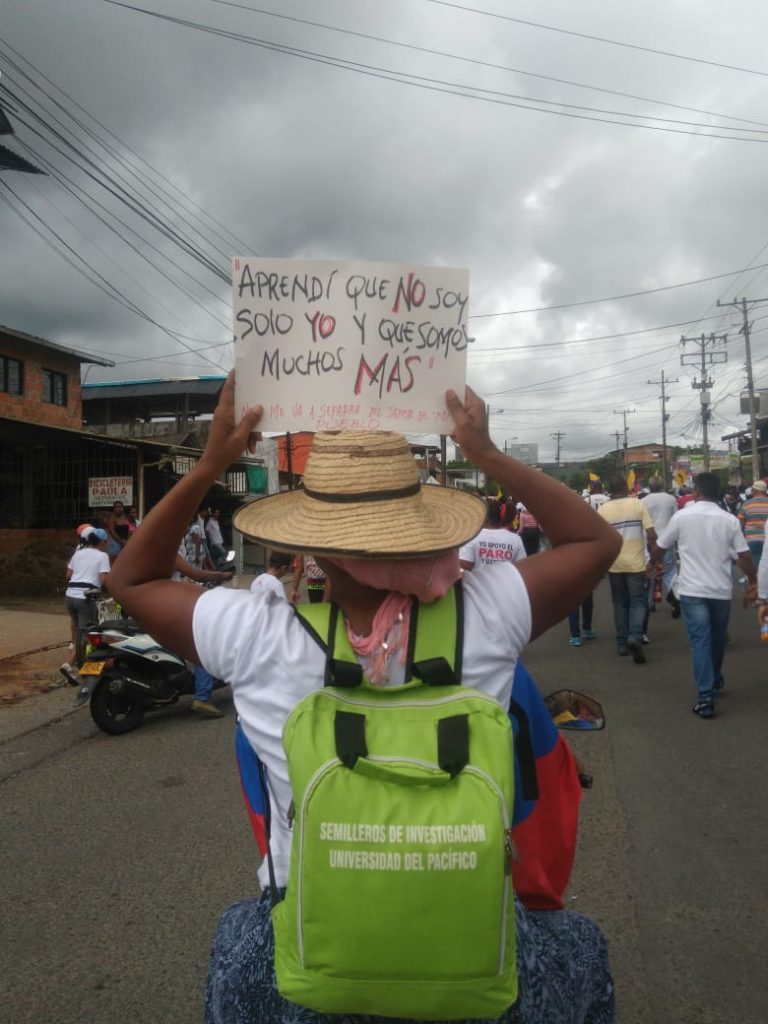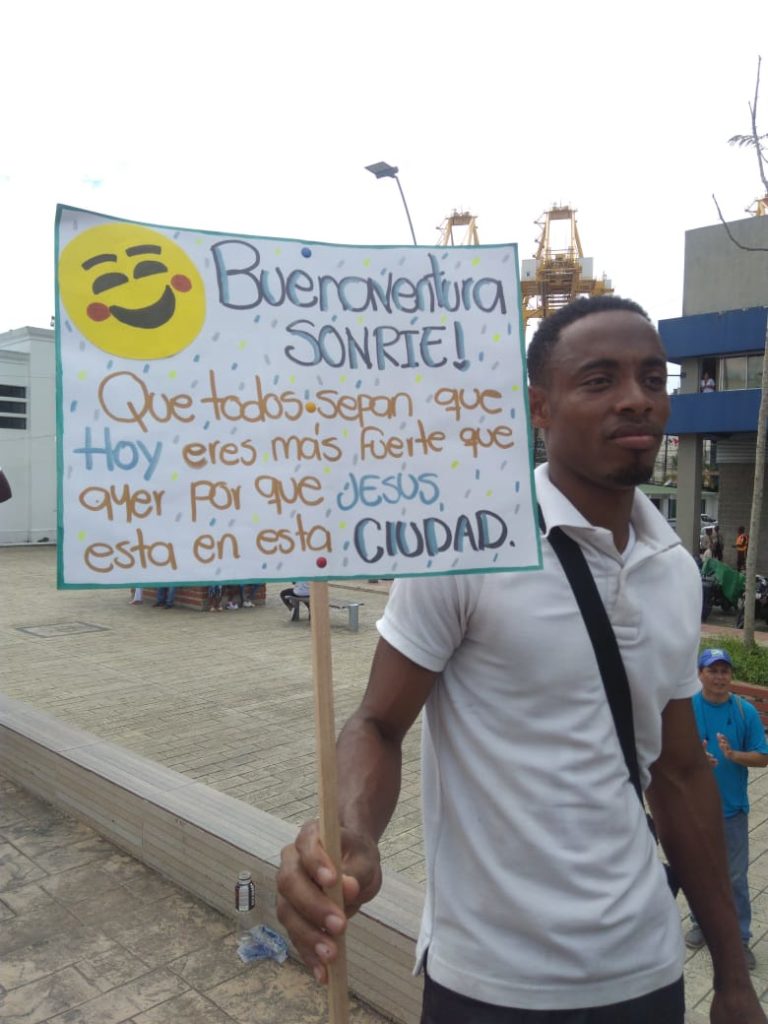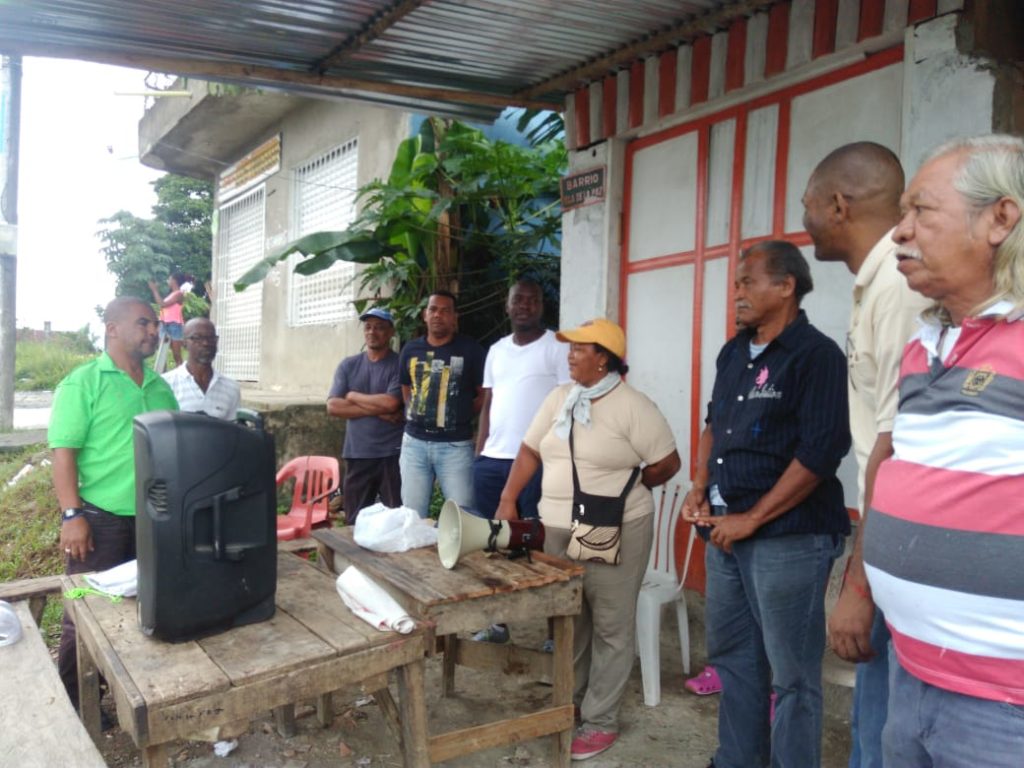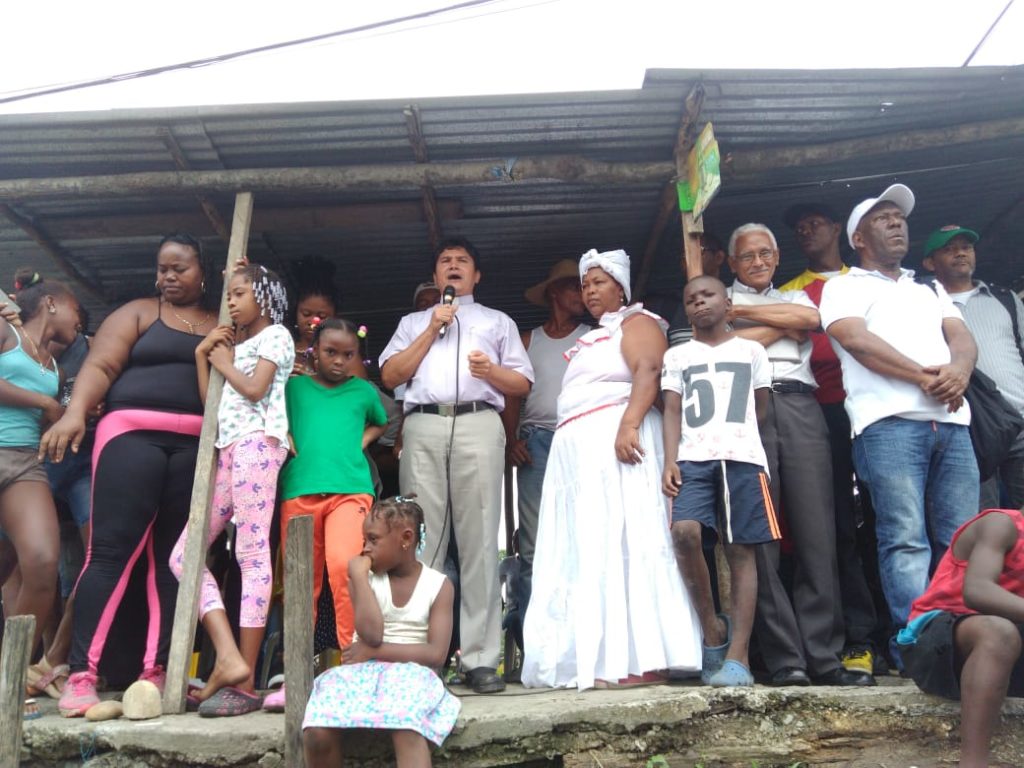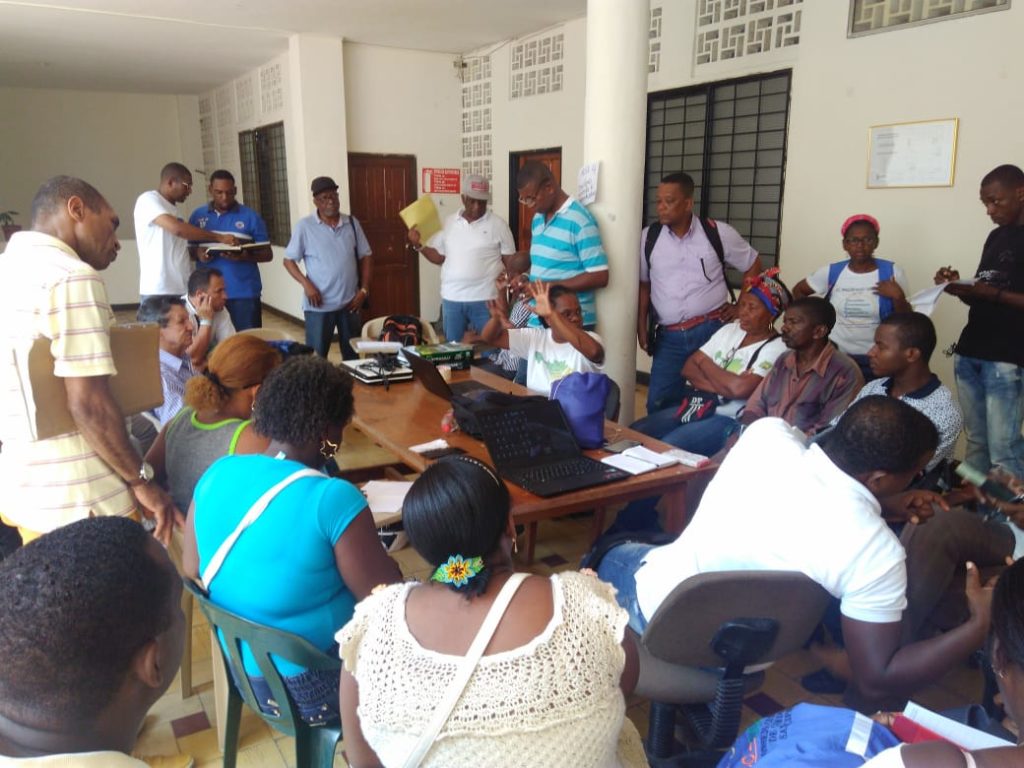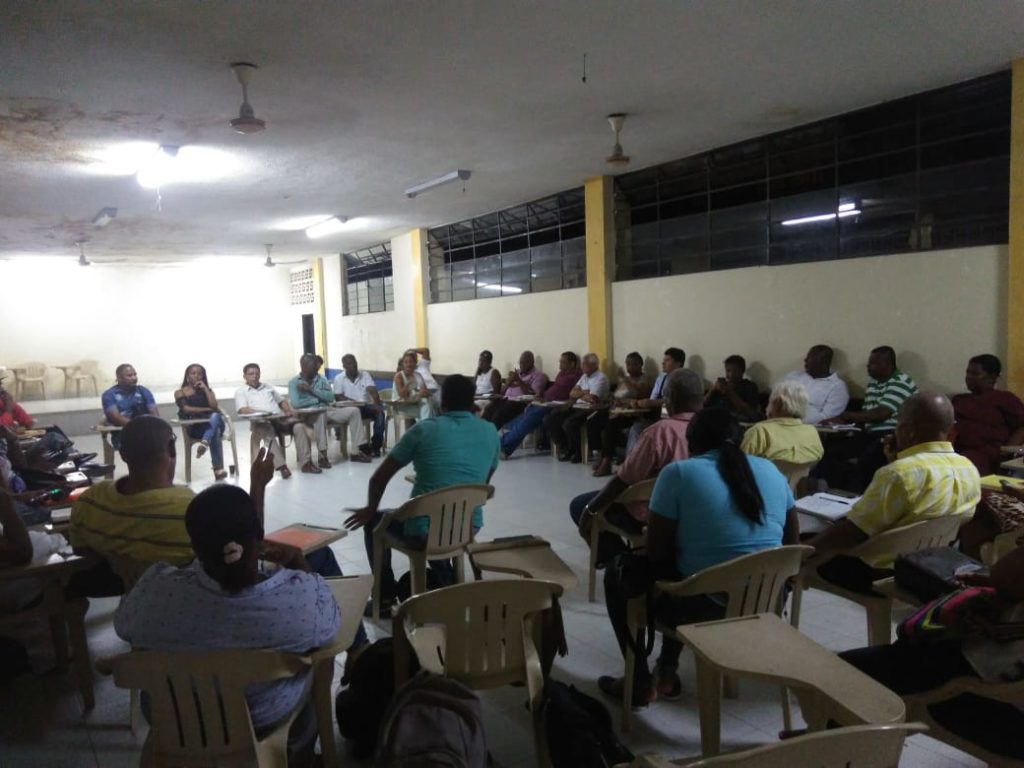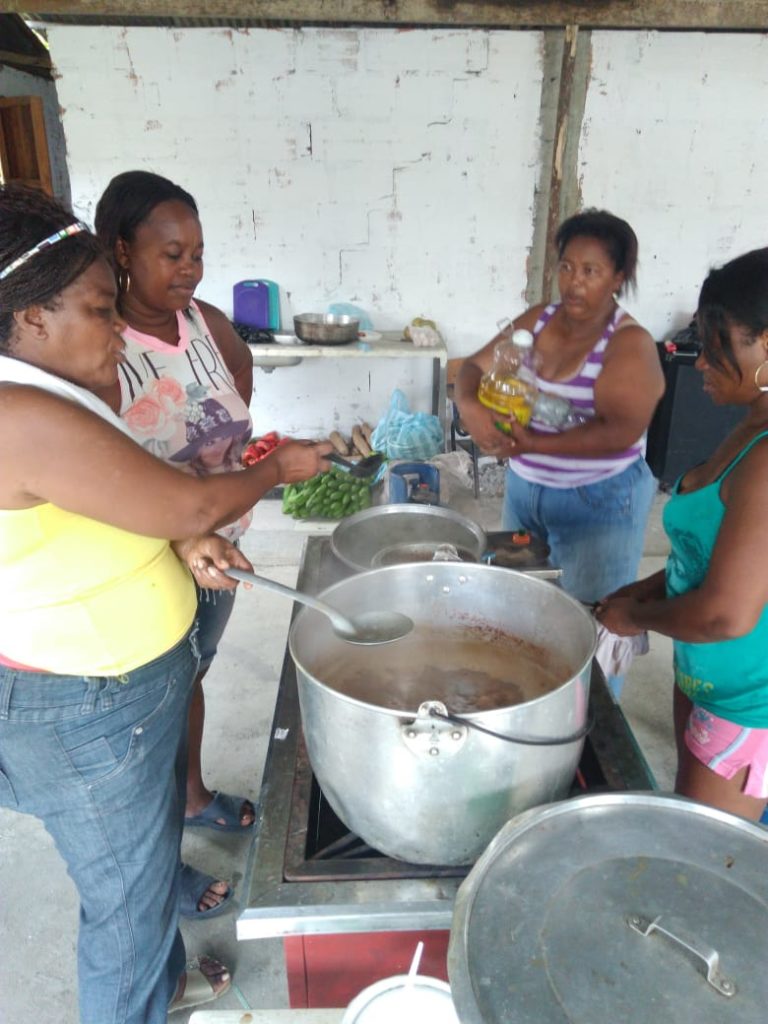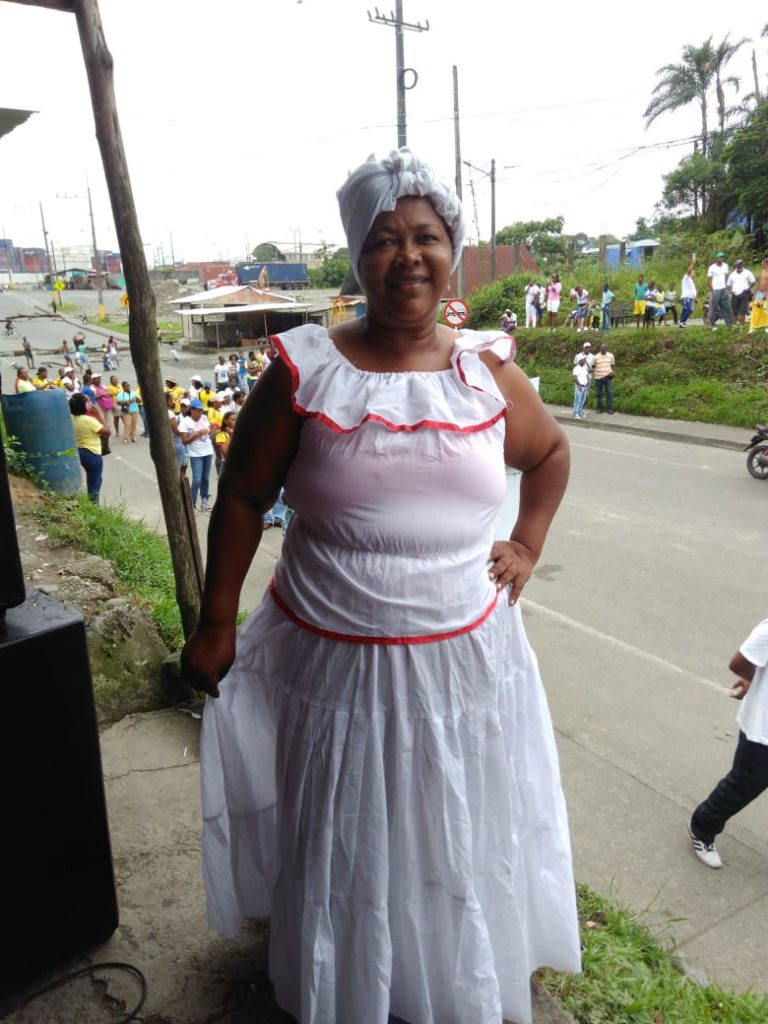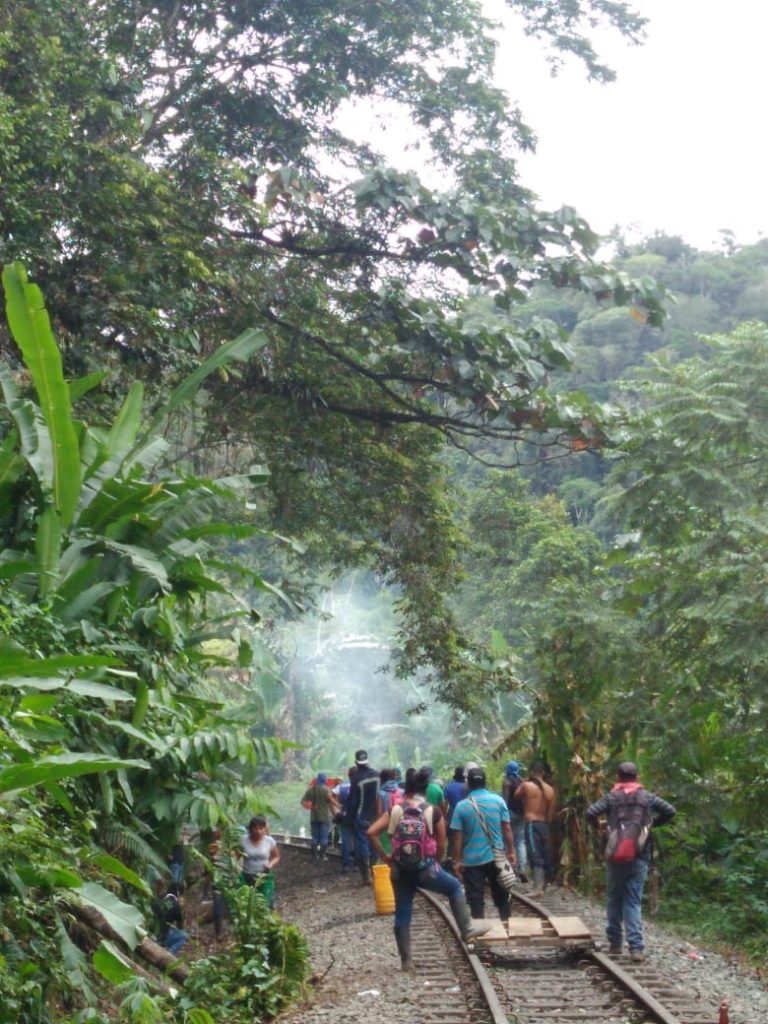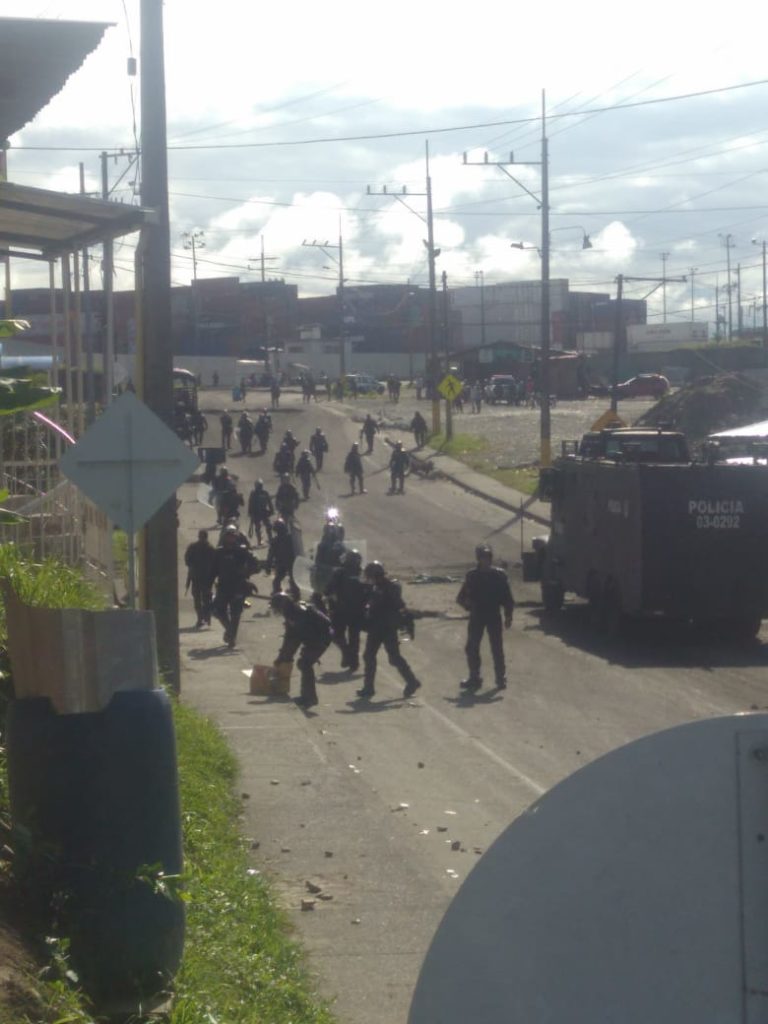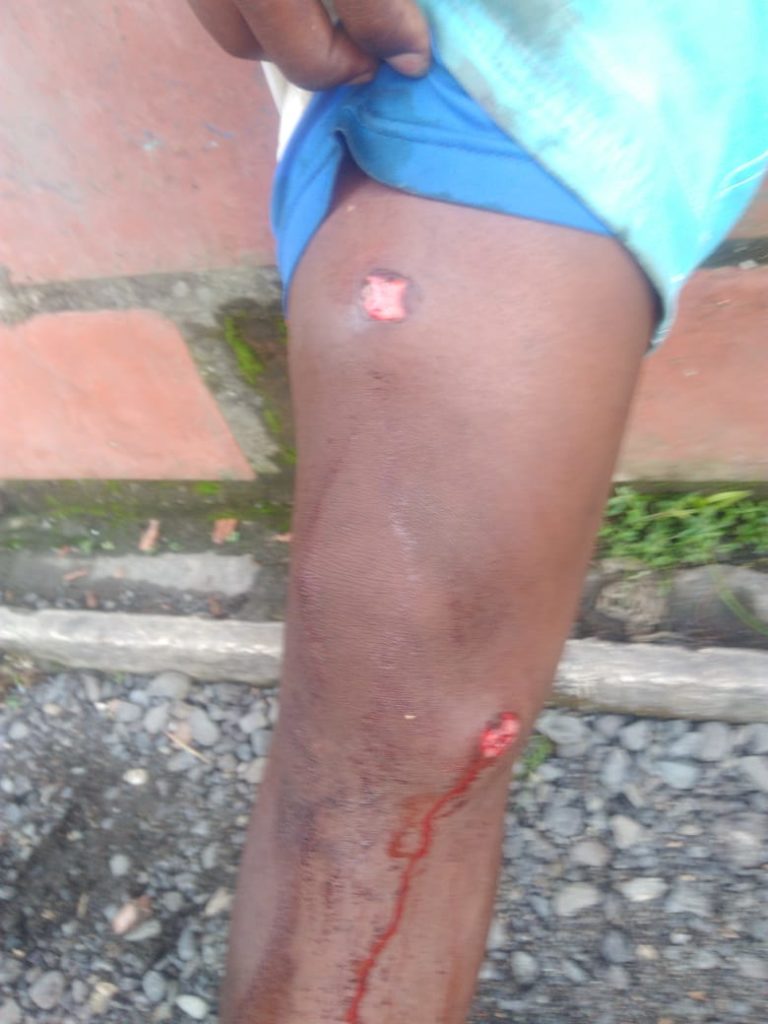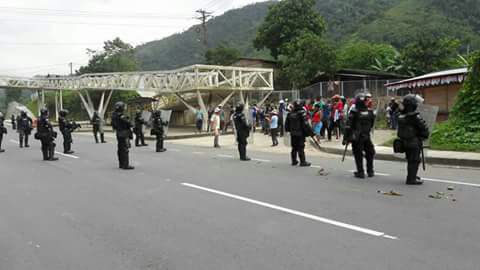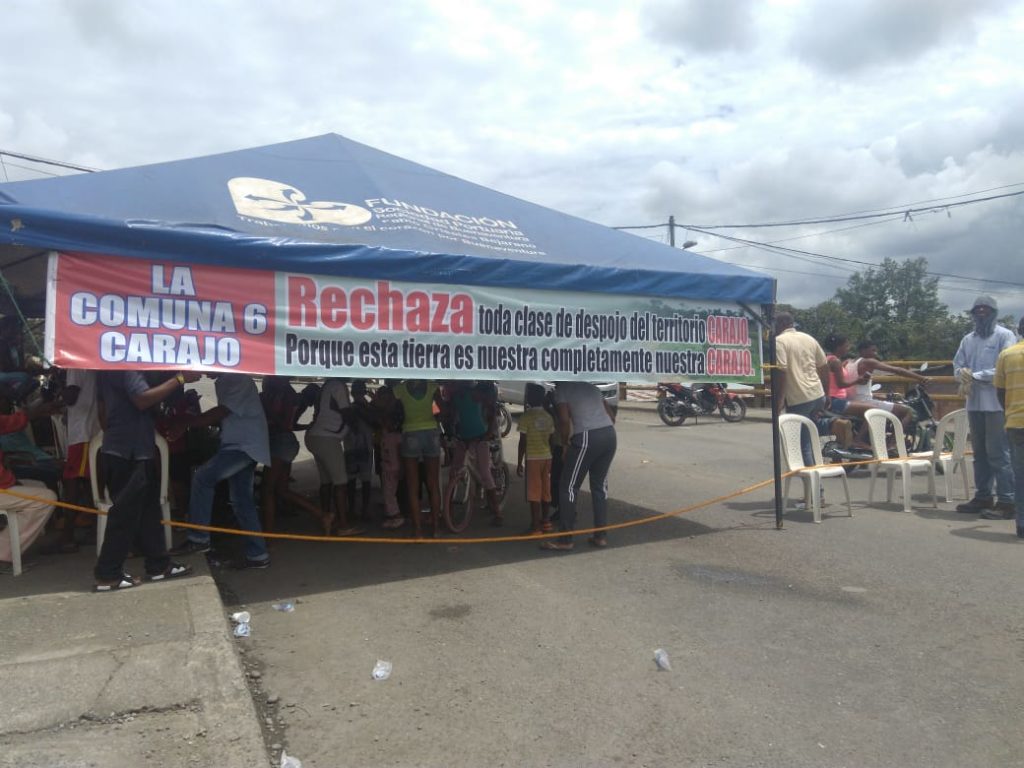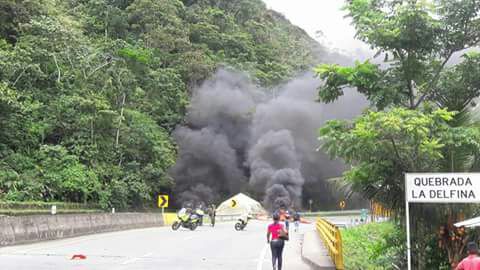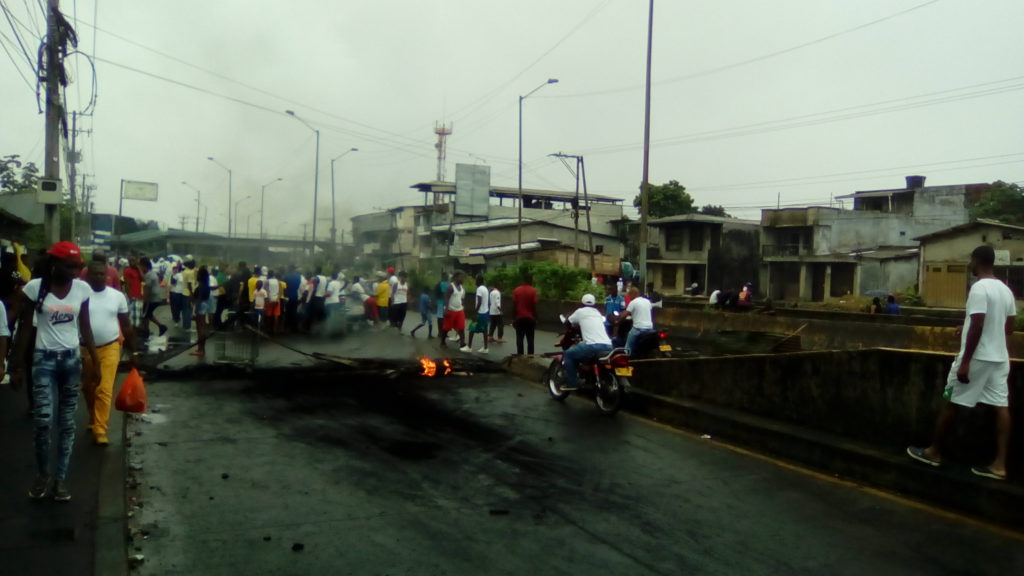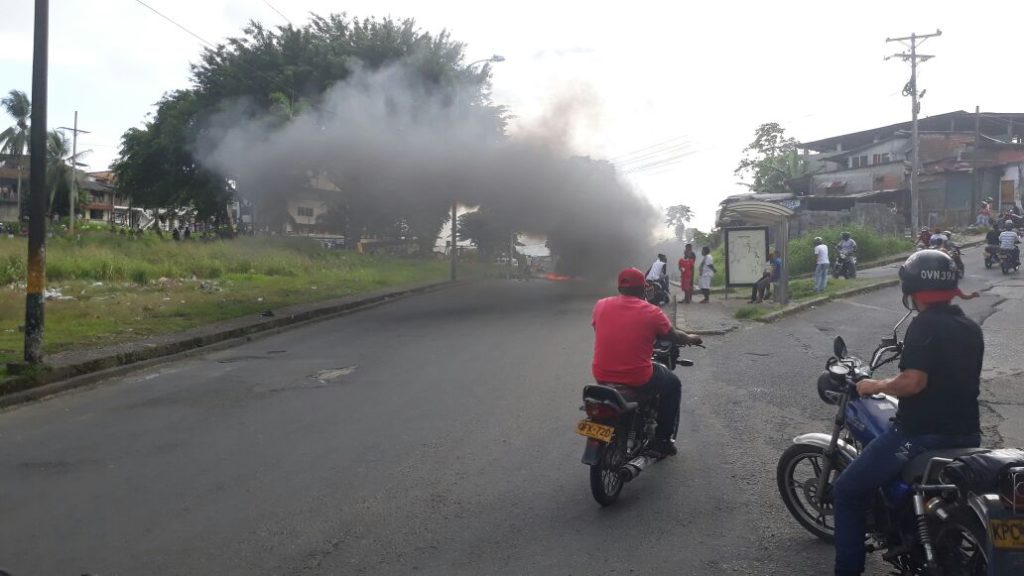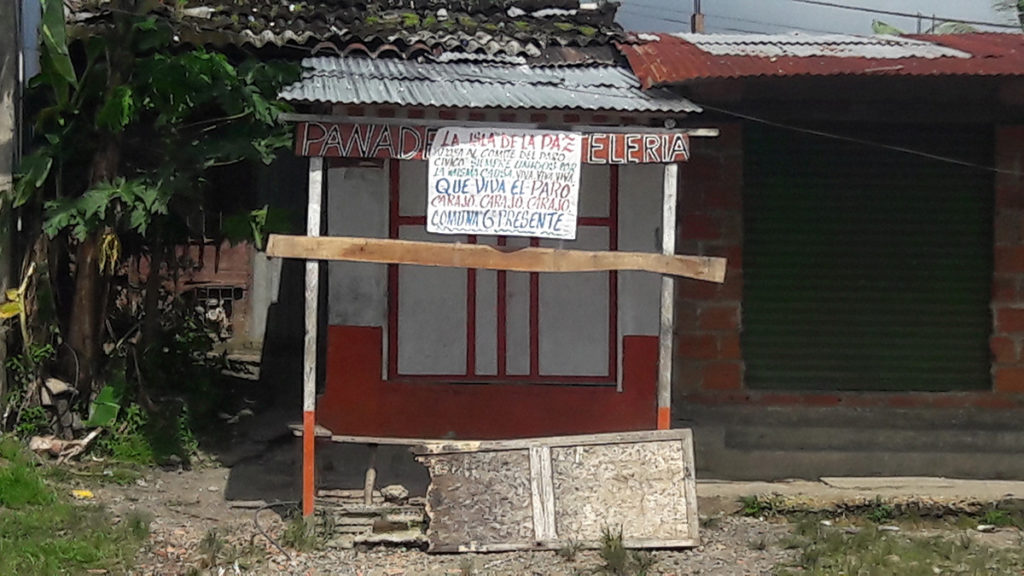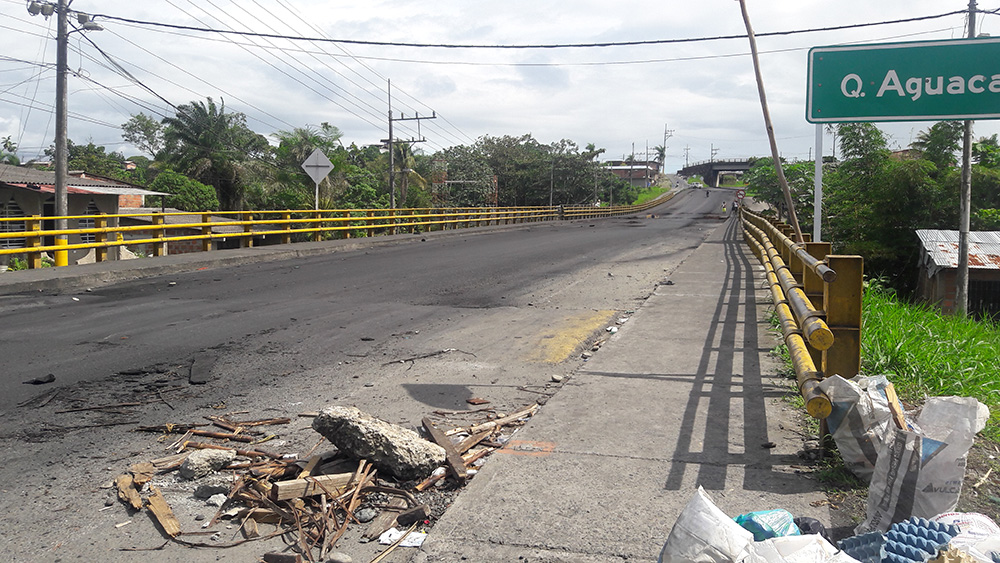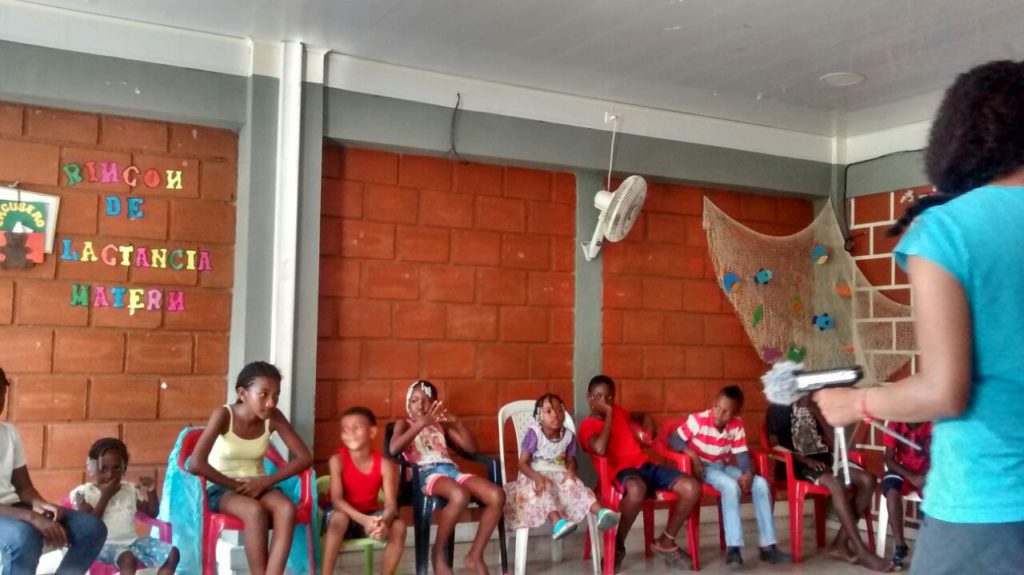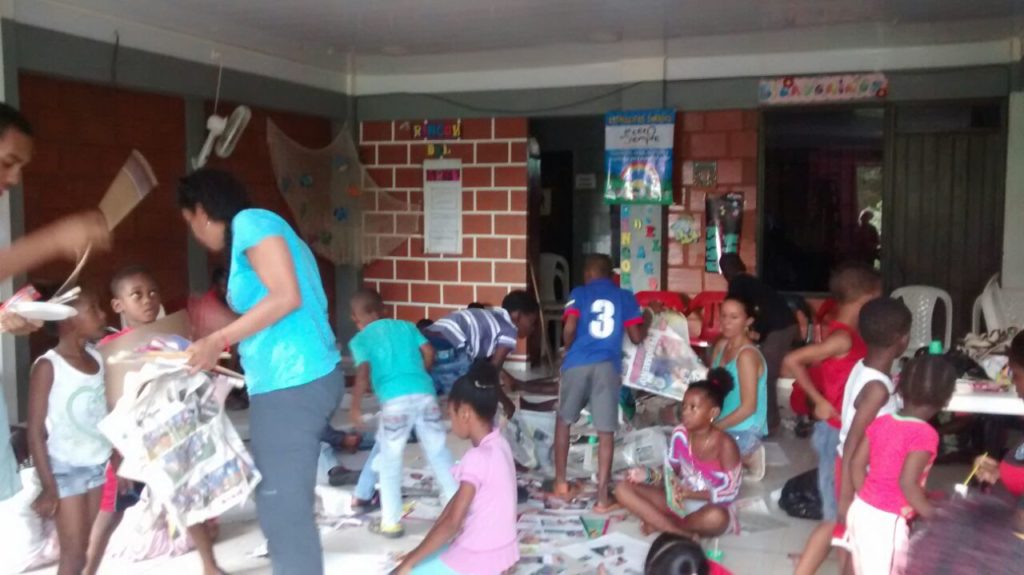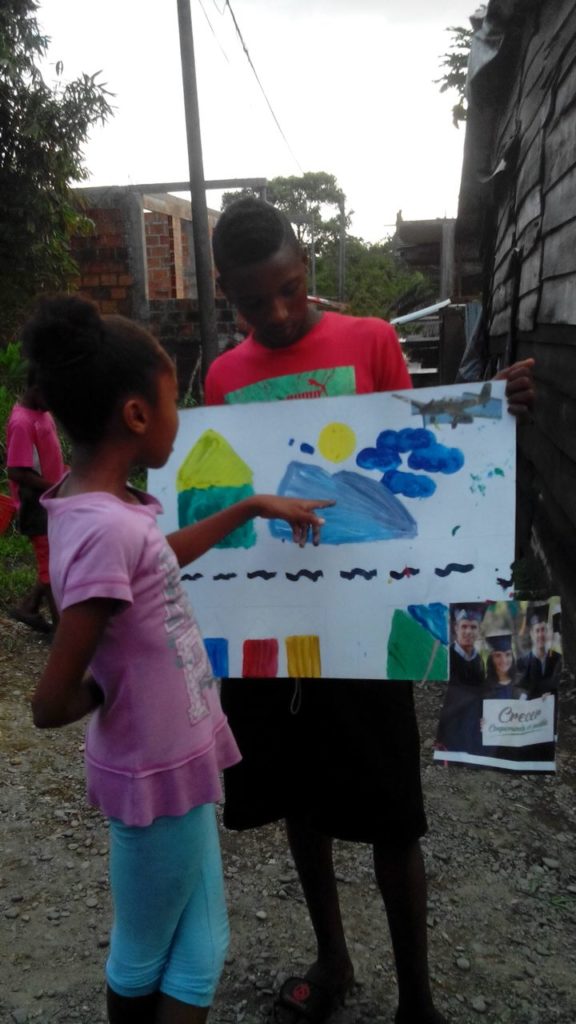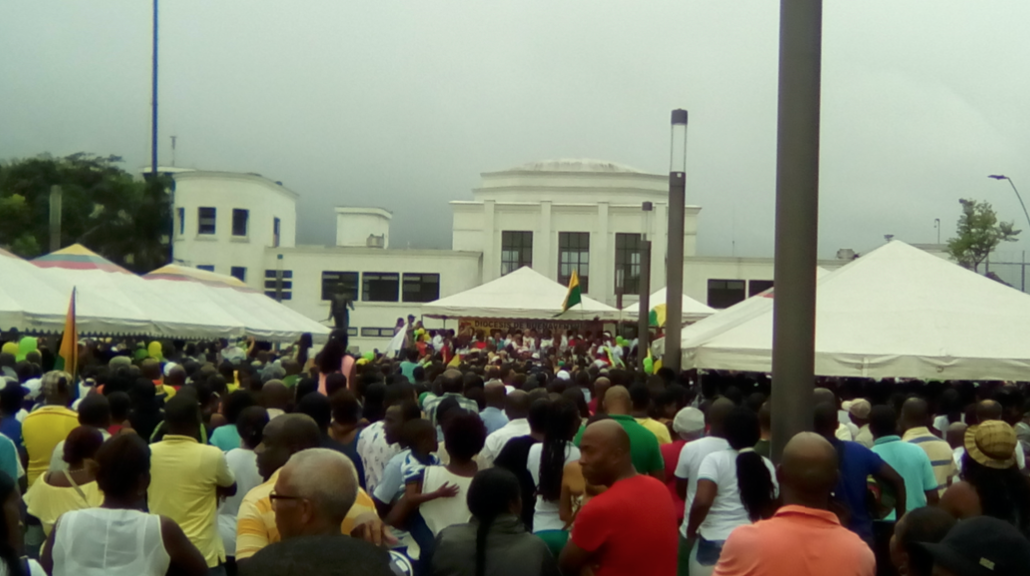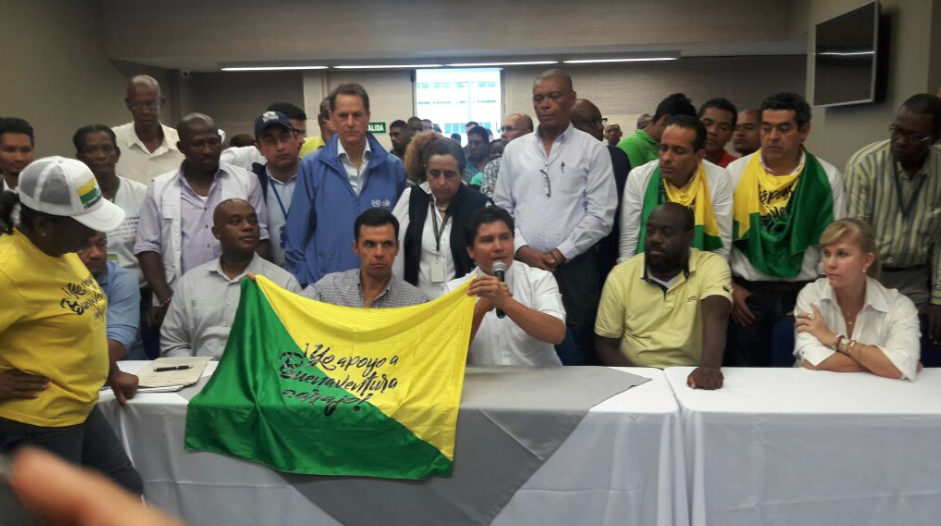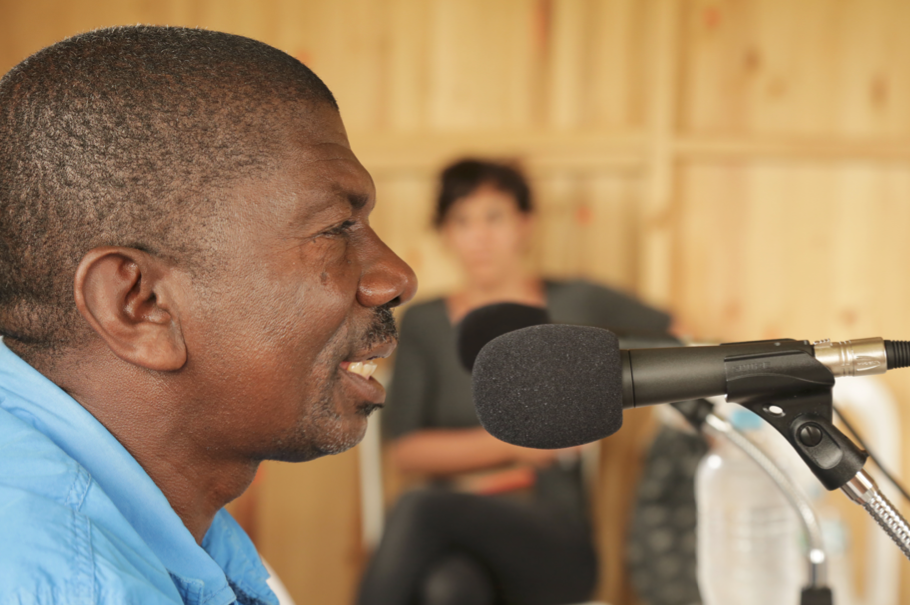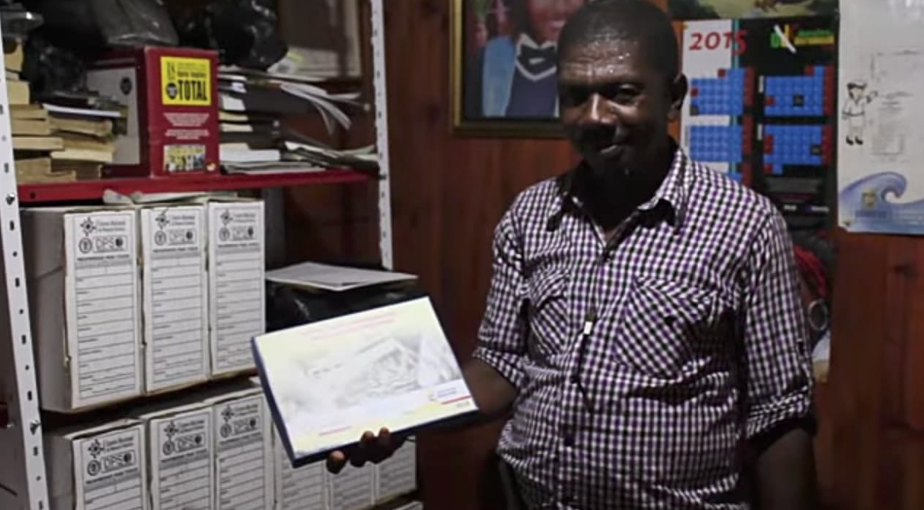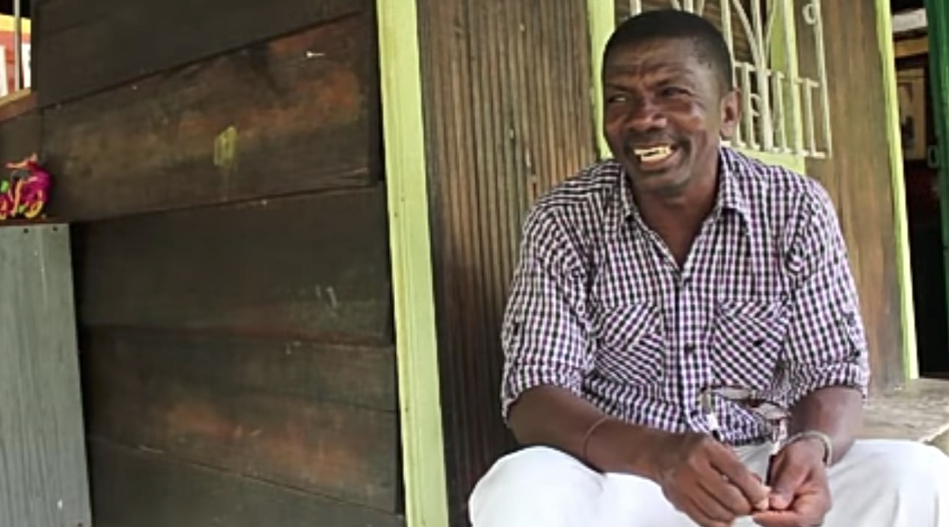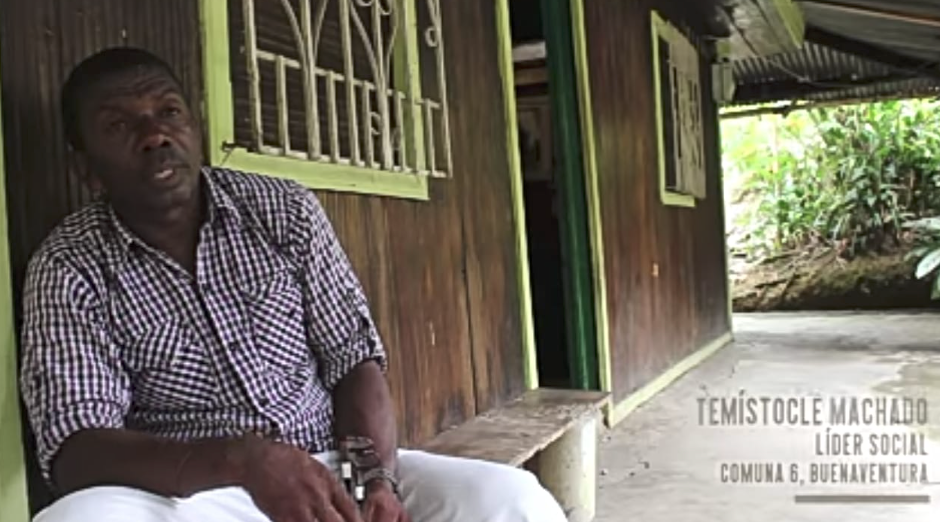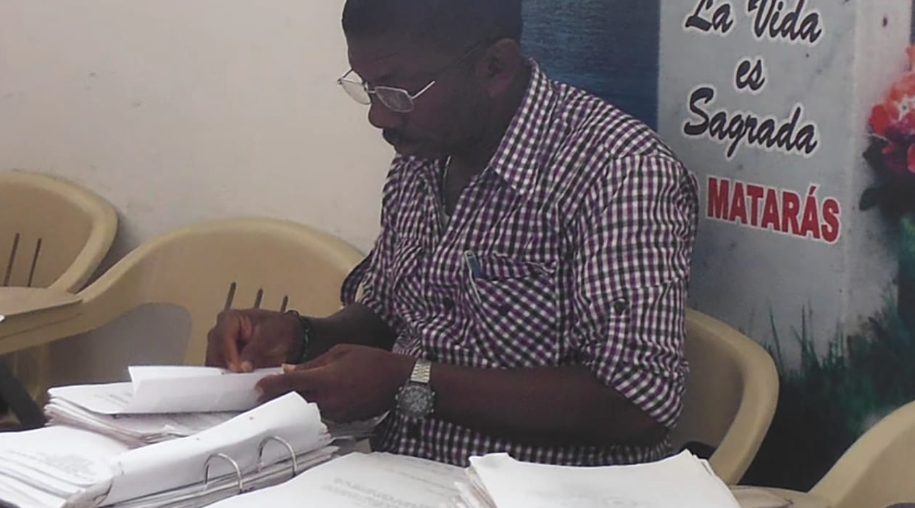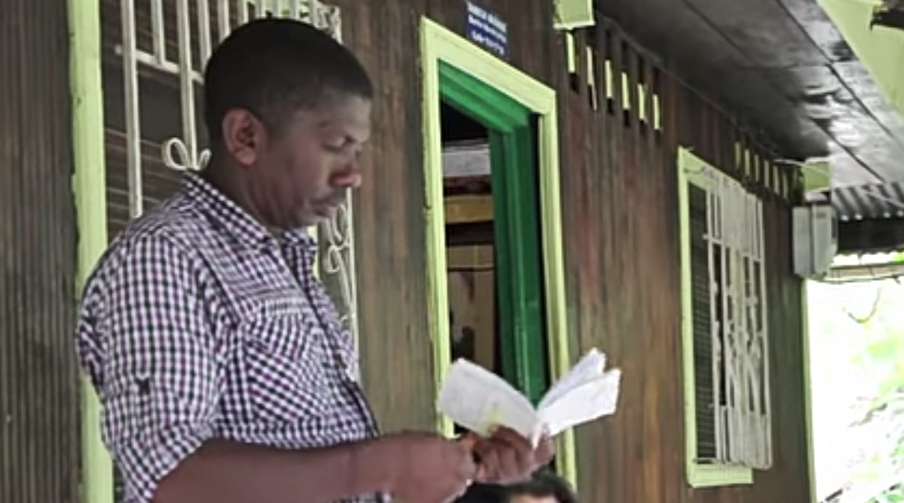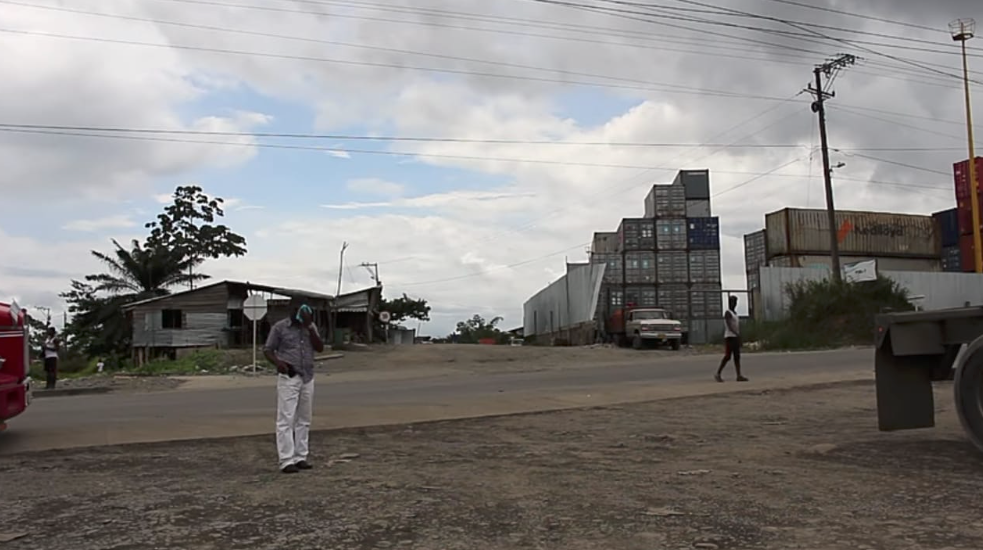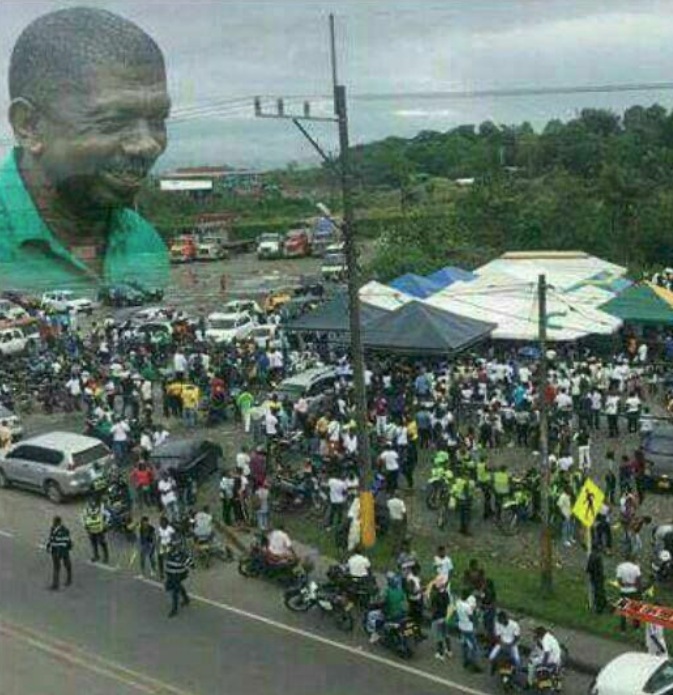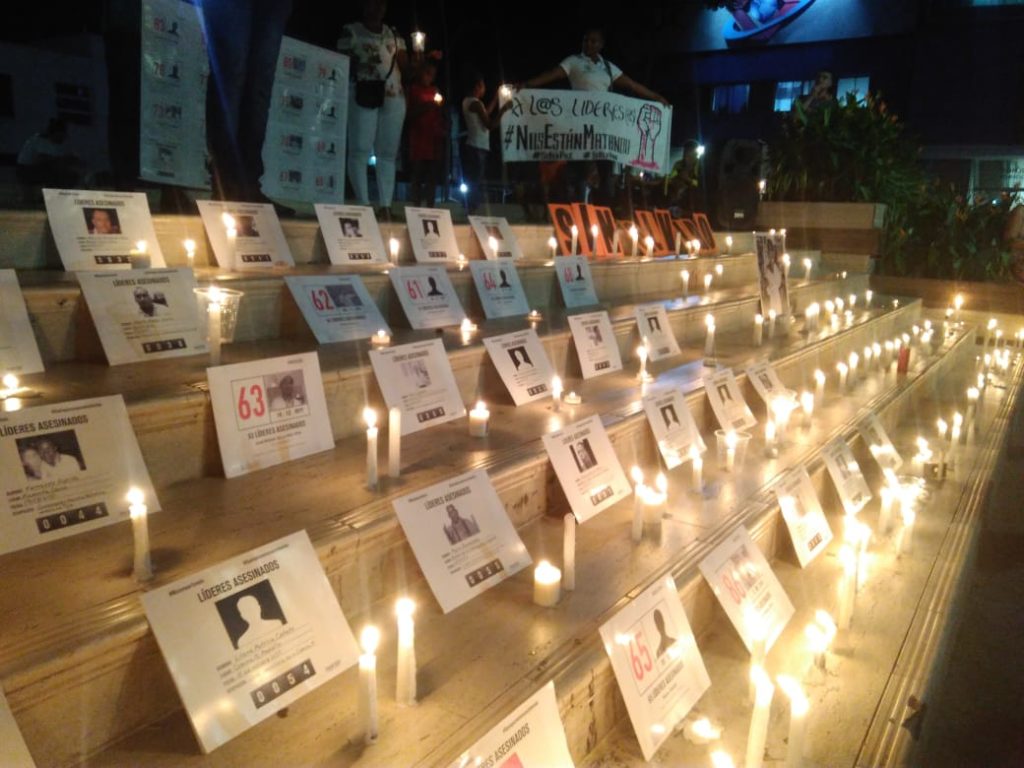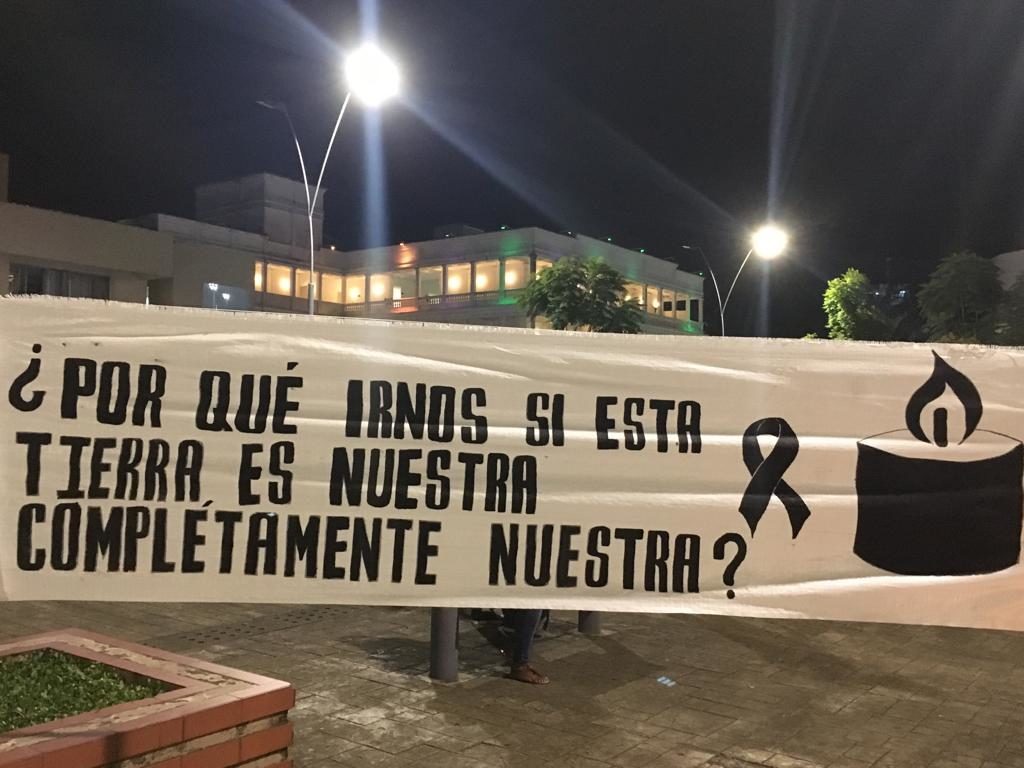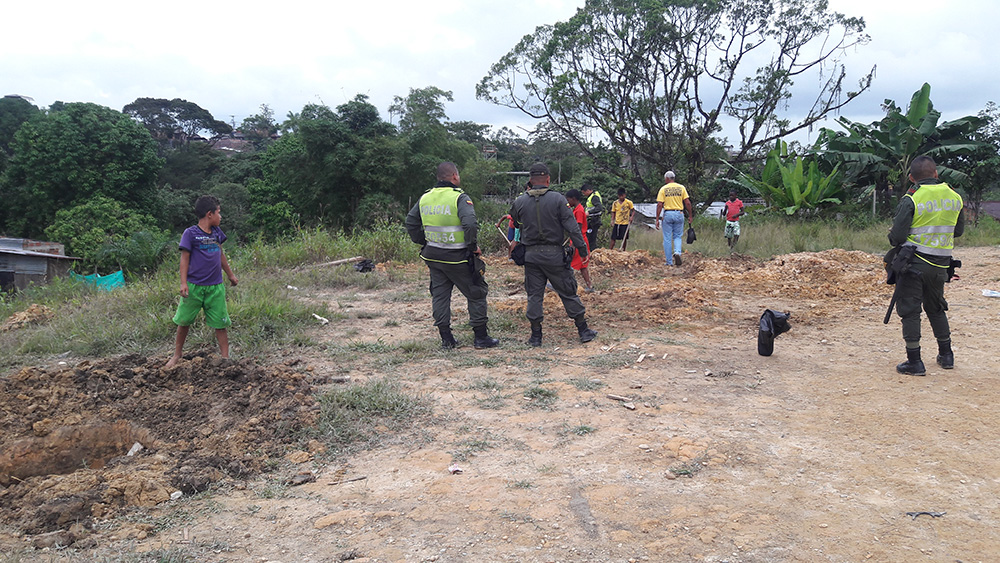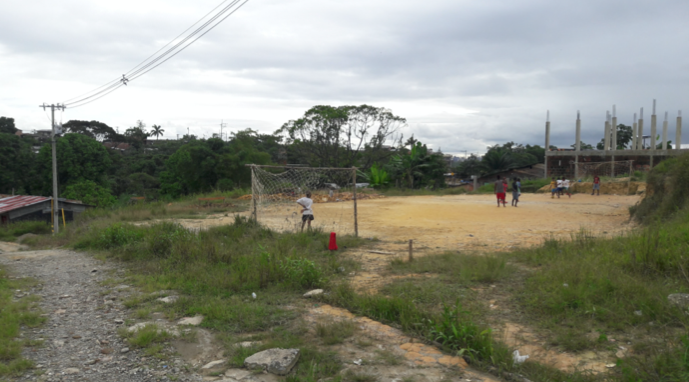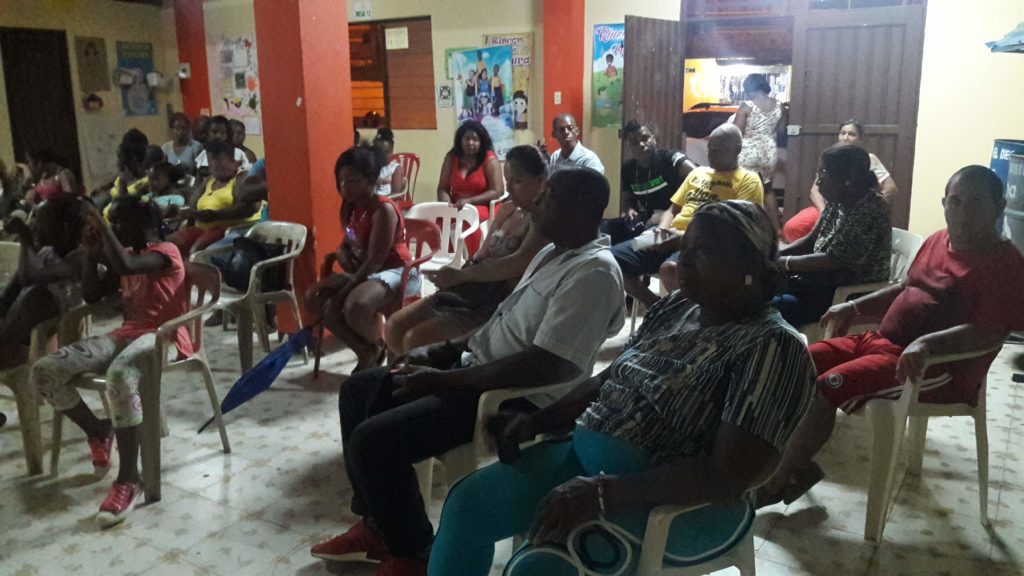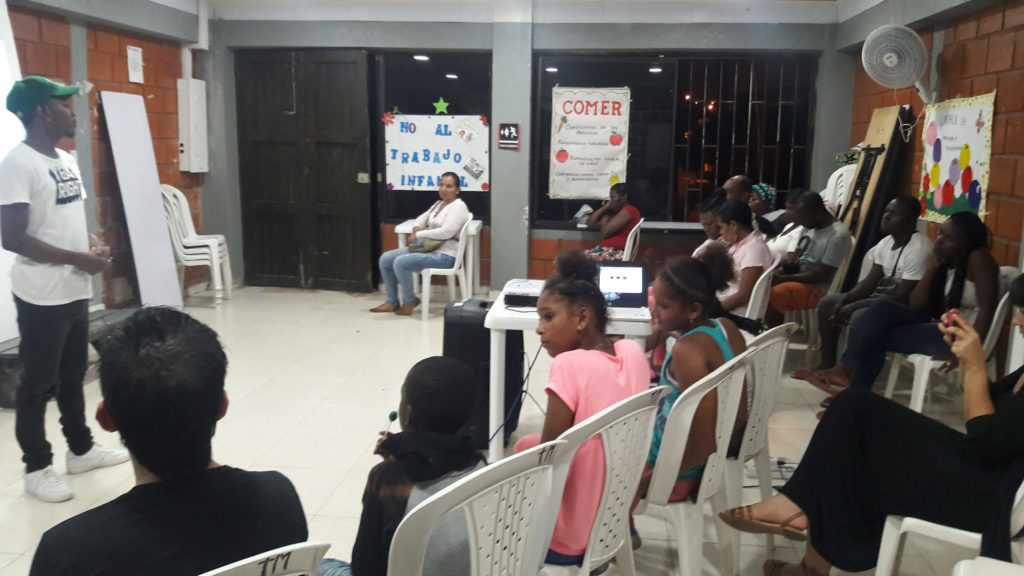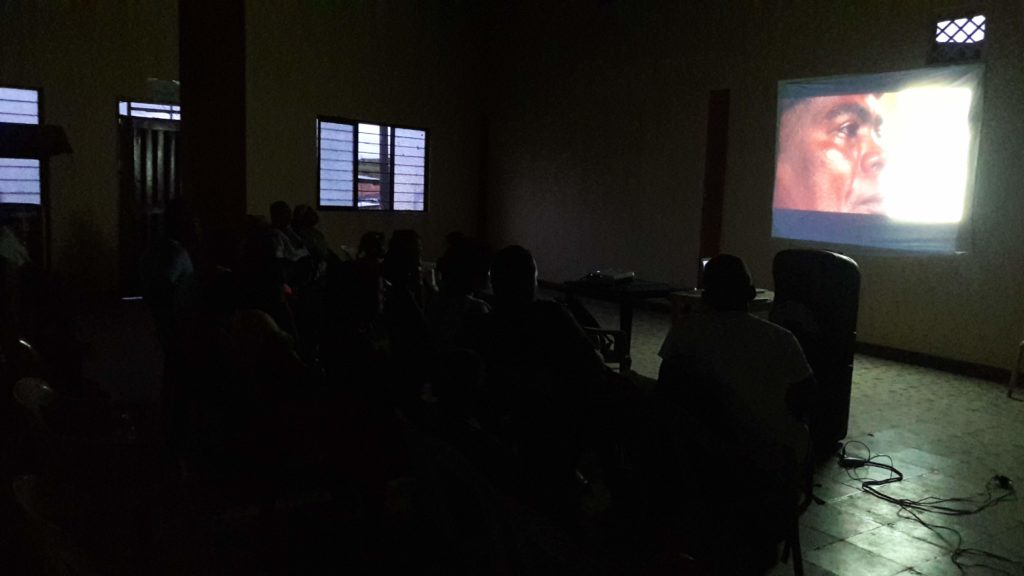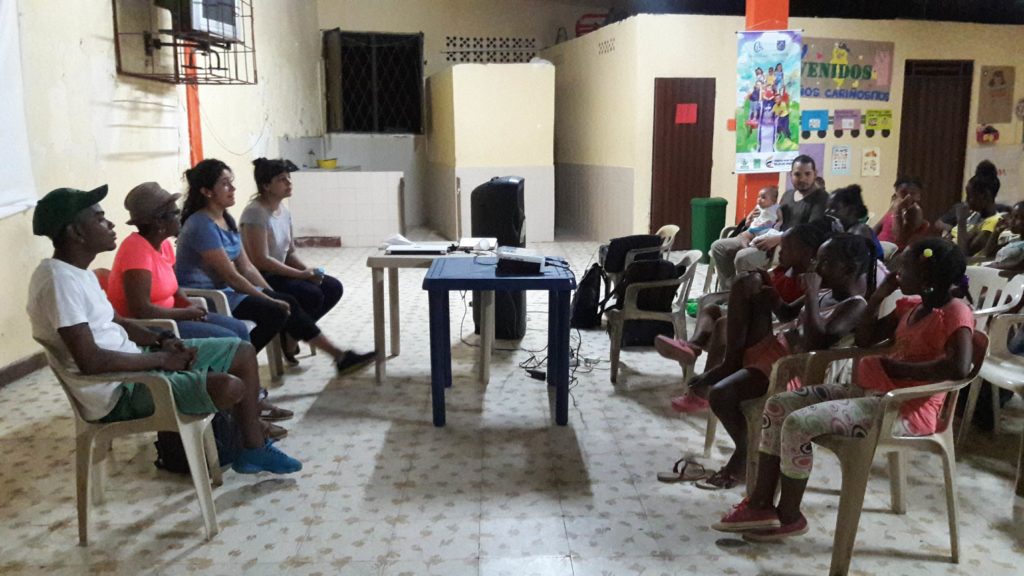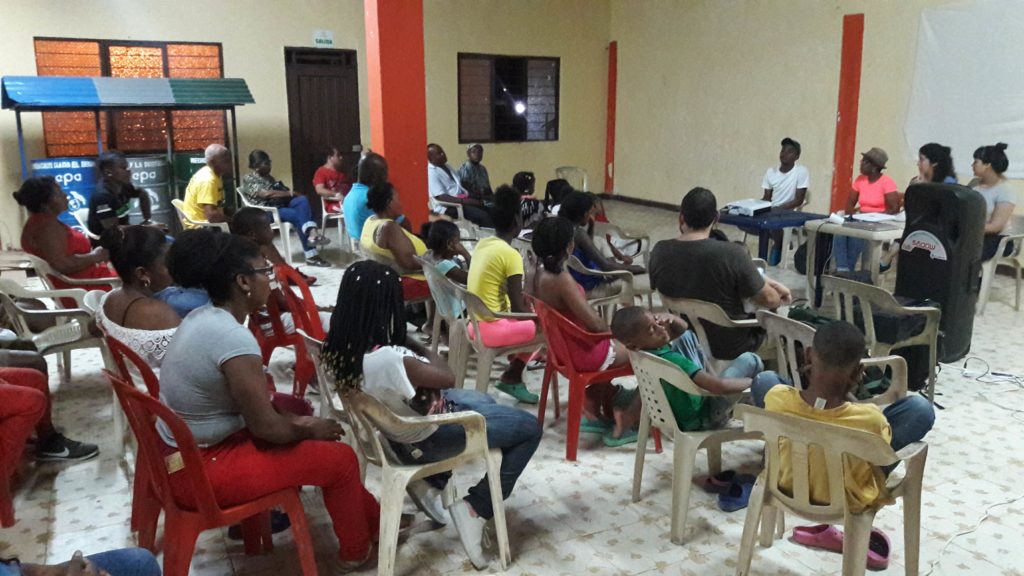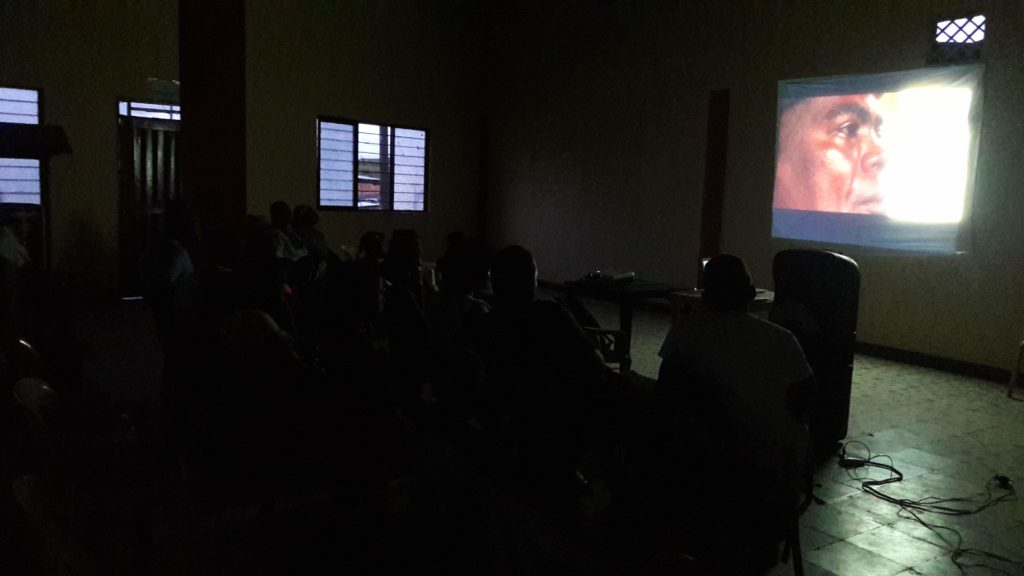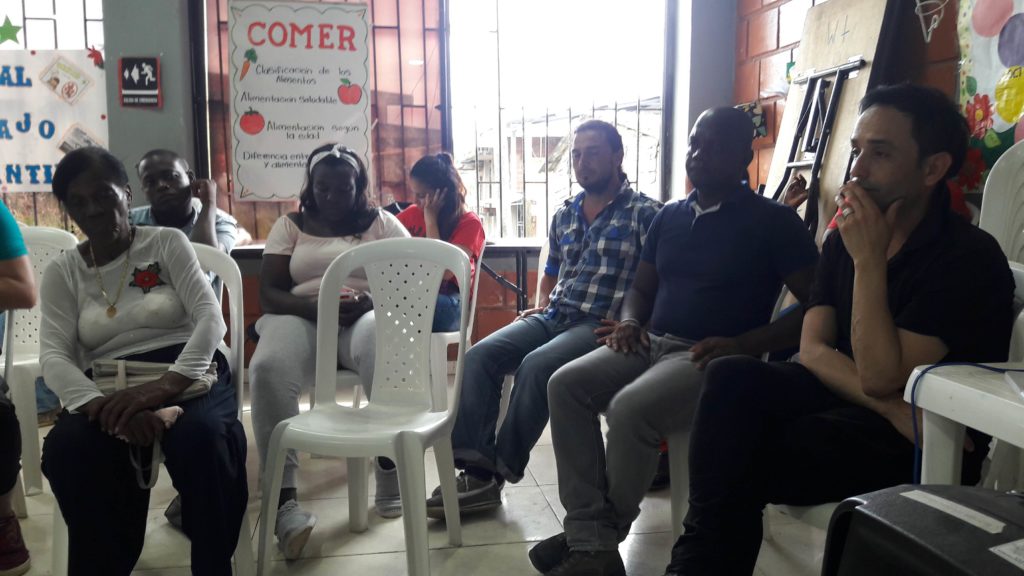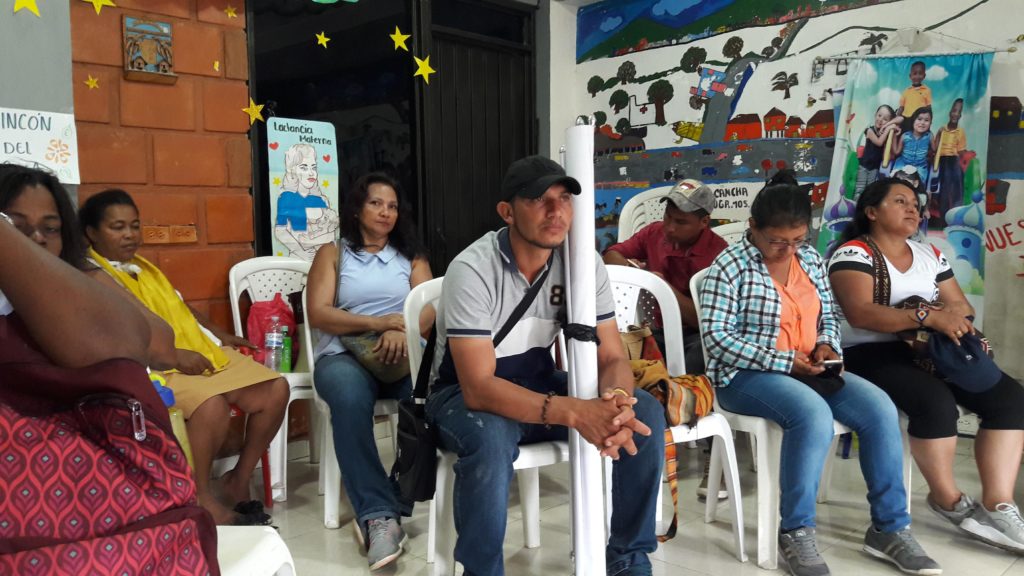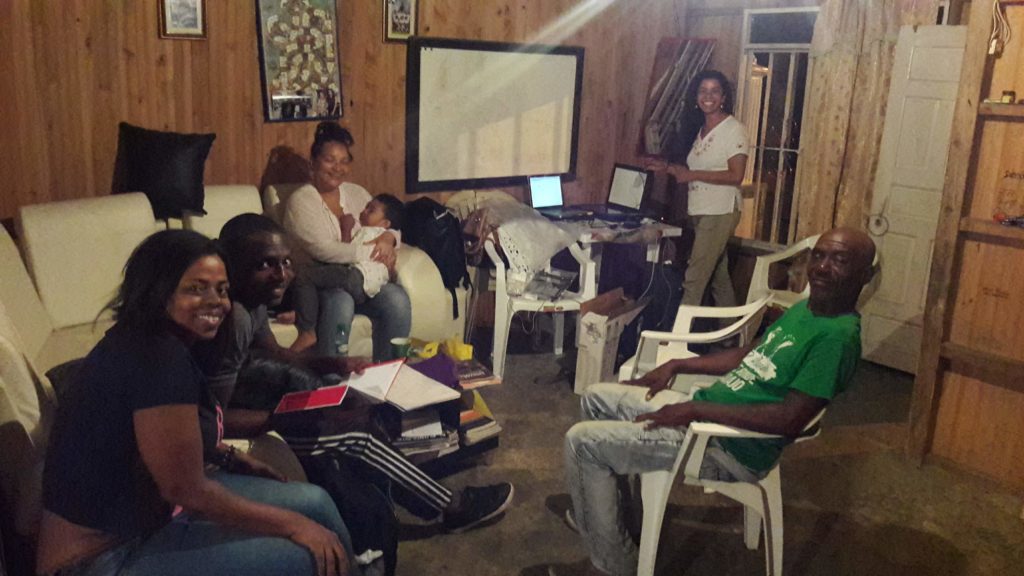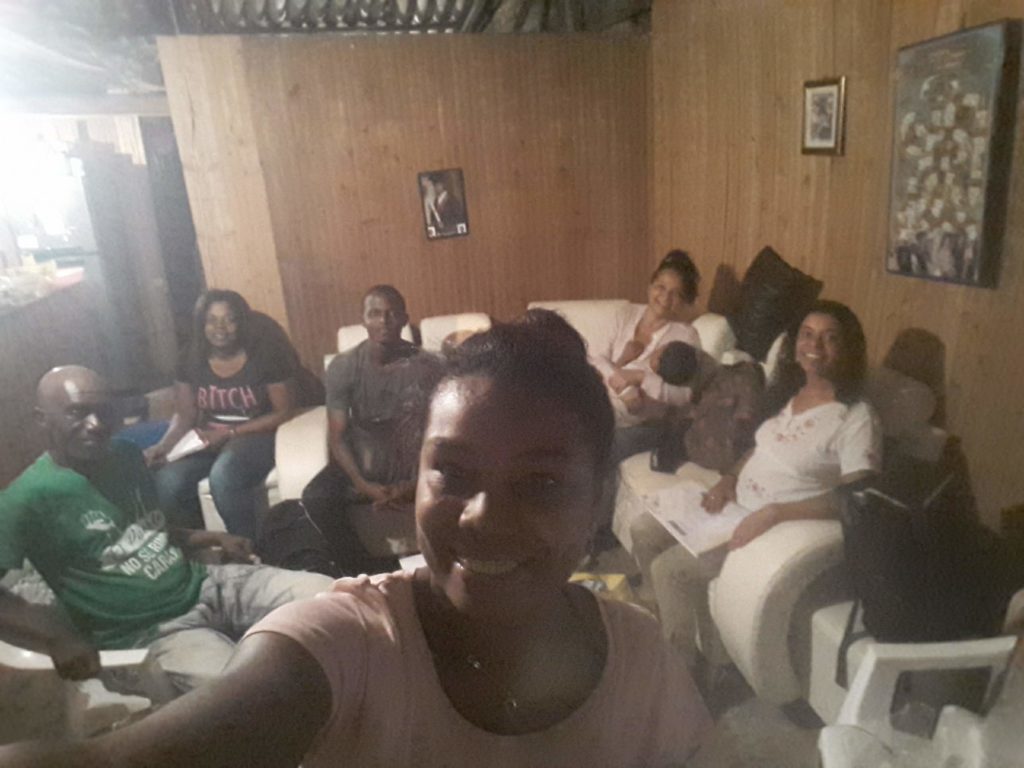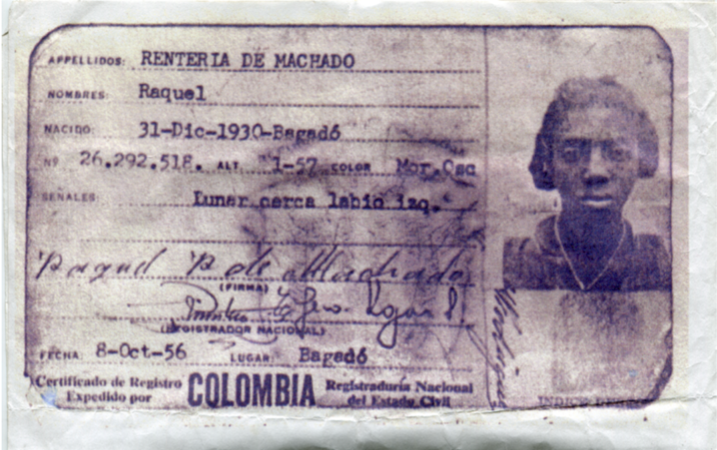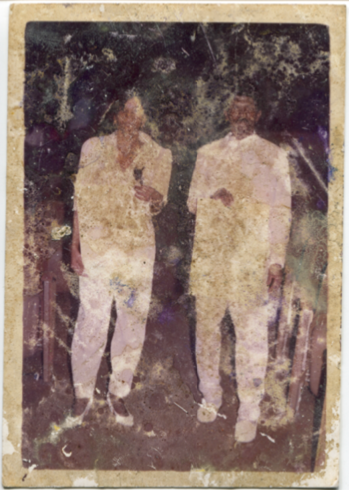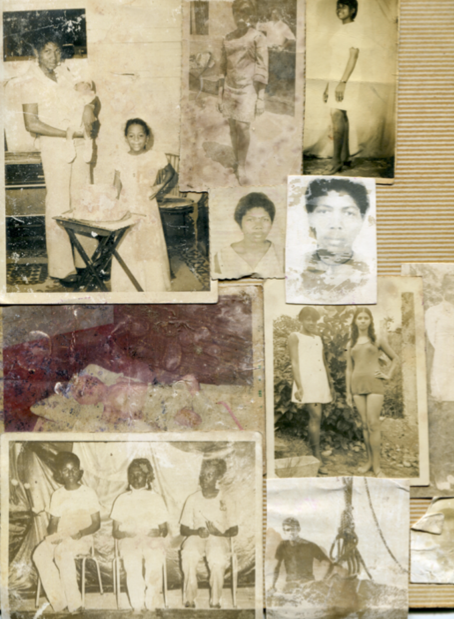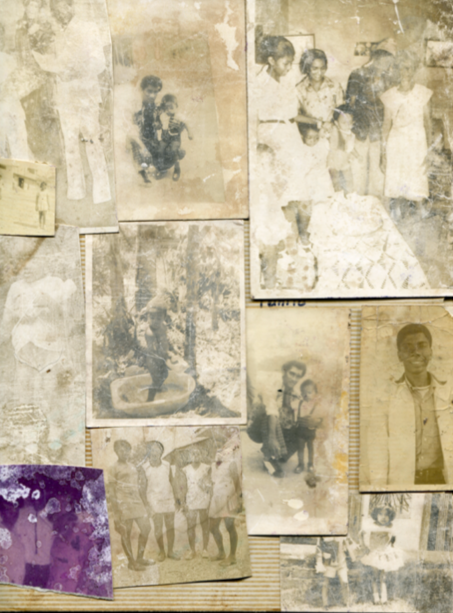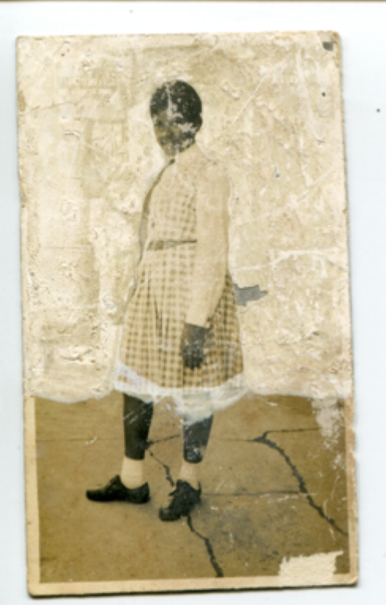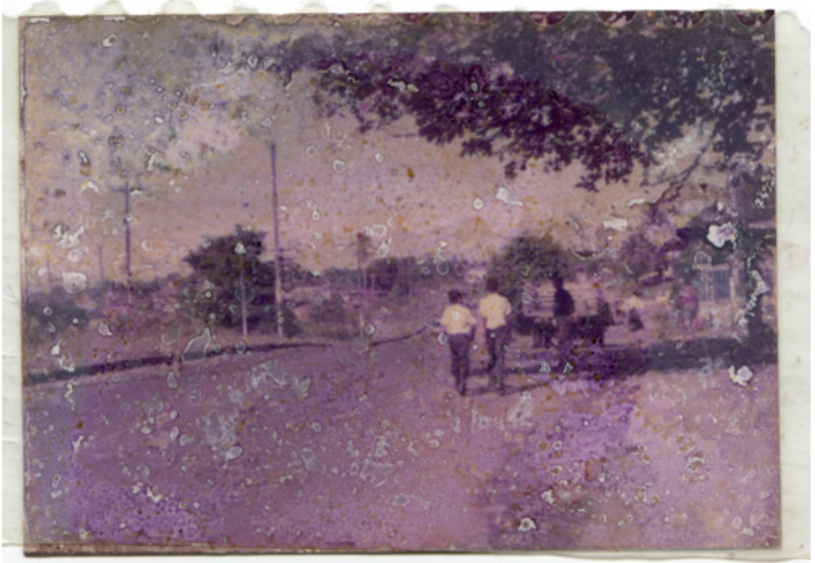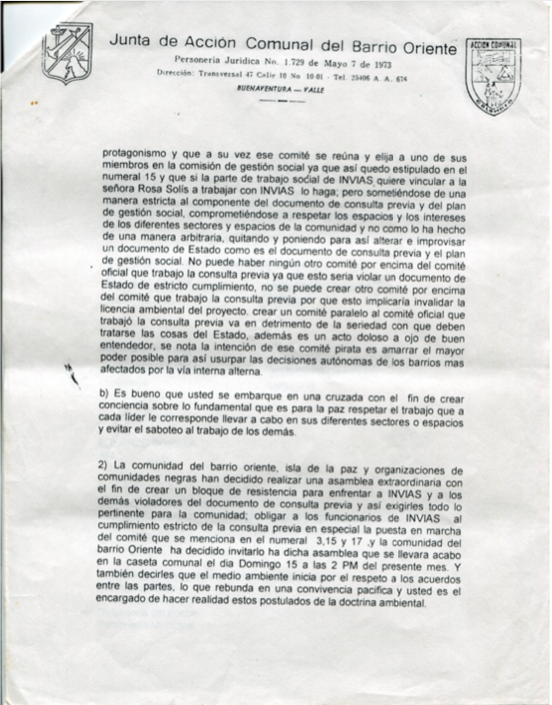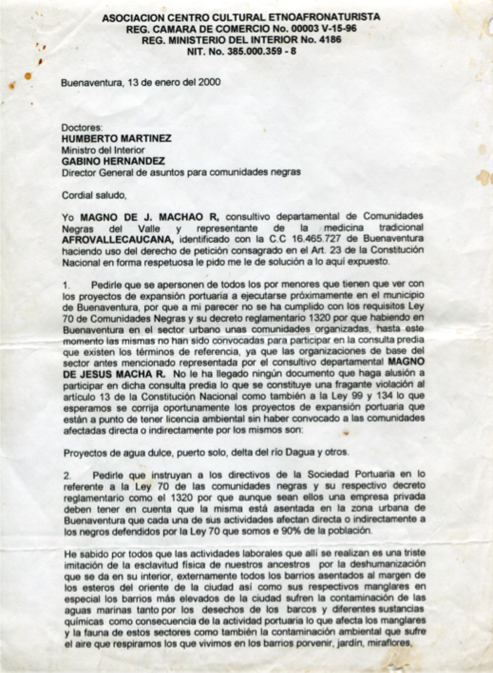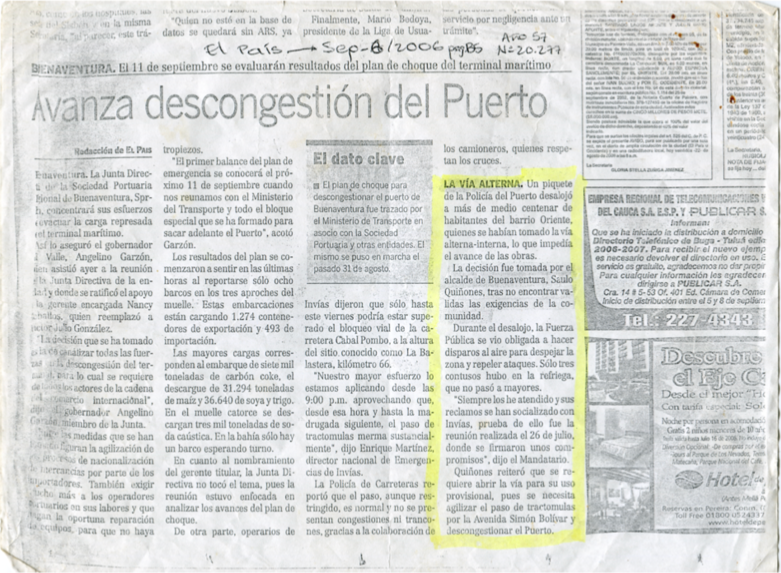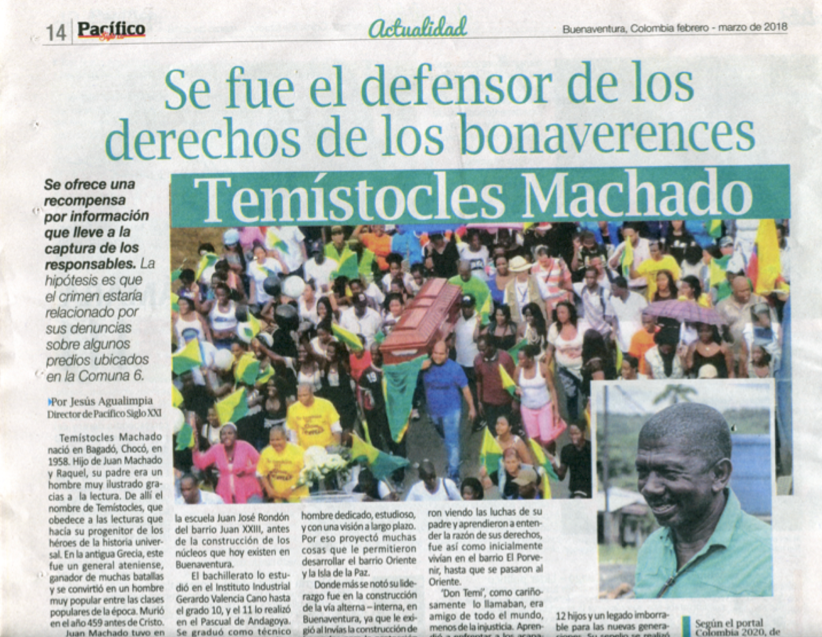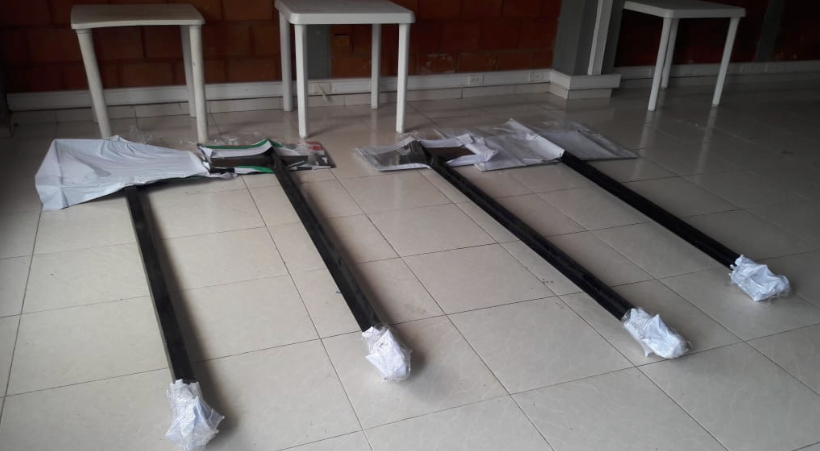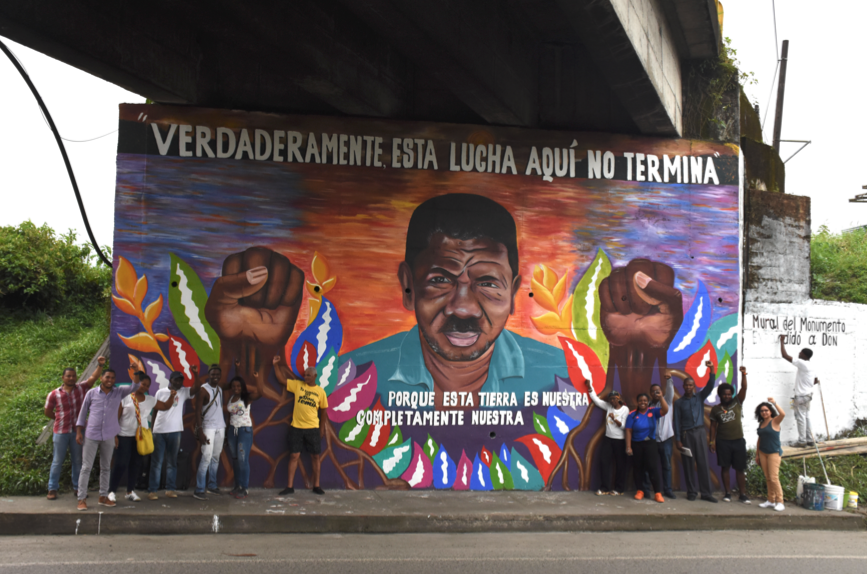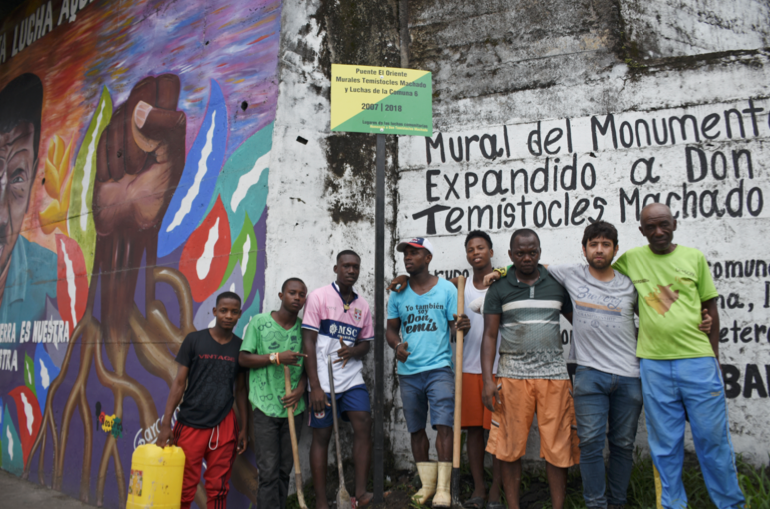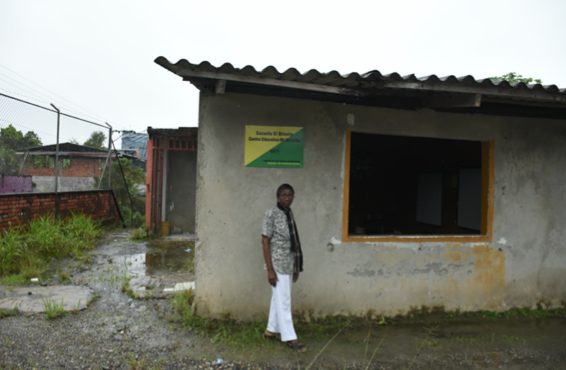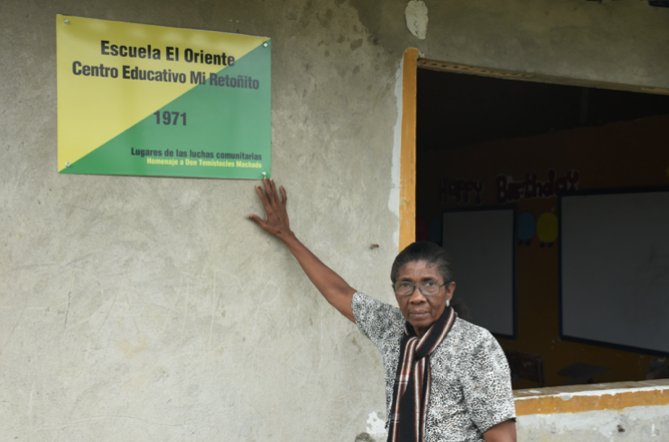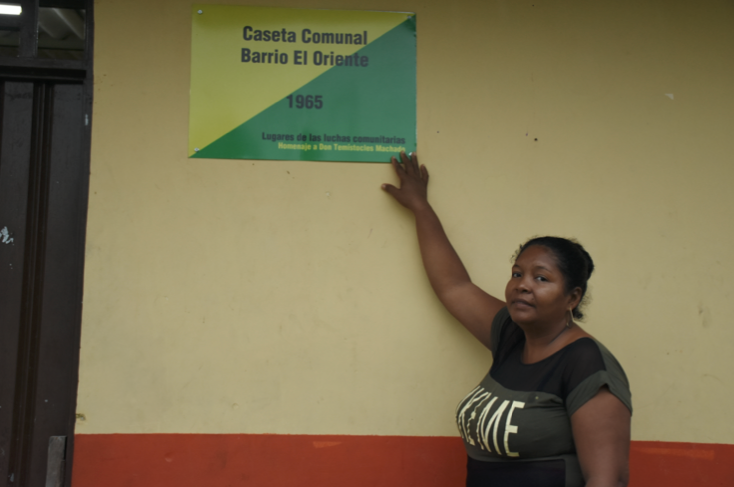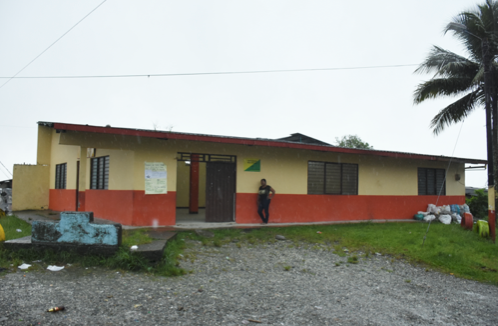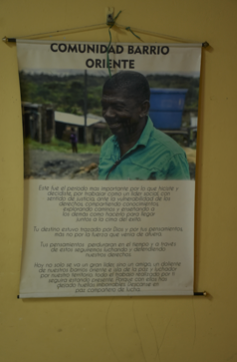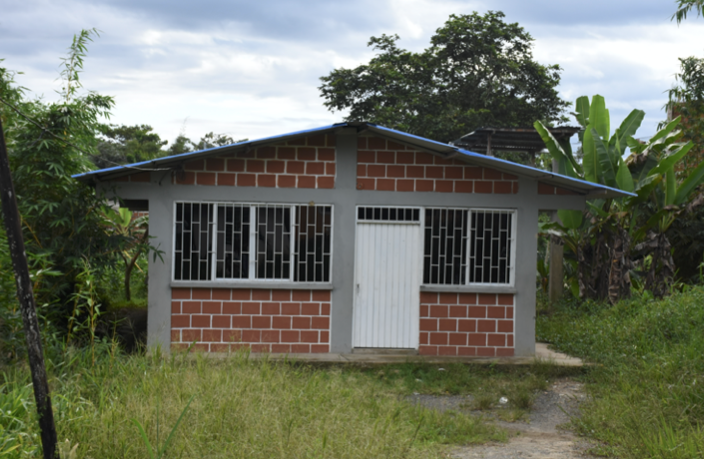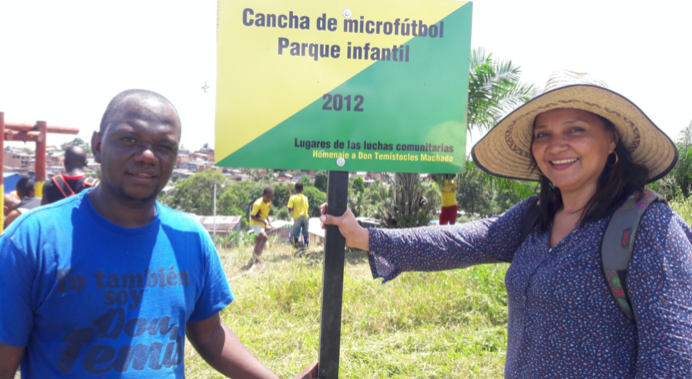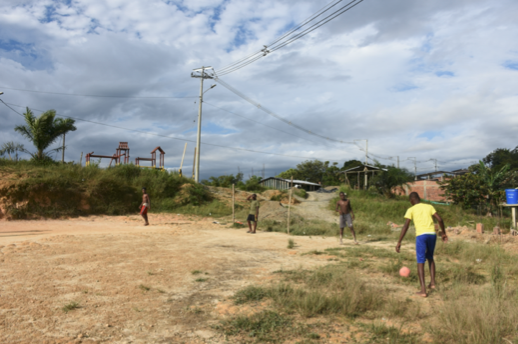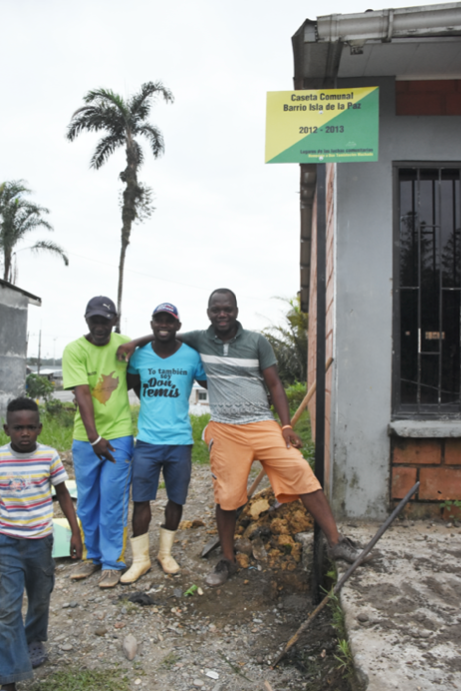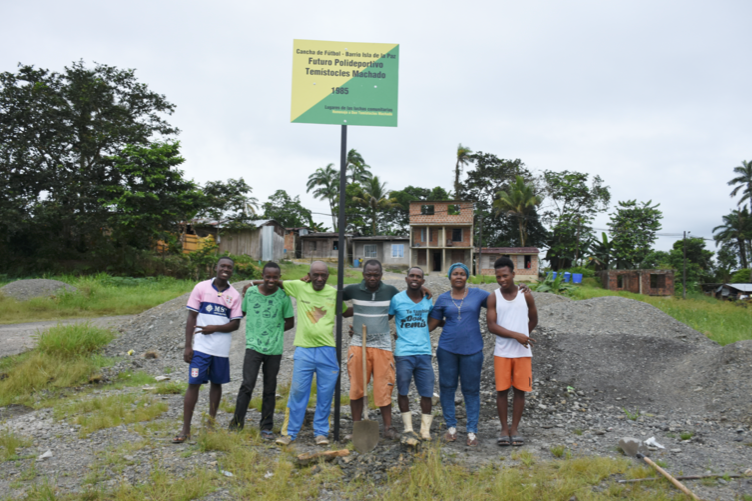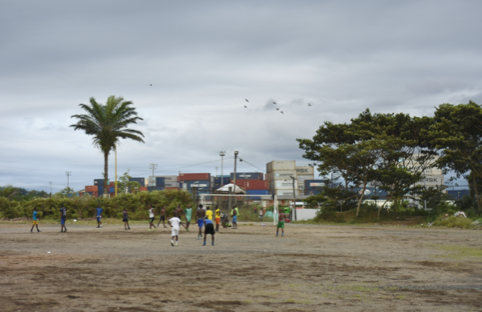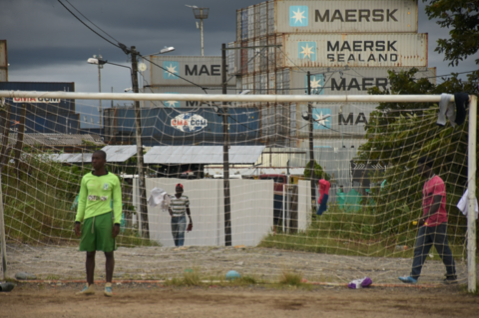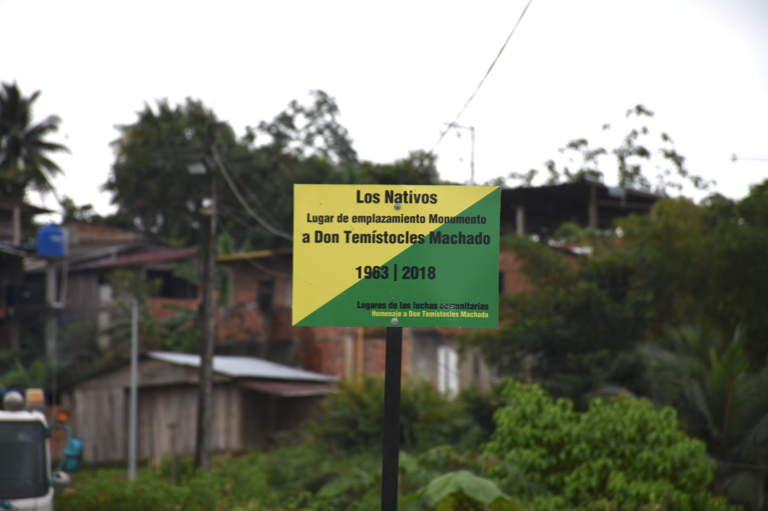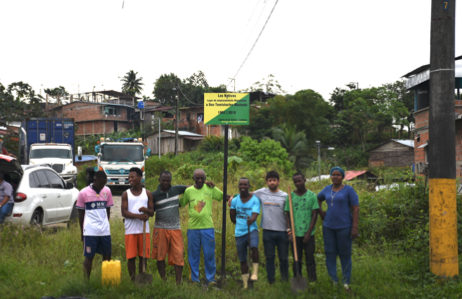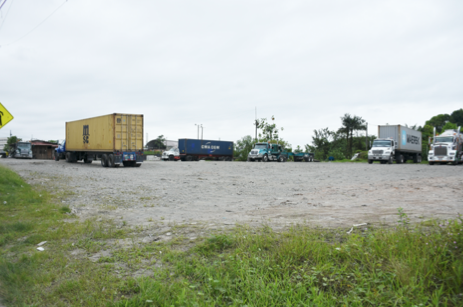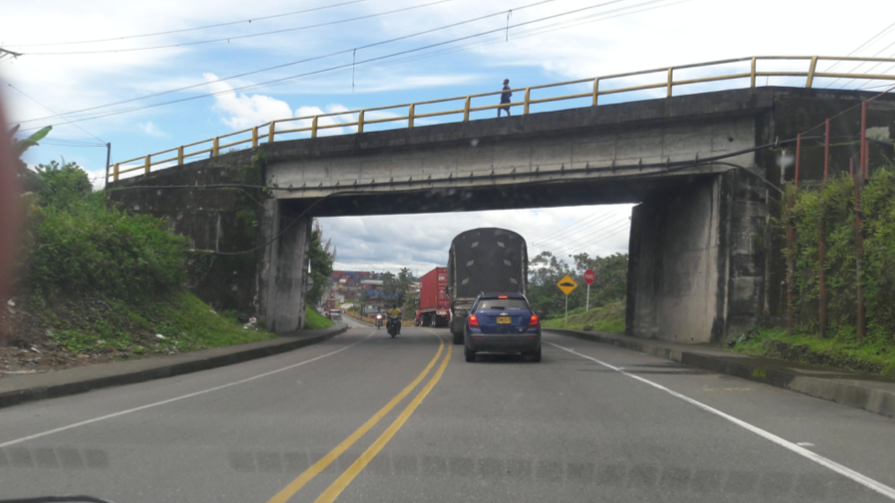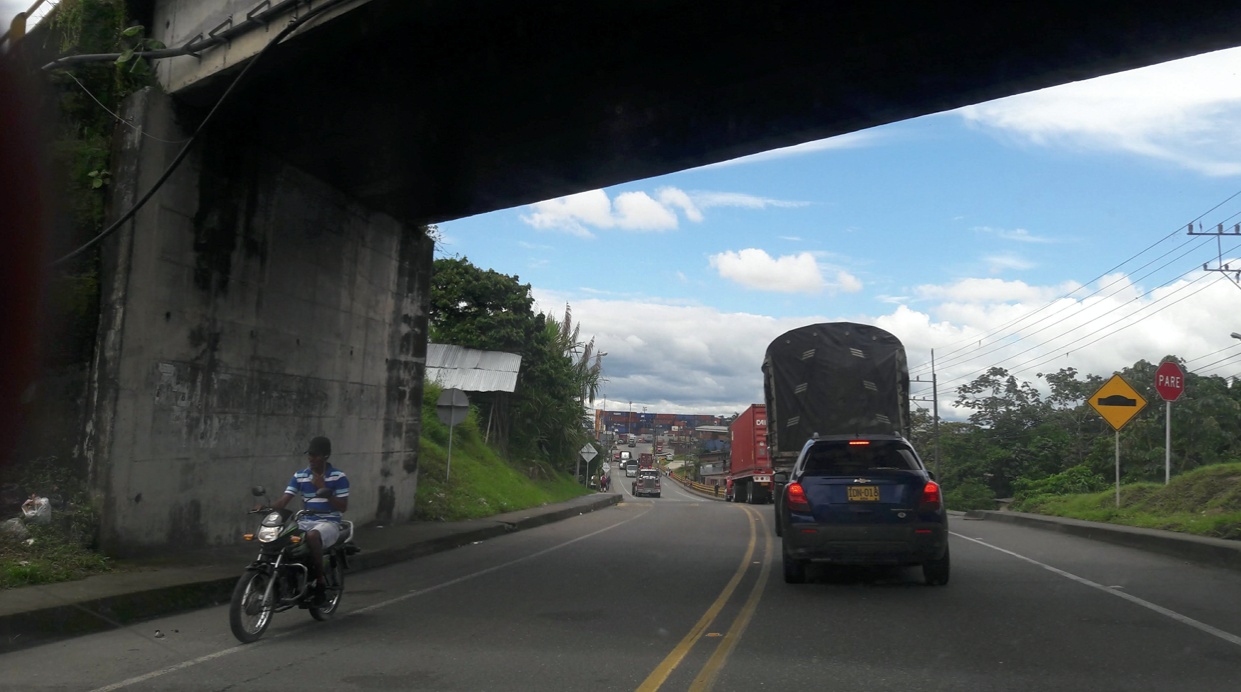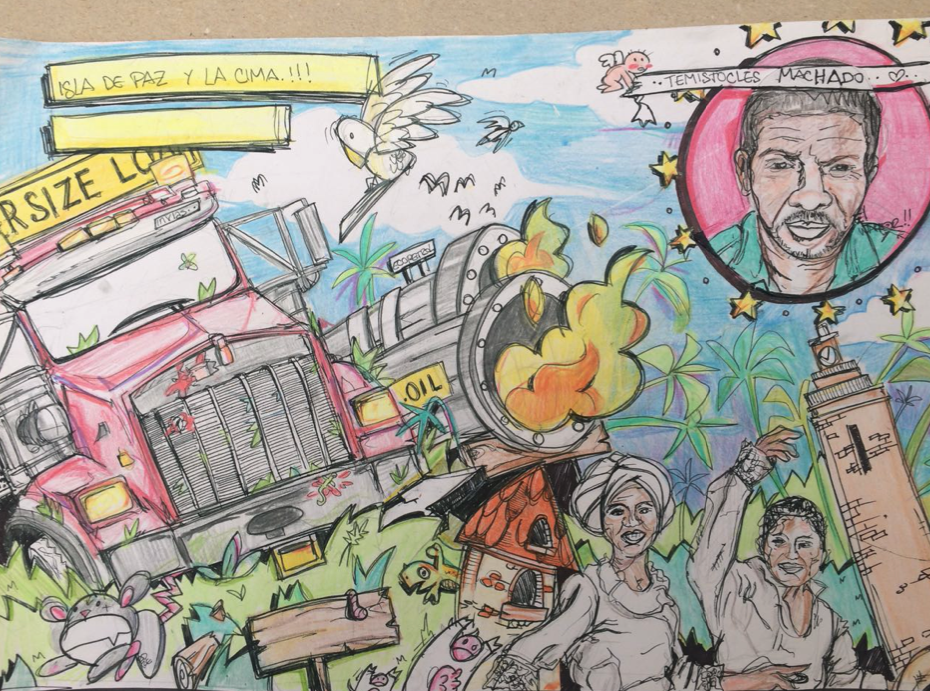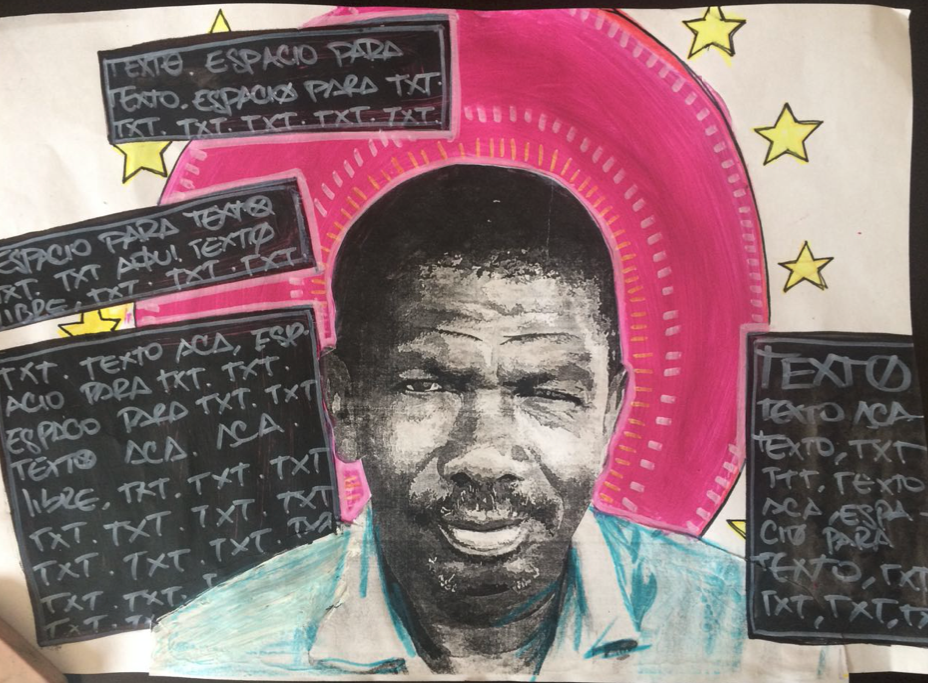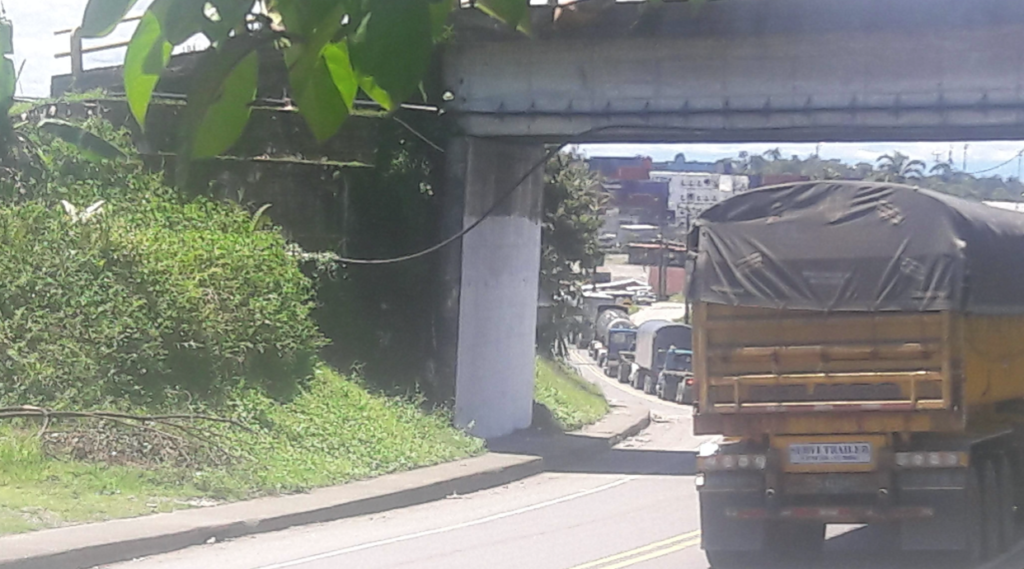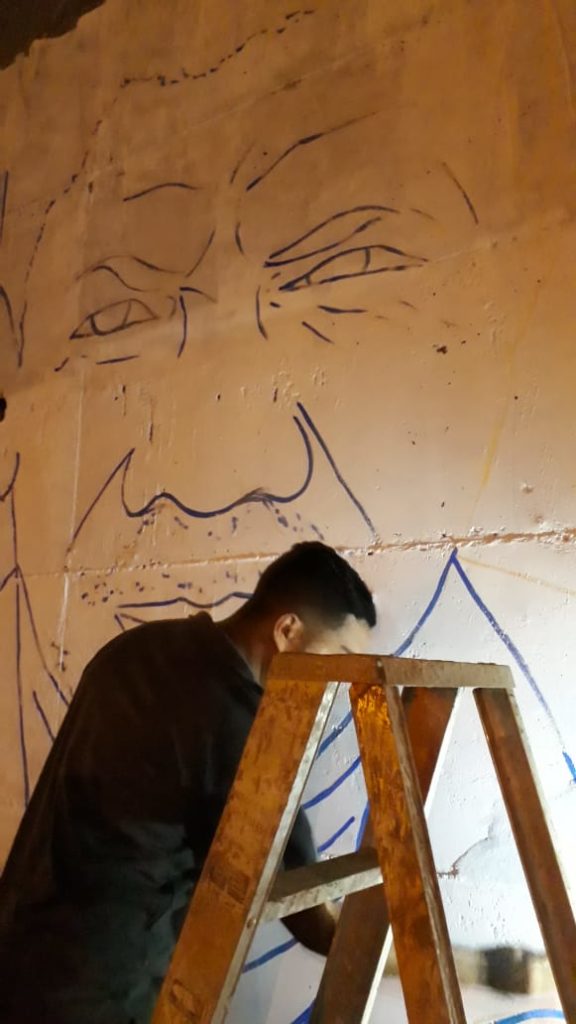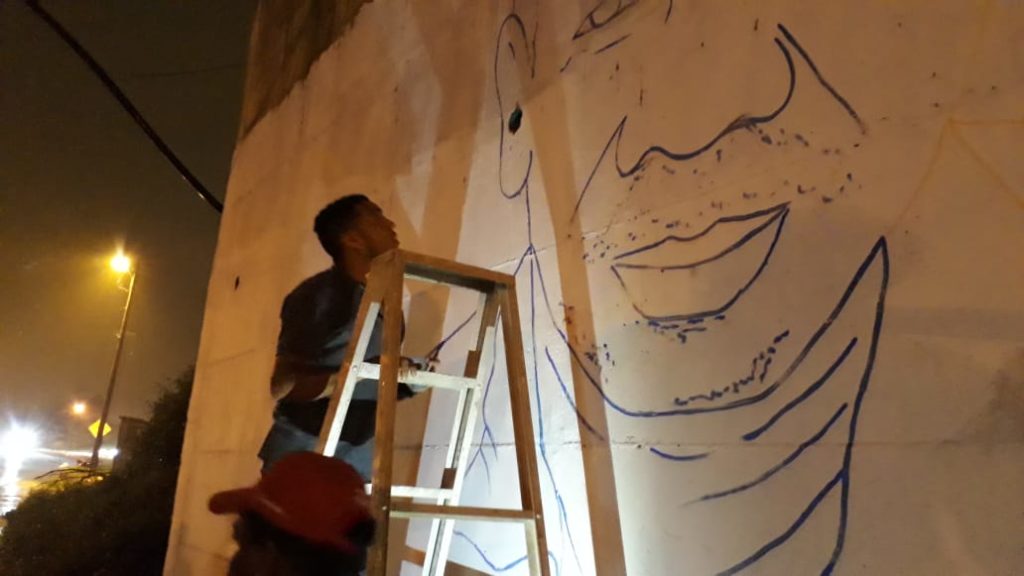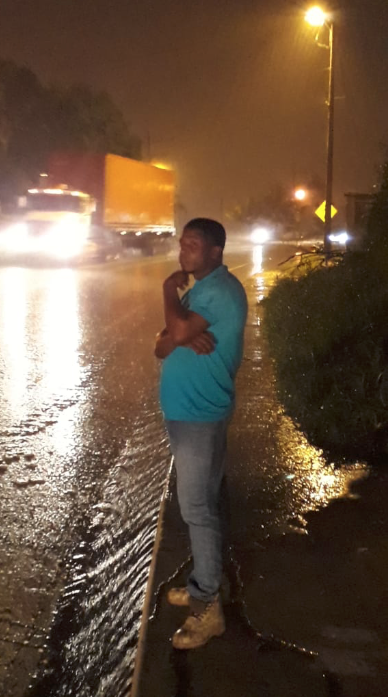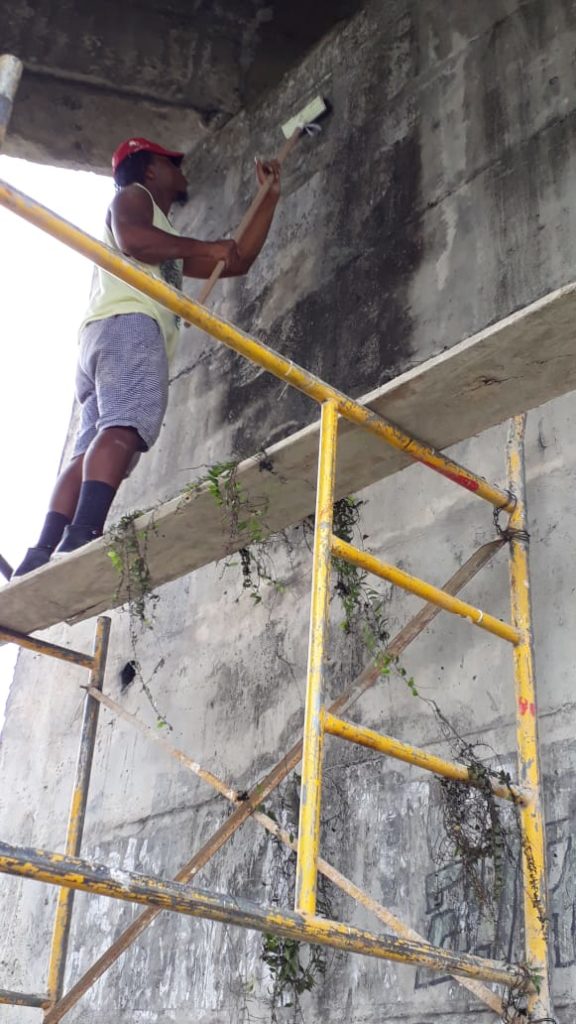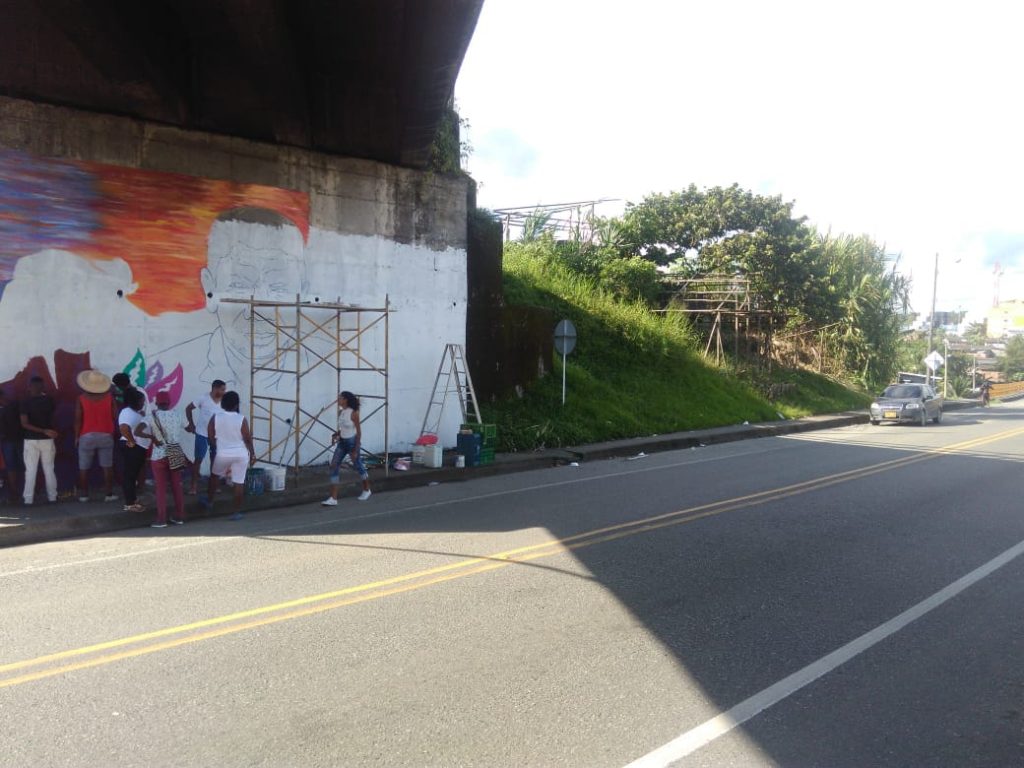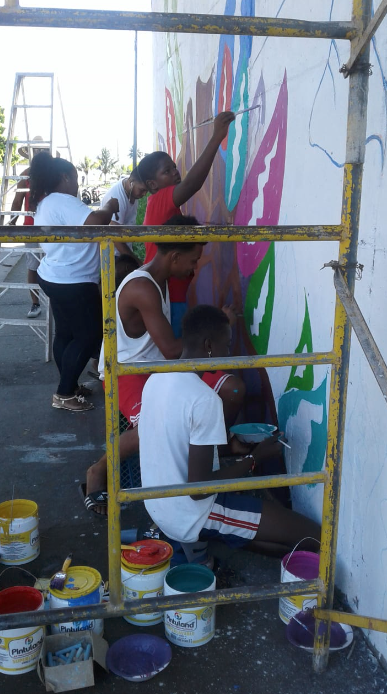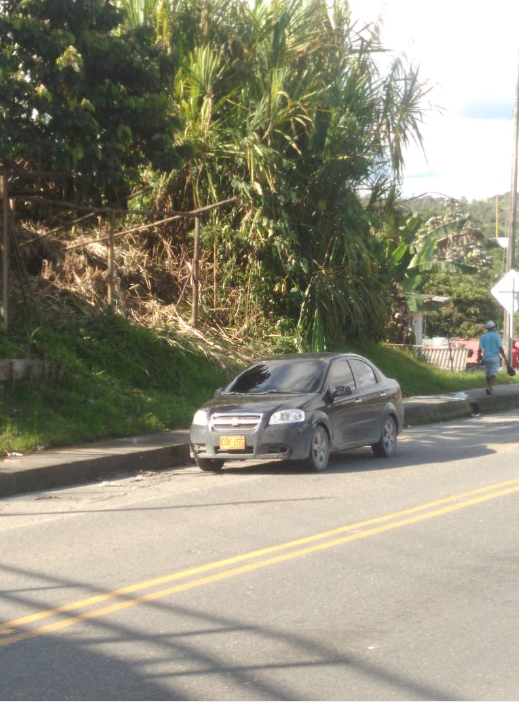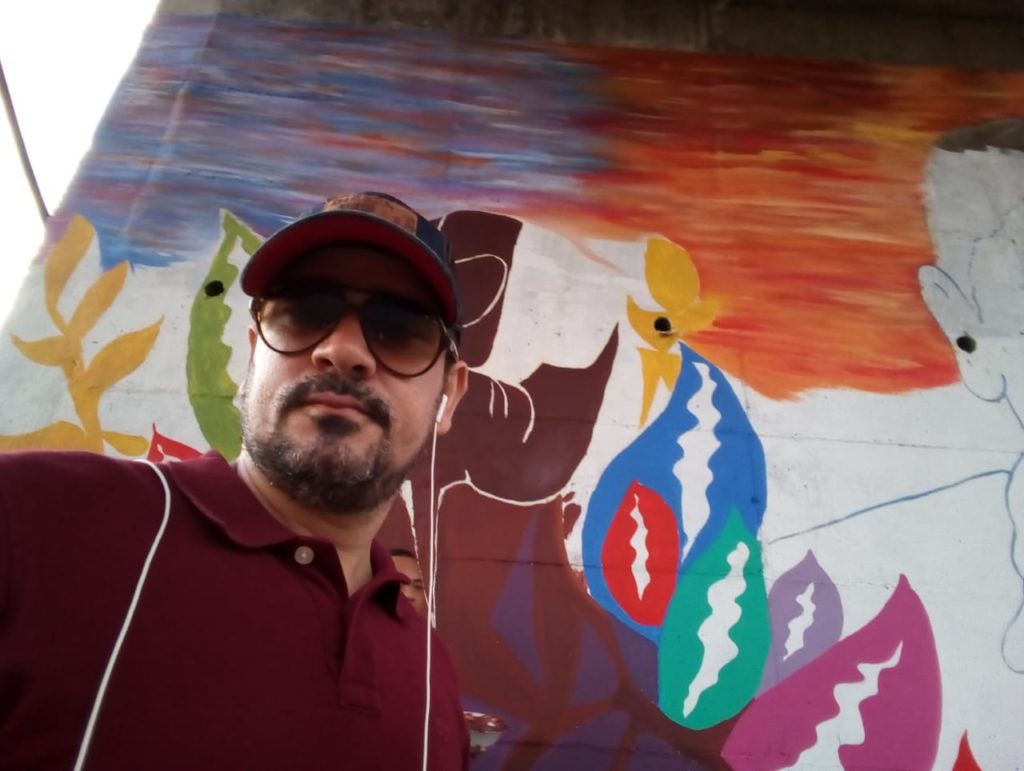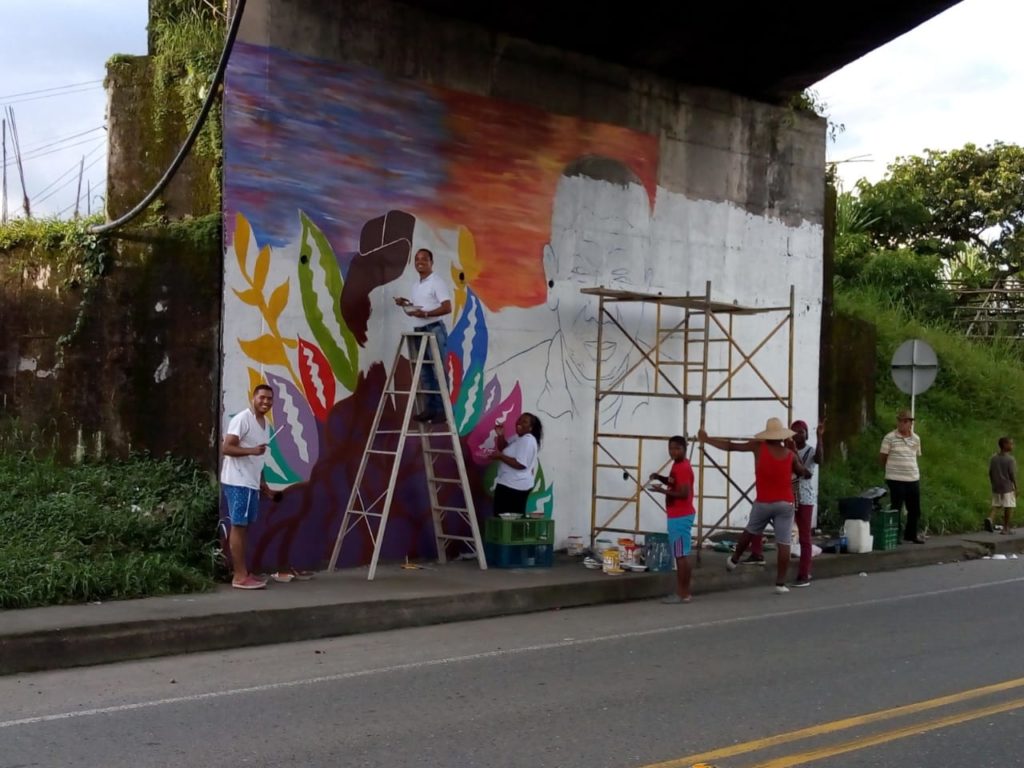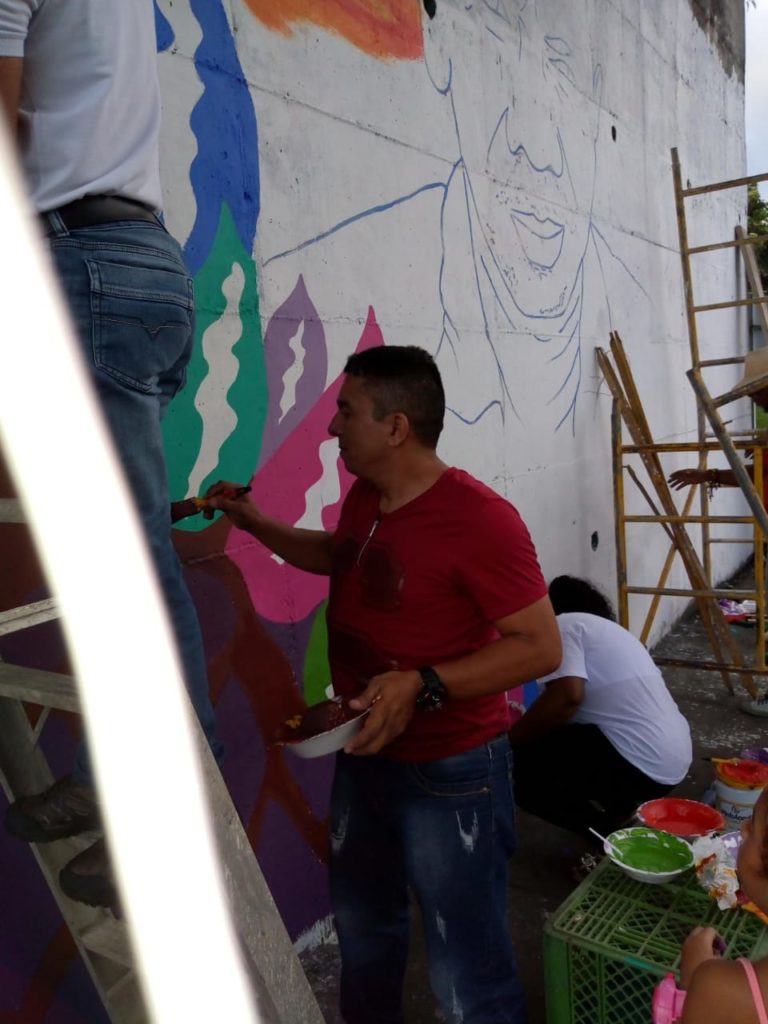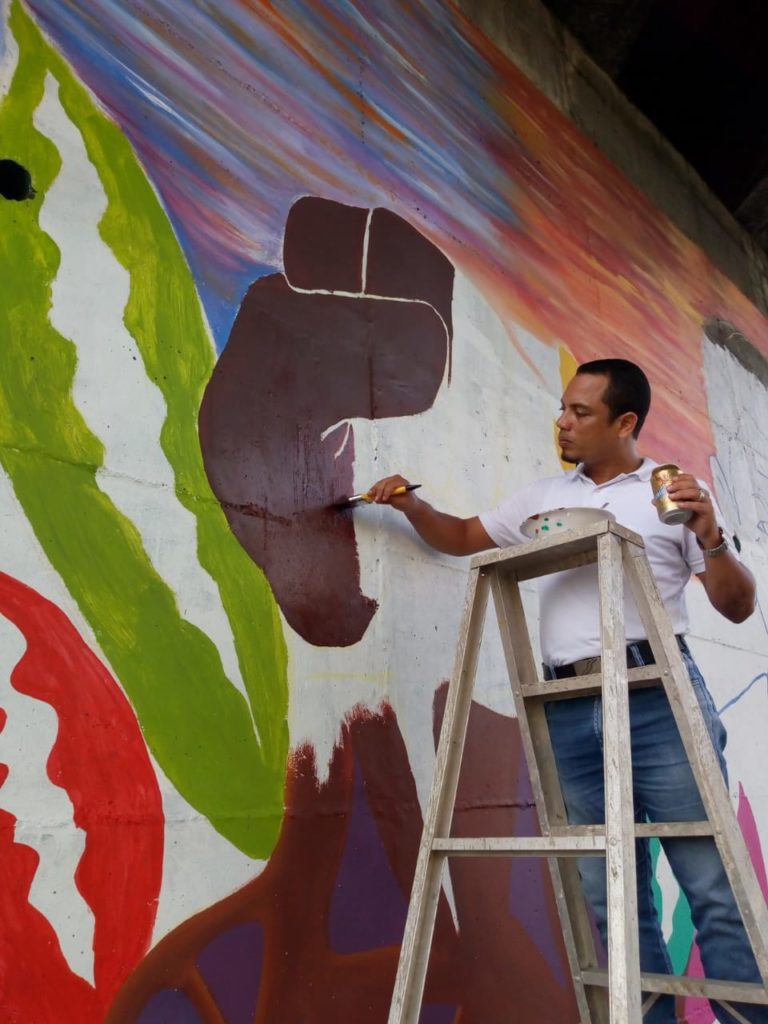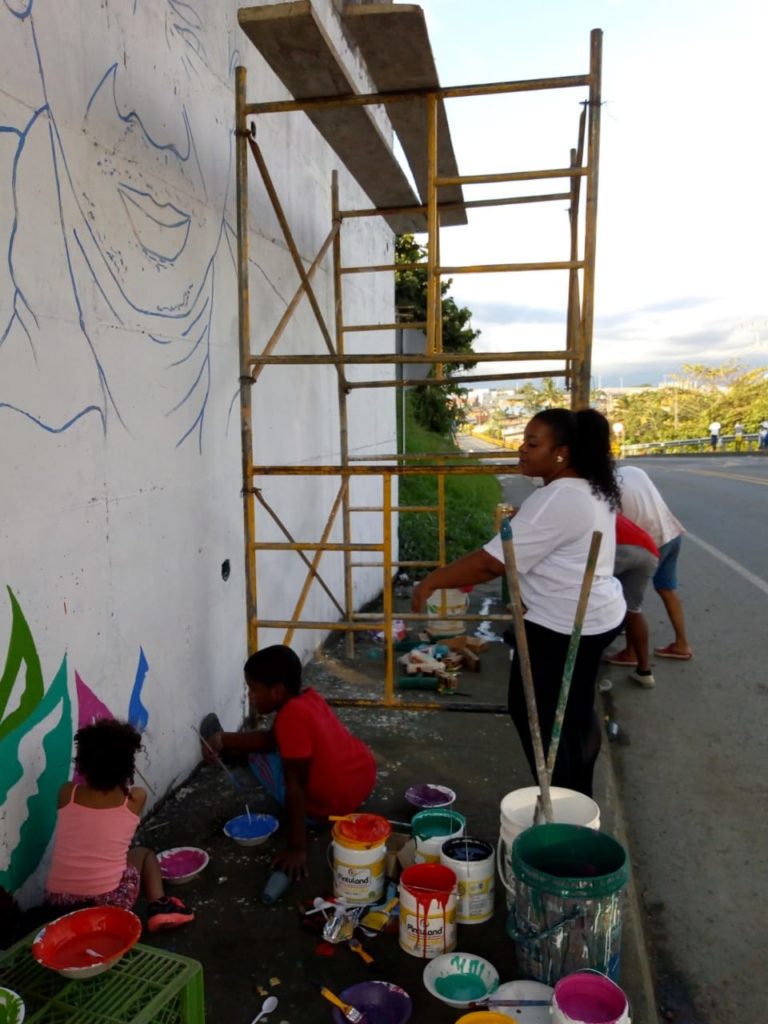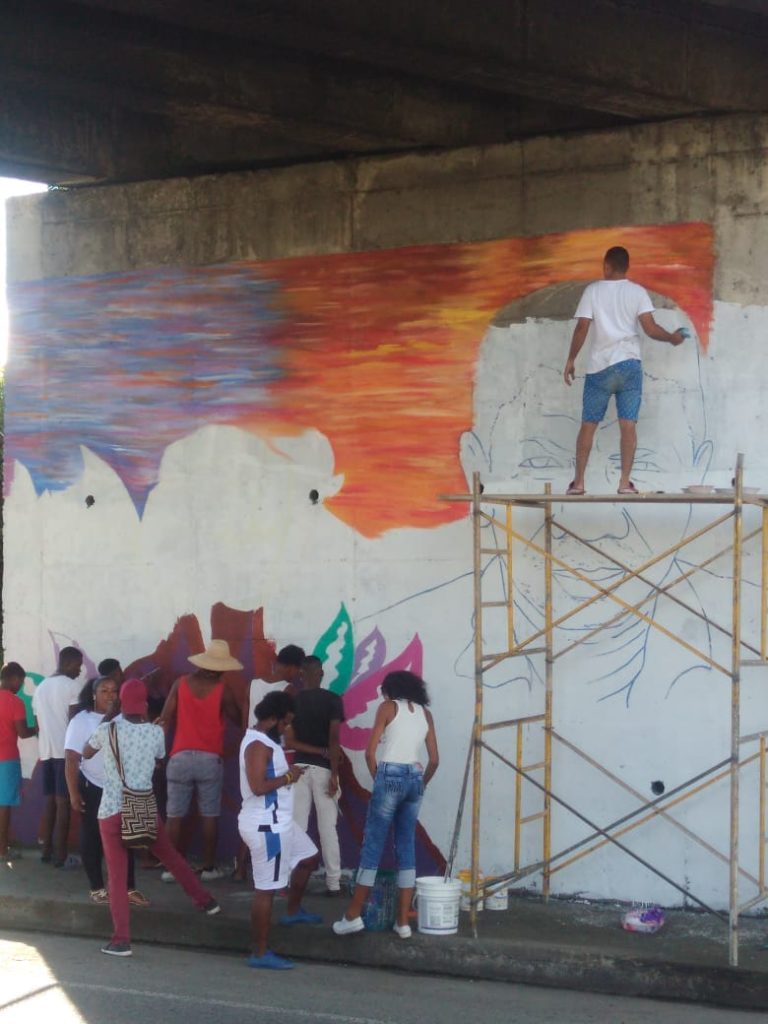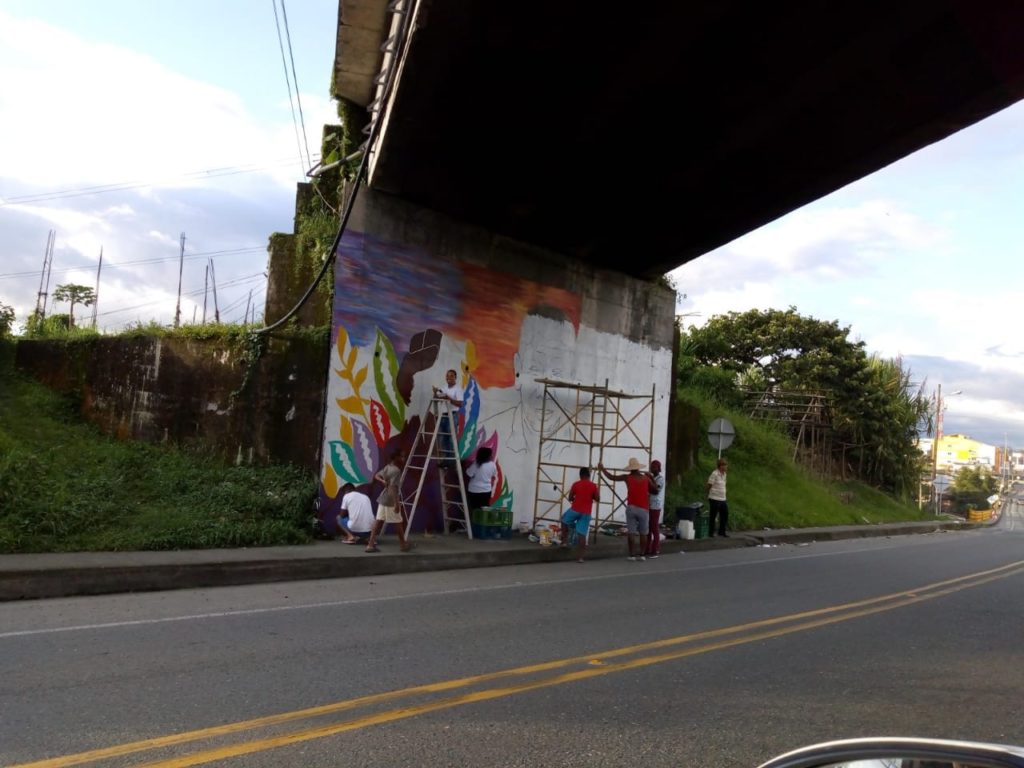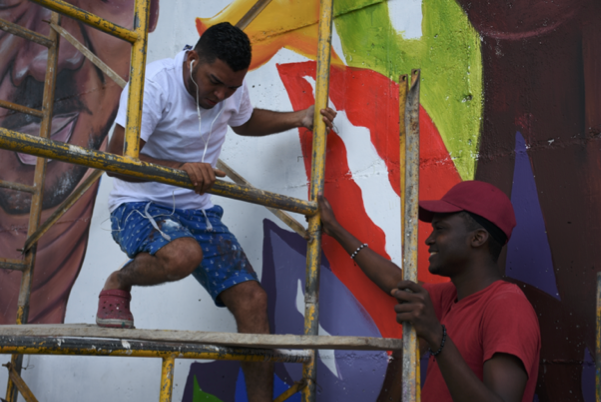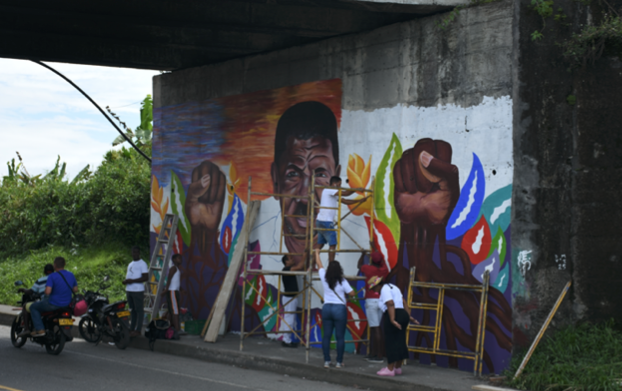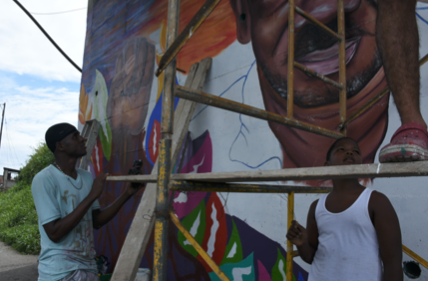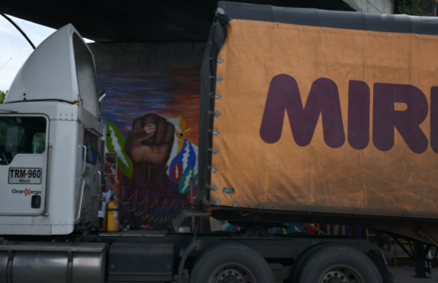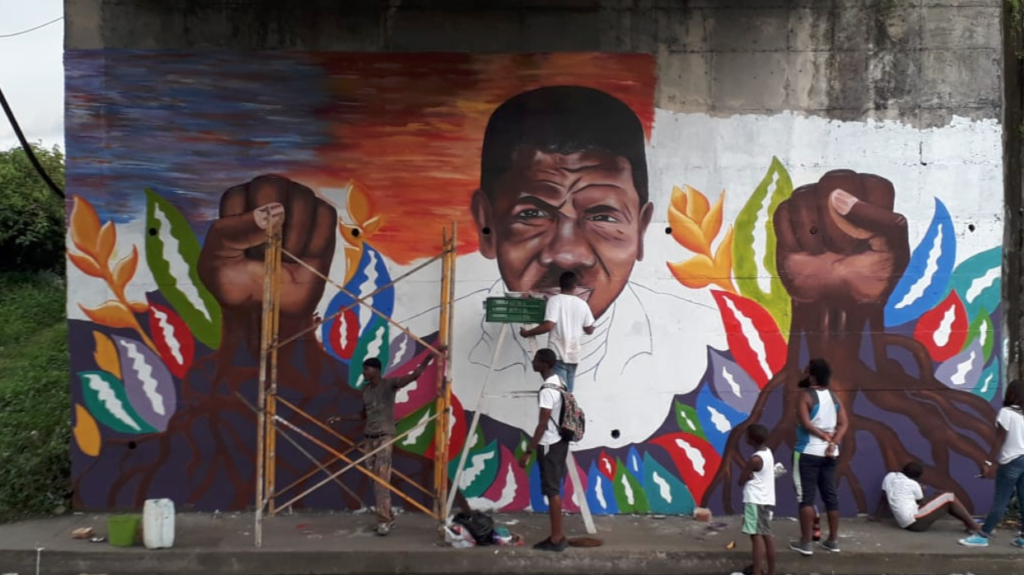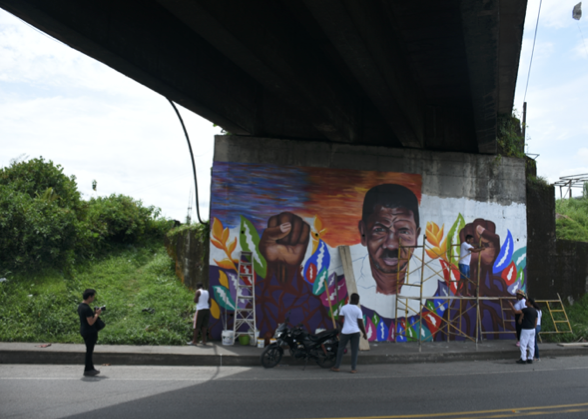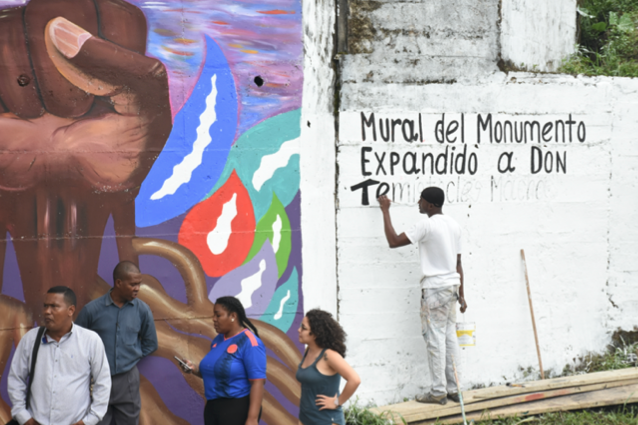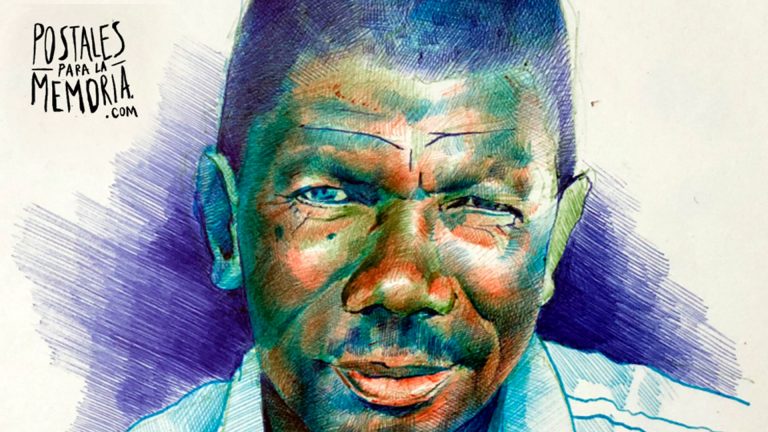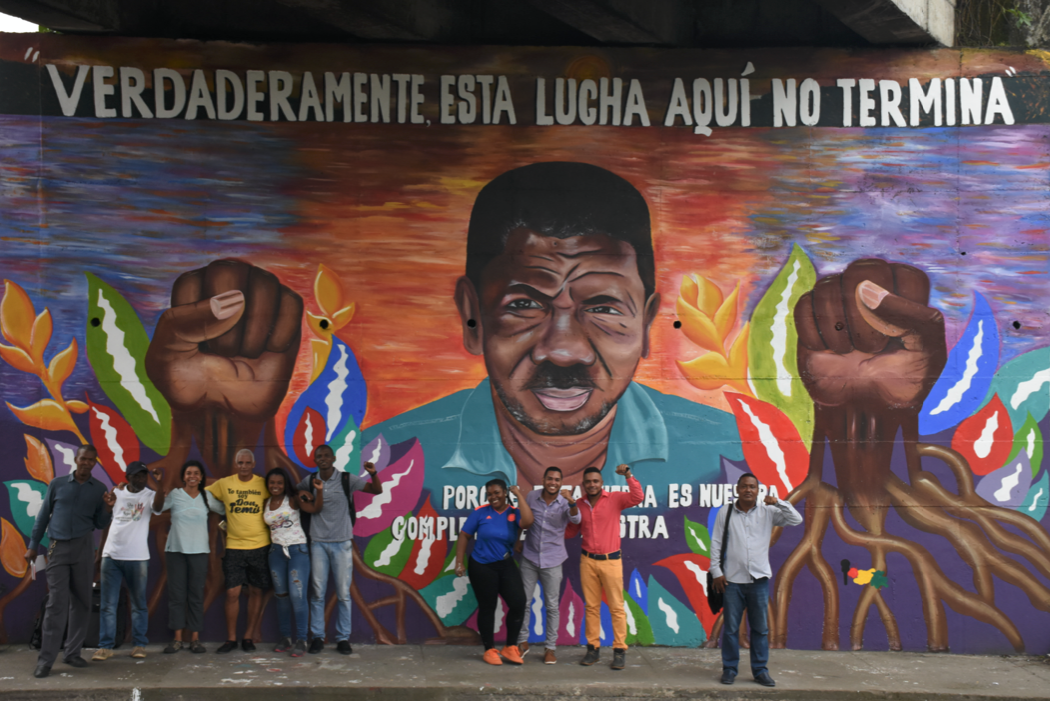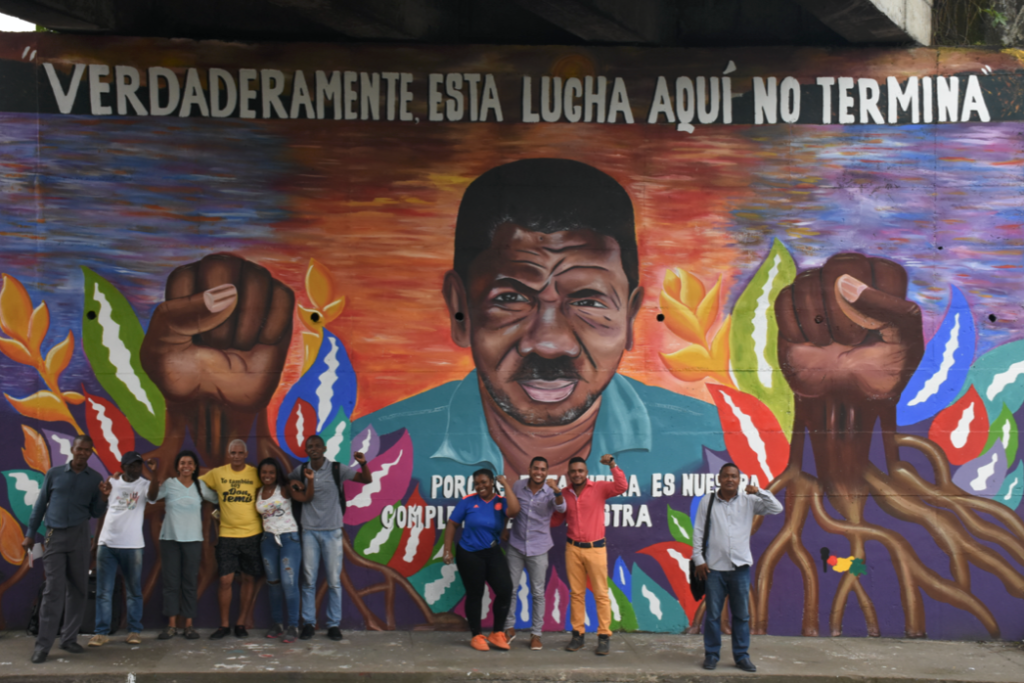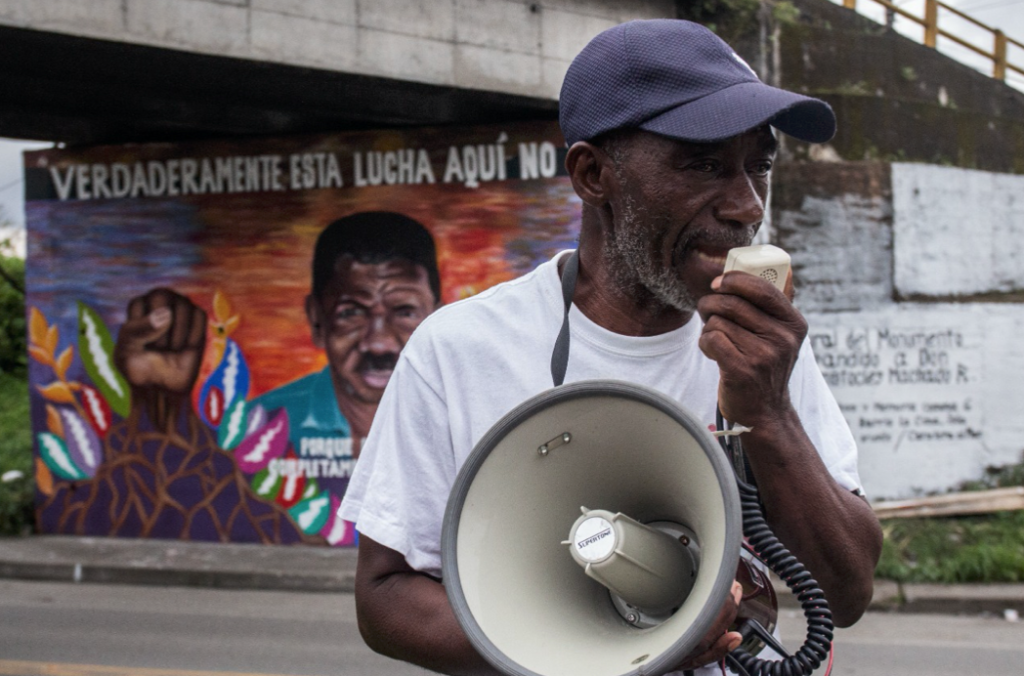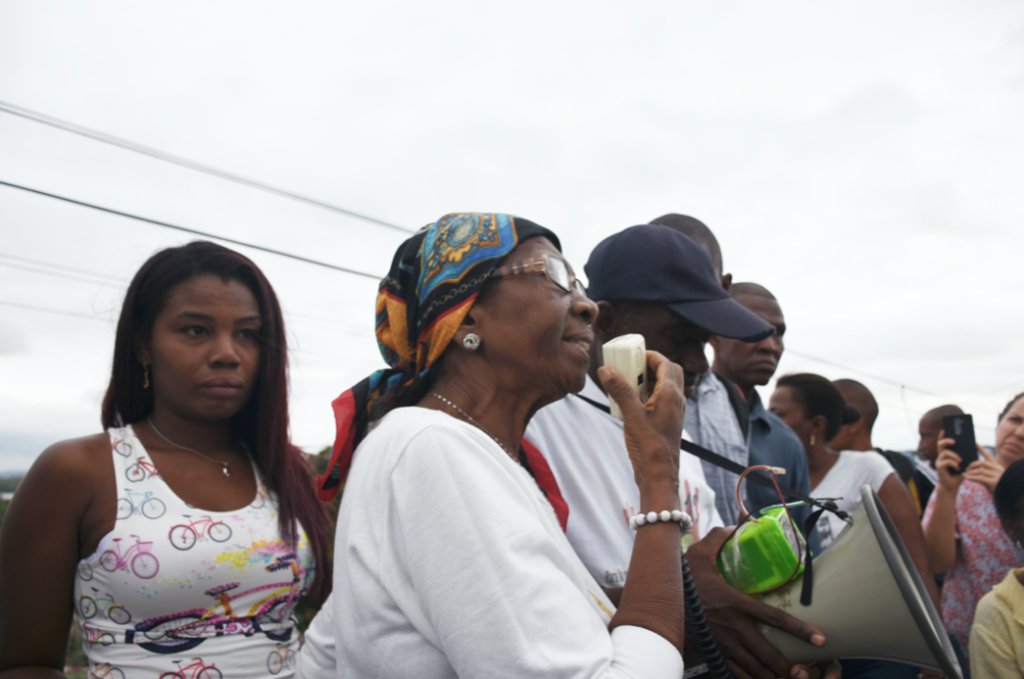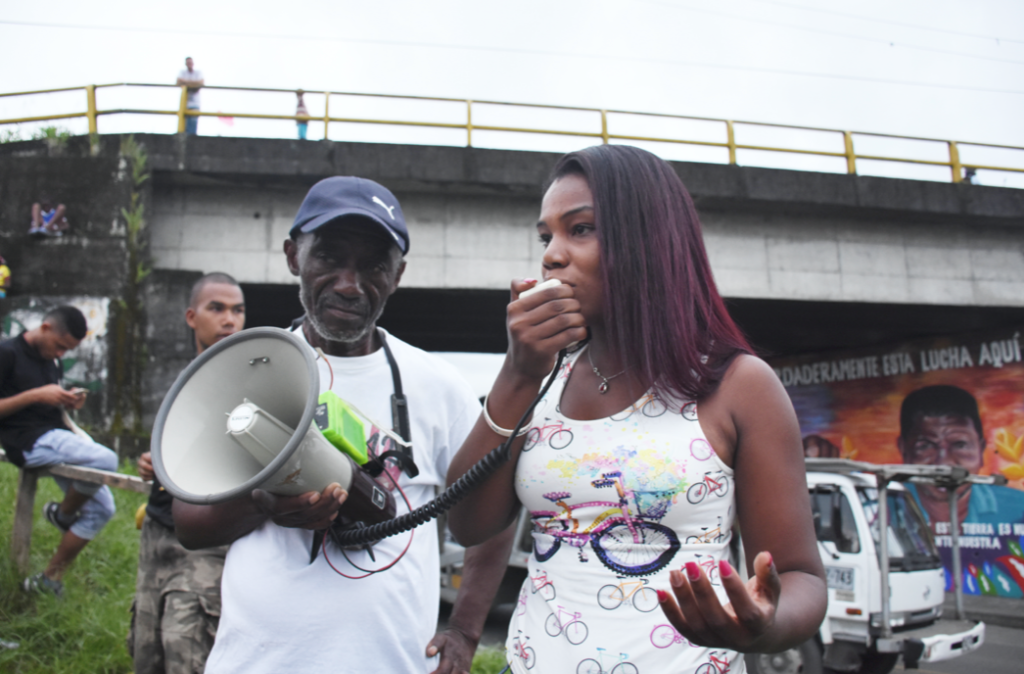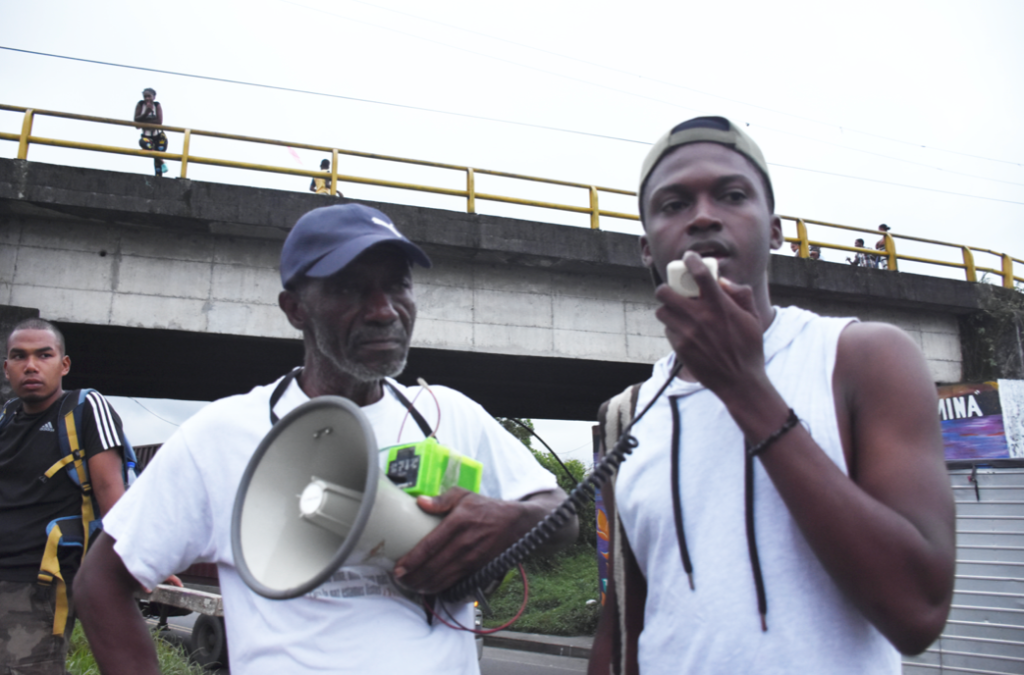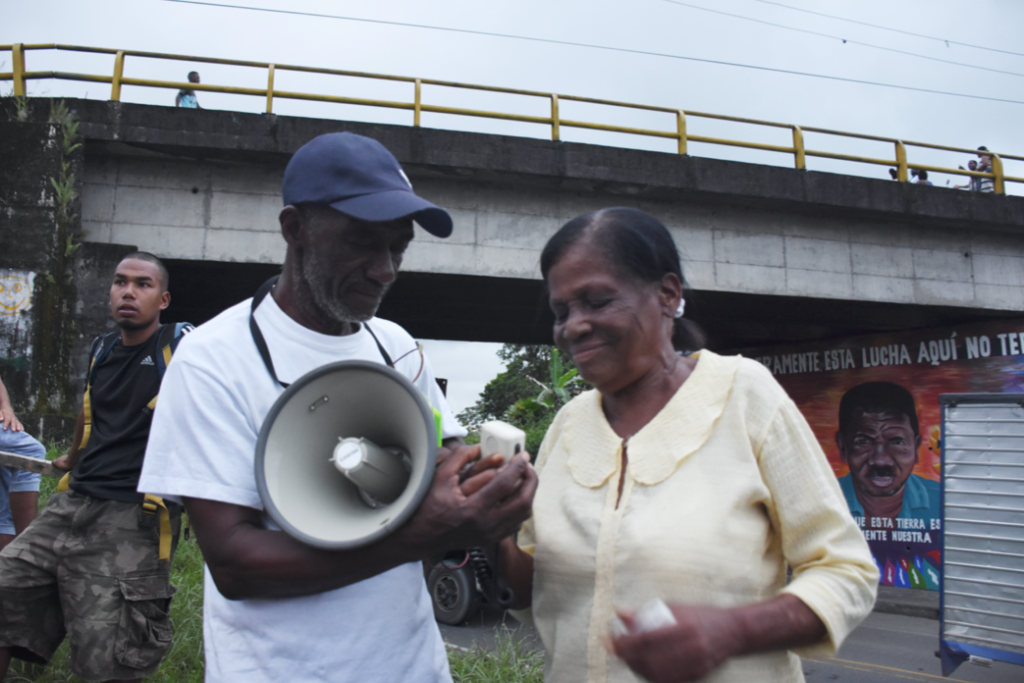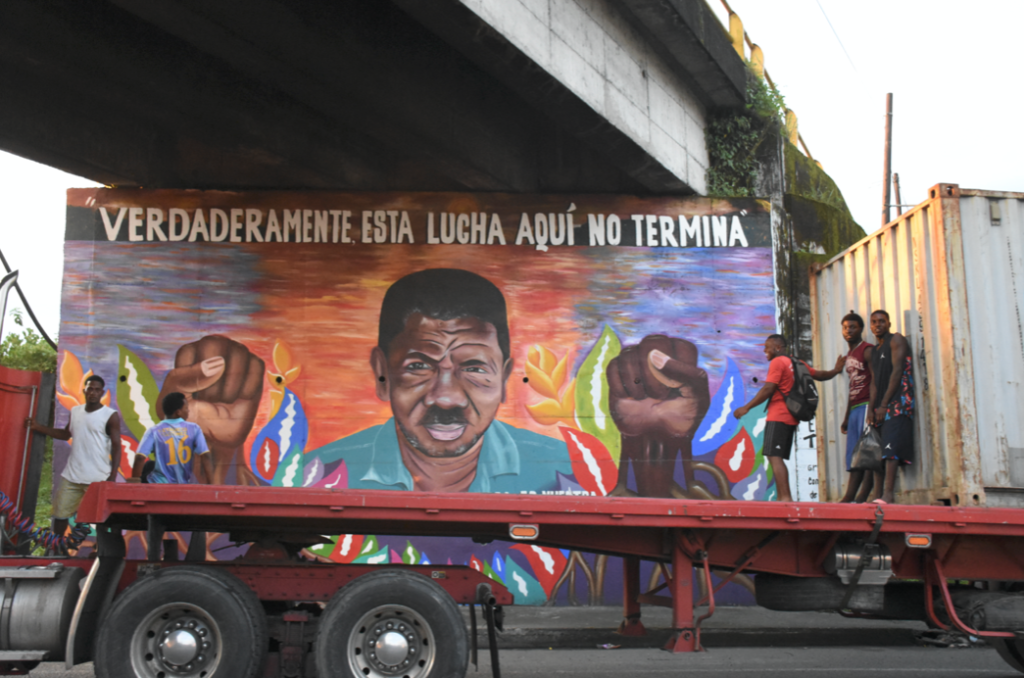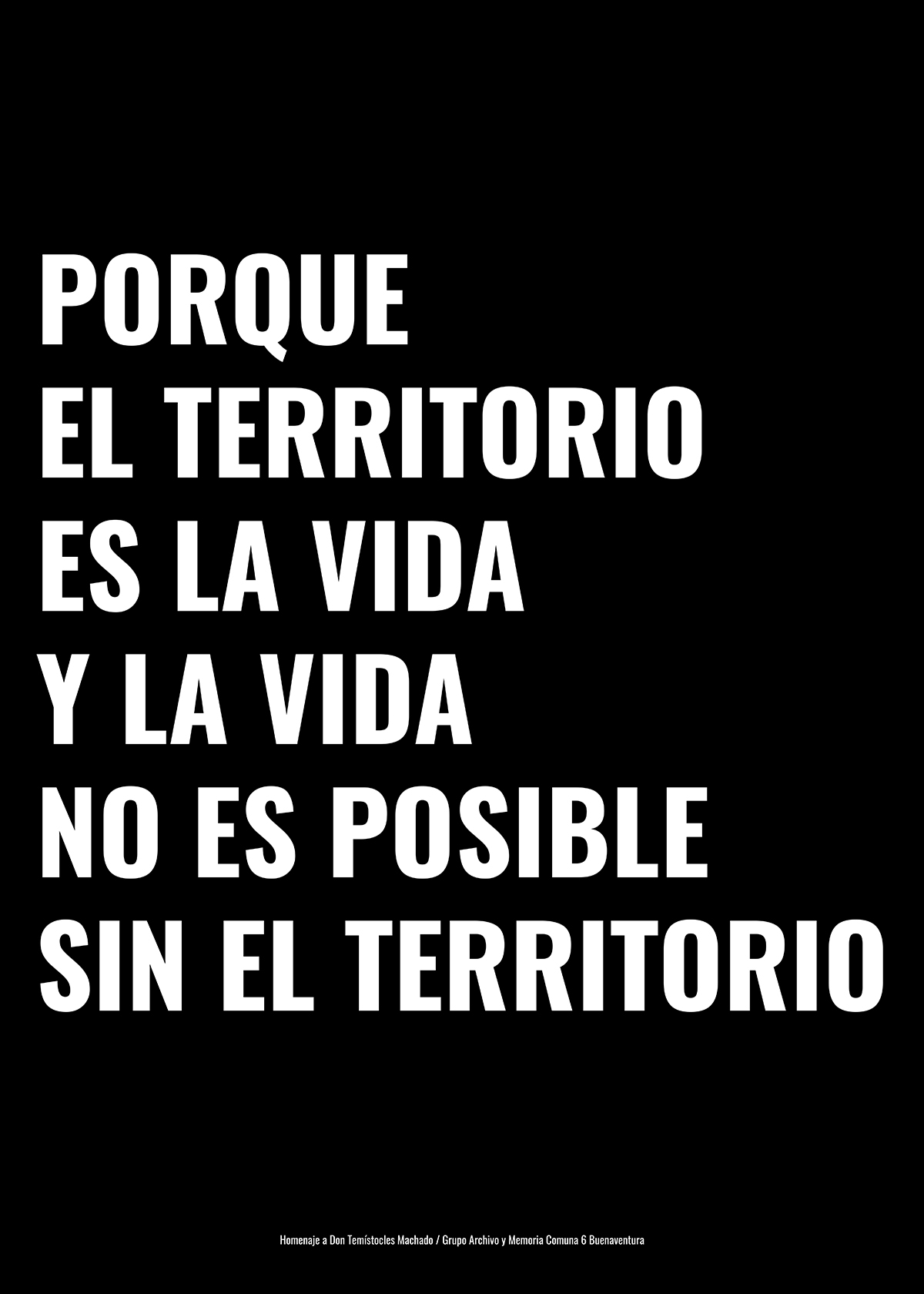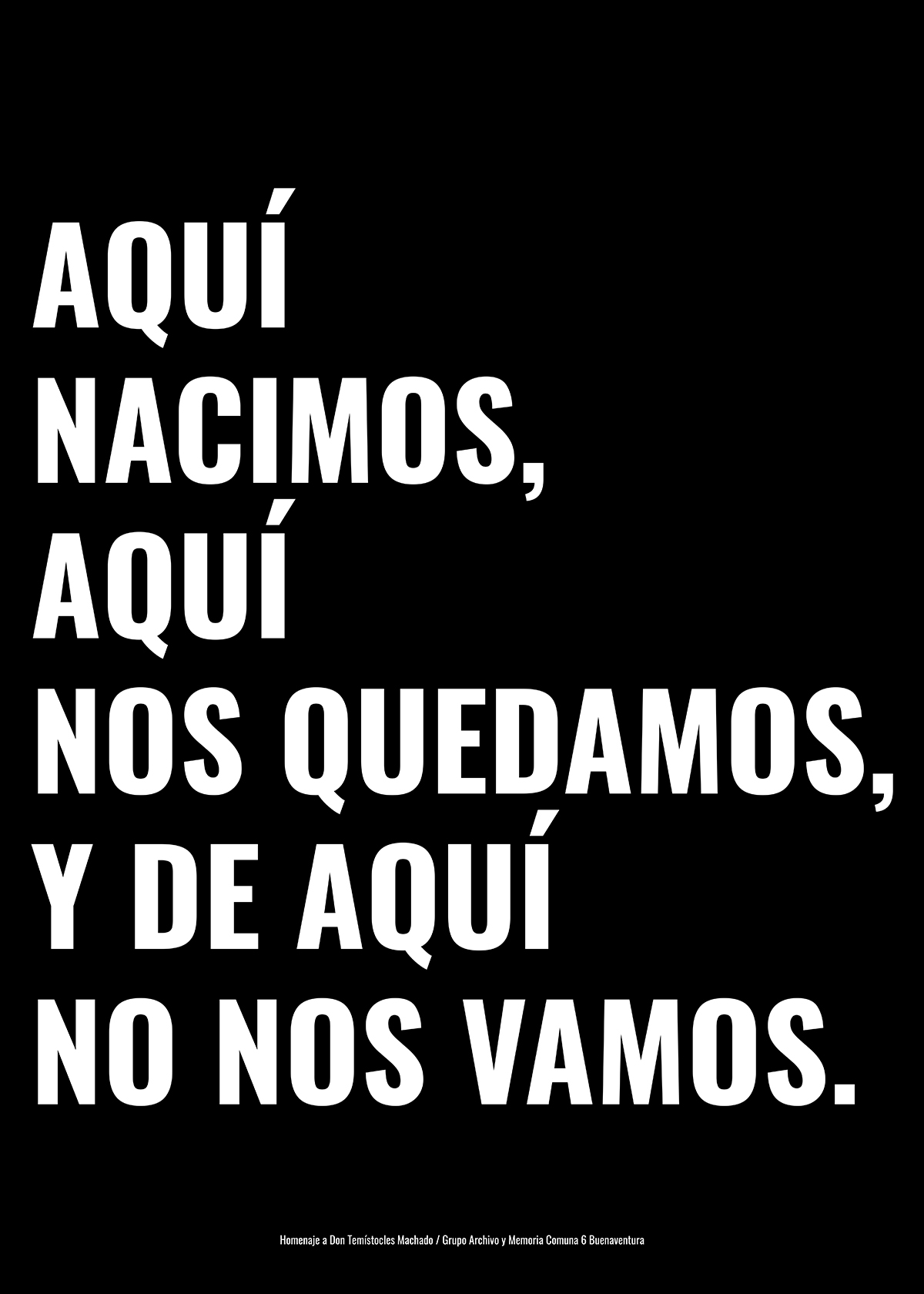Temístocles Machado Renteria: Artistic intervention and the struggle for justice
Together with activist Juan Rodrigo Machado Mosquera from the Colombian city of Buenaventura artist Liliana Angulo Cortés presents her artistic strategy of solidarity with local protests against land deprivation of Afro-Colombian peoples.
Machado Mosquera’s father, Temístocles Machado, was a community leader who represented different communities in Commune 6 and throughout the city of Buenaventura. The capitalist development imposed by the Colombian State has generated violence, usurpation and displacement. In his defense of the land Temístocles Machado created an archive containing more than 90.000 documents of the community’s judicial processes aiming to prove their collective ownership of the territory.
In 2018 Machado was murdered. Since then a group of community leaders, including his son Juan Rodrigo Machado Mosquera, continue the struggle, safeguarding and preserving the knowledges of their communities.
The following photo essay revisits the story of the struggle of the Black community in Buenaventura through both activist and artistic intervention.
Physical map of the territory of Colombia including the island territory. The Map shows the regions caused by the geography of the Andes mountain range: the Andean area, the Pacific region, the Caribbean region, the Amazon region, the plains Sources maps: Map of Colombia Agustín Codazzi Geographic Institute.
The territory of Colombia. Areas inhabited by the Afro- descendant population according to the Population Census of 2005. Map Source: DANE (National Administrative Department of Statistics)
Map indicating the territories of indigenous communities in Colombia. Source map: lastribusindigenas.blogspot.com
The territory of Colombia. In the country the areas inhabited by the Afro-descendant and indigenous population are the areas most affected by the different armed groups: guerrillas and narco- paramilitaries. Sources maps: Map of Colombia (Afro-descendant population 2005)
Map of Colombia Results plebiscite peace agreement 2016 by departments. The green areas are the departments in which the majority of the population voted to stop the war and say yes to the peace agreements signed in Havana by the government and the FARC guerrillas.
The maps show urban areas in red mainly in the Andean area, regions where war has been least lived, red shows historically privileged areas where power, resources and wealth have been centralized. On the map the areas marked in green coincide with the areas of greatest poverty and inequality. Source Image: Wikimedia Commons.
Map of the inequality in Colombia. Source: Unperiodico.unal.edu.co
Poster Don Temis Live Carajo! Designed by the Inter-Organizational Committee Buenaventura – 2019
View of Cascajal Island in Buenaventura.
Above: Around 1925 when the Black communities that inhabited the area began the process of gaining ground to the sea, filling with detritus the coastal area of the island. Below: current image of the port of Buenaventura and the “Bajamar” (low tide) neighborhoods built by the community. The port is located in the territory occupied by the destroyed Cristo Rey and Balboa neighborhoods to build a violent displacement of the communities. Now for the port expansion they want to move the communities to the other side of the island and throughout the continental coastal area. Source: Archive and Community Memory Group 6
Image taken from the Buenaventura port development official plan that does not include the visions development of the community.
The Buenaventura Master Plan aims to occupy the areas inhabited by the communities and the natural reserves in order to develop new docks, a cargo airport, storage areas and parking of cargo trucks. This type of development benefits only international capitals and free trade agreements between countries that are part of the Pacific Alliance. Source: Findeter – Buenaventura
Image taken from the Buenaventura port development official plan that does not include the visions development of the community.
The Buenaventura Master Plan aims to occupy the areas inhabited by the communities and the natural reserves in order to develop new docks, a cargo airport, storage areas and parking of cargo trucks. This type of development benefits only international capitals and free trade agreements between countries that are part of the Pacific Alliance. Source: Findeter – Buenaventura
Map of the Territory of Buenaventura that shows Cascajal Island connected to the continental land by the Piñal Bridge (Pineapple Orchard Bridge). In the upper part, the Estero Aguacate (Avocado Estuary) and in the lower one the Estero San Antonio (San Antonio Estuary). Both are areas of mangrove ecosystems threatened by the port expansion. These are also areas inhabited by the Black and indigenous communities of Buenaventura.
Map of the Territory of Buenaventura that shows Cascajal Island connected to the continental land by the Piñal Bridge (Pineapple Orchard Bridge). In the upper part, the Estero Aguacate (Avocado Estuary) and in the lower one the Estero San Antonio (San Antonio Estuary). Both are areas of mangrove ecosystems threatened by the port expansion. These are also areas inhabited by the Black and indigenous communities of Buenaventura.
MR TEMISTOCLES DEFENDED THE TRADITIONAL PRACTICES OF THE BLACK COMMUNITIES IN A SUSTAINABLE RELATIONSHIP WITH THE ENVIRONMENT. THESE IMAGES OF DON TEMIS SHOW HIM APPRECIATING THE AVOCADO CREEK AND THE NATURAL CROPS IN HIS LAND BEFORE THE CONSTRUCTION OF THE INTERNAL ALTERNATIVE HIGHWAY.
THE ENJOYMENT OF THE COMMUNITY IS REPRESENTED IN THIS PICTURES. THIS WAS ONE OF THE GREAT DREAMS OF DON TEMISTOCLES MACHADO. NOW IN 2019 THE ESTUARIES, CREEKS AND RIVERS HAS BEEN INVATED BY USURPERS AND THE HYDRIC RESOURSES HAVE BEEN POLUTED.
ANTICIPATING THE ENVIRONMENTAL DAMAGE AND THE TERRITORIAL AFFECTATION CAUSED BY THE GOVERNMEMT’S DEVELOPMENTAL PROJECTS AND THIRD PARTIES’ INTERVENTIONS, MR. TEMISTOCLES CARRIED OUT ACTIVITIES TO DOCUMENT AND RECOGNIZE THE COMMUNITIES LAND IN ORDER TO DEFEND THEM.
THE MANGROVE FOREST ECOSYSTEM IS A FUNDAMENTAL PART IN THE SURVIVAL AND FOOD SOVEREIGNITY FOR THESE COMMUNITIES. THEY FISH AND ALSO NAVEGATE THE ESTUARIES AS A WAY TO TRANSPORT THEIR CROPS AND WOOD TO THE BUENAVENTURA’S MARKET. NATIVE ACTIVITIES OF THE TERRITORY AS THE DAILY FISHING AND THE RECOLLECTION OF SEA PRODUCTS.
HERE DON TEMIS IN ONE OF HIS TRIPS, A STRATEGIE OF RECOGNITION AND CONTROL OF THE ESTUARY.
IMAGES OF HOW THE TERRITORY LOOKED LIKE BEFORE AND DURING THE CONSTRUCTION PROCESS OF THE INTERNAL ALTERNATE HIGHWAY.
THE INSTITUTIONS IN THE CITY OF BUENAVENTURA DO NOT RECOGNIZE THE RIGHTS OVER THE LAND TO THE BLACK COMMUNITIES. BUT THOSE SAME INSTITUTIONS VALIDATE THE OCCUPATION DERIVED FROM THE USURPATION OF THE TERRITORY BY THIRD PARTIES WITH FAKE PROPERTY TITLES. THESE ARE PROCESSES OF CORRUPTION AND STRUCTURAL RACISM.
IMAGES OF THE DETERIORATION OF THE FLORA IN THE ECOSYSTEM. AS A CONSECUENCE OF THE DEVELOPMENT INTERVENTIONS A BIG PART OF WILD FAUNA DECREASED. THIS CREEK WAS USED BY THE COMMUNITY AS A WATER SOURCE (AS THEY LACK OF A PROPPER WATER SUPPLY) BUT TODAY IS POLLUTED AND CANNOT BE USED.
VIA ALTERNA INTERNA
THE INTERNAL ALTERNATIVE HIGHWAY IS THE TRAFIC ROUTE OF ABOUT 3.000 TRUCK DAILY ENTERING AND LEAVING THE PORT AREAS . IT GOES THROUGHT THE COMMUNITY LAND AND WAS GENERATED BY THE GROWTH OF THE PORT LOGISTICS AREAS SUCH AS CONTAINER AND PARKING. IN CONSECUENCE, THE LAND BECAME MORE ATRACTIVE FOR USURPERS AND LAND THIEVES.
Image of a knocked down sign that sought to inform and protect the community territory of possible land usurpers. “This lot is community property. It is intended for the construction of the Community Multiple Home ”.
The territory of the Commune 6 in particular the Isla de la Paz neighborhood has been usurped to make container warehouses and cargo parking areas. This road led to the community beach at El Estero Aguacate. Now you cannot enter due to the metal bars installed by a private owner who now owns the land.
The territory of the Commune 6 in particular the Isla de la Paz neighborhood has been usurped to make container warehouses and cargo parking areas. This is the panorama that has become common in the area since the opening of the Alternate Internal Way. Loading and unloading areas of containers entering and leaving ports.
In the image the last piece of land left to Don Temístocles Machado in the Isla de la Paz neighborhood of what was the land of his ancestors. His house is now surrounded by container warehouses and he had to turn his land into a cargo truck parking lot in order to survive. Only the fruit trees around the house that is seen in the lower right corner of the image remain.
OVER TIME THE LEADERSHIP OF MR. TEMISTOCLES MACHADO TRASCENDED HIS COMUNNITY AND HE ARTICULATED WITH OTHER SOCIAL AND POLITICAL PROCESSES IN BUENAVENTURA. SINCE THE STRUGGLES OF THE WHOLE CITY ARE SIMILAR AND ARE CAUSED BY THE PROYECTS OF EXPANSION FOR THE PORT.
AFTER MANY YEARS ENDURING HARSH CONDITIONS, LIKE NOT HAVING RUNNING WATER IN THEIR HOMES, THE CITIZENS OF BUENAVENTURA DECIDED TO STAR A CIVIL STRIKE IN 2017. “THE CIVIL STRIKE TO LIVE WITH DIGNITY AND PEACE IN THE BUENAVENTURA TERRITORY”
THE CITIZENS OF BUENAVENTURA DESIGNATED EIGHT CULTURAL ENCOUNTER PLACES FOR THE COMMUNITY TO MEET DURING THE CIVIL STRIKE. IN THE IMAGE THE “SABROSURAS” MEETING PLACE CELEBRATING A RELIGIOUS SERVICE.
MULTITUDINARY MARCHS DURING THE STRIKE THAT SHOWED THE UNITY OF THE BUENAVENTURA’S PEOPLE AND THE DISSATISFACTION TOWARDS THE ABBANDONMENT AND THE CORRUPTION OF THE LOCAL, REGIONAL AND NATIONAL GOVERNMENTS EXPRESSED IN MANY DIFFERENT WAYS.
PICTURE OF THE FIRST DIALOGUES WITH THE GOVERNMENT DURING THE DAYS OF THE CIVIL STRIKE. IN THE IMAGE REPRESENTATIVES OF THE CIVIL STRIKE COMMITTEE. IT IS FORMED BY MORE THAN 120 ORGANIZATIONS FROM THE CITY.
MEETING PLACE: ISLA DE LA PAZ NEIGHBOURHOOD, COMMUNE 6 SOCIAL AND REIGIOUS LEADERS AT THE BEGINNING OF THE CIVIL STRIKE.
THE COMMUNITY AND THE PEOPLE OF BUENAVENTURA IN THE TERRITORIAL, HOUSING AND INFRASTRUCTURE WORK TABLE. PLANNING PROPOSALS AND ORGANIZING STRATEGIES IN RESPONSE TO THE ELUSIVE RESPONSES OF THE GOVERNMENT. THE CIVIL STRIKE COMMITTEE IS ORGANIZED IN WORK TABLES FOR ALL IMPORTANT ISSUES TO SOLVE IN BUENAVENTURA.
CULTURAL ACTIVITIES LIKE THE COMMUNITY COOKING POT, TRADITIONAL MUSIC AND DANCE MADE POSSIBLE THE INTEGRATION AND RESISTANCE OF THE ENTIRE CITY DURING THE CIVIL STRIKE. IN THE IMAGE THE MEETING POINT AT ISLA DE LA PAZ NEIGHBORHOOD IN THE INTERNAL ALTERNATIVE HIGHWAY
PACIFIC CIVIL ACTION WAS CONFRONTED WITH ATTACKS AGAINST THE COMMUNITY IN RURAL AND URBAN AREAS OF THE CITY OF BUENAVENTURA. IN THE IMAGES THE INDIGENOUS COMMUNITIES IN LA DELFINA RURAL MEETING POINT AND ISLA DE LA PAZ NEIGHBORHOOD AT THE INTERNAL ALTERNATIVE HIGHWAY. THE CULTURAL MEETING POINTS WERE REPRESSED WITH POLICE ABUSE BY ANTI-RIOT MOBILE SQUADS (ESMAD).
CULTURAL MEETING POINTS WERE STOPING THE ONLY TWO ARTERIAL HIGHWAYS OF THE CITY WHERE THE CARGO FROM THE PORTS IS TRANSPORTED. THIS WAS DONE IN ORDER TO CALL THE GOVERNMENT’S ATTENTION AND FORCE THEM INTO DIALOGUE. THE GOVERNMENT RESPONDED WITH THE ANTI-RIOT REPRESSIVE FORCES.
View of the Internal Alternate Highway on June 5 after the onslaught of ESMAD from the meeting point of Isla de la Paz during Civic Strike to live with dignity and peace in the territory. The workshop with the children of Isla de la Paz was after the incursions of ESMAD on May 29 and June 5, those were the strongest police attacks.
During the days after the worst moments of the repression by the ESMAD in the civic strike, the 5th of Jun 2017. Liliana Angulo Cortés, Danny Ramirez and María Elena Cortes met with the community of Isla de la Paz and carried out an exercise in the elaboration of trauma with the children through a drawing workshop. The children’s drawings and testimonies showed their perception of the acts of violence perpetrated by state forces.
Despite attacks by the repressive forces of the State after 22 days of resistance, the community achieved victory during the Civic Strike to live with dignity and peace in the territory of Buenaventura. Source: Grupo de Archivo y Memoria Comuna 6
Jun 6th 2017, It was agreed with the government of President Juan Manuel Santos the implementation of an autonomous investment budget for the city of Buenaventura that would lead the city to solve its main needs. It is expected that this agreement will bring development for the communities to solve the historical neglect from the Colombian State. Source: Grupo de Archivo y Memoria Comuna 6
AFTER 22 DAYS OF RESISTENCE THE FINAL NEGOTIATION’S AGREEMENT BETWEEN THE COMMUNITY LEADERS AND THE GOVERNMENT WAS REACHED. SOMETHING WITHOUT PRECEDENT. A SPECIAL PLAN AND BUDGET FOR THE CITY OF BUENAVENTURA.
In November 19th, 2017, the Radio Conversa program was carried out with Don Temístocles Machado, Carmela Chaves, Rocío Segura, María Elena Cortés and Yudy Angulo.
“Radio Conversa is a radio space that promotes meetings and conversations about memory, territory, social fabric and culture; travels and disseminates the words, stories and feelings of various communities in Colombia, from the voice of the inhabitants and social leaders. This is a project led by Oscar Moreno, artist and professor at the Jorge Tadeo Lozano University”. A project by Oscar Moreno Escárraga. Images courtesy of Radio Conversa, Oscar Moreno Escarraga
In the program, Don Temístocles Machado, who had a prodigious memory, described the way in which communities populated the area in the twentieth century. He then continued explaining the different types of violence to which they had been subjected, and community struggles facing development projects imposed by the State and port expansion projects that seriously affect the area. Images courtesy of Radio Conversa. Oscar Moreno Escarraga.
Mr. Temístocles Machado generated an archive of probative material and documents related to the judicial processes that were carried out in the community for the defense of the territory. Images courtesy of Radio Conversa. Oscar Moreno Escarraga.
THE ISSUES REGARDING THE LAND CAUSED BY THE PORT DEVELOPMENTAL MASTER PLAN DID NOT ENTER THE FINAL NEGOTIATION’S AGREEMENT BETWEEN THE COMMUNITY LEADERS AND THE GOVERNMENT. MR. TEMISTOCLES MACHADO WAS KILLED FOR DEFENDING HUMAN RIGHTS AND THE TERRITORIES OF ANCESTRAL BLACK COMMUNITIES IN 2018
Don Temistocles archive has more than 19,000 pages and was a tactic for the defense of the territory against the corruption strategies of the Mayorlarly office and of the courts of Buenaventura in which a complete judicial process could disappear without a trace. Image source: Centro Nacional de Memoria Histórica. La tierra es arraigo, no dinero. Temístocles Machado
The processes registered in the archive of Mr Temistocles are individual and collective. He documented the different cases and the types violence to which the inhabitants of the area were subjected. Image source: Centro Nacional de Memoria Histórica. La tierra es arraigo, no dinero. Temístocles Machado. Source: Youtube
The power of Mr. Temistocles was the knowledge of the history of the community and of the details of the processes for the defense of the territory. The fame of his archive and his leadership grew when he faced Government institutions and private usurpers who had the support of corrupt officials. Image source: Centro Nacional de Memoria Histórica. La tierra es arraigo, no dinero. Temístocles Machado. Source: Youtube
Threats to his life appeared and intensified over time. The physical archive was digitized by the National Center for Historical Memory as a way to protect the life of Mr. Temistocles. The Comuna 6 Buenaventura Temistocles Machado Digital Archive Fund was created at the Virtual Archive of Human Rights. Image source: Centro Nacional de Memoria Histórica. La tierra es arraigo, no dinero. Source: Youtube
After meeting on Radio Conversa, we agreed to work with Don Temístocles on strategies based on art practice and his archive practice to convey to the community the memory and history of community struggles, in order to achieve an empowerment of the People. Image source: Centro Nacional de Memoria Histórica. La tierra es arraigo, no dinero. Temístocles Machado. Source: Youtube
This work would have started in March 2018 with the support of the Goethe Institute through the Future of Memory project. Image source: Centro Nacional de Memoria Histórica. La tierra es arraigo, no dinero. Temístocles Machado. Source: Youtube
Mr. Temístocles Machado was murdered on January 27, 2018. The community was mired in despair and fear since its main leader who was the most prominent voice was silenced. Leaders who worked on their side had to flee. The community in a state of disorientation and terror was afraid to continue. When we returned to Buenaventura, we decided to continue working with the community without knowing very well how to approach the work of the archive without Mr. Temistocles and with all the pain of grieving for his death. Image: The funeral of Mr. Temístocles Machado. Parqueadero Los Nativos. Barrio Isla de la Paz. Comuna 6 de Buenaventura.
“VELATON” A THOUSAND LIGHTS INICIATIVE IN MANY CITIES IN COLOMBIA. PEOPLE GATHERED TO EXPRESS THEIR SADNESS TO PROTEST AND TRIBUTE TO PAY TRIBUTE TO ALL THE LEADERS MURDERED IN COLOMBIA. AT LEAST 627 LEADERS HAVE BEEN KILLED SINCE THE PEACE AGREEMENT.
CANCHA DE FUTBOL DEL BARRIO LA CIMA
LANDS INTENDED FOR COMMUNITY PROJECTS. AFTER THE MURDER OF THE LEADER TEMISTOCLES MACHADO, HAVE BEEN TRIED TO BE TAKEN AND OCCUPIED BY THIRD PARTIES. THE STRUGGLE TO DEFEND THE LAND CONTINUES FOR THE LEADERS IN THE COMMUNITIES.
The physical archive of Mr. Temistocles was taken from his home in the community to protect the information and his family. It was hidden without anyone knowing his location. The people who knew Mr. Temístocles’ archive besides from him, were the people of the National Center for Historical Memory and the lawyers who accompany the community in judicial proceedings. After meetings with both, we were discouraged to work with the physical archive, however we were granted access to the tabulation of the CNMH digital files of the archive. We worked with his voice and his narration.
The Archive and Memory Group of the Commune 6 is the result of the artistic laboratory that we called: “Por la defensa del territorio de Buenaventura: archivo y monumento Temístocles Machado” Initially just organizing meetings in the different neighborhoods in the framework of the commemoration of the 2017 Civic Strike. Those meetings were excuses to bring the community together. We scheduled a series of documentary film projections on the situation of Buenaventura and the port projects in the Pacific region. In the image, David Paredes, from the Puerto Creativo Collective, presents Trigugá a short film about the resistance of the community against the disaster that could be caused by a port development planned in the Maritime Nature Reserve of the Gulf of Tribuga in the Pacific coast of Chocó.
We held meetings in which we heard the voice of Mr. Temistocles narrating the settlement and the struggles of the community in the communal houses of the Isla de la Paz, La Cima, and El Oriente neighborhoods. Hearing the broadcast of the interview with Don Themistocles were the catalyst for community processing of his death. These meetings were the first spaces in which people met again after the death of Mr. Temistocles and hearing his voice caused a catharsis among the attendees who spoke of the impact caused by the murder. The collective mourning and the hope that the 2017 Civic Strike agreement still produced motivated in the people the community sense and the desire to continue working together.
In the middle of these meetings we found the group of young people that Mr. Temistocles was recruiting for the work with the archive and the memory of the community. Mr. Temístocles’ dream with these young people in the community was to strengthen the new leaderships and create a space that would operate as a community museum of memory. The Group of Archive and Memory from the 6th Commune was created with the leaders, men and women, young and older from the territory of the three neighborhoods: Isla de la Paz, Oriente y La Cima.
The work we did was based on the needs expressed by the community about the creation of a monument to the memory of Don Temístocles Machado. The work on the monument to Don Temístocles led us to explore the territory based on the memories and experiences of the leaders of the community. The voice of Don Themistocles in the recordings made in 2017 ended up being the gateway to understand his archive.
The Archive and Memory Group of the Commune 6 searched for the stories of the first families that populated the territory. Their memories and family albums are alternative sources to learn about the history of the community.
The Archive and Memory Group of the Commune 6 worked based on the search for the stories of the first families that populated the territory. Their memories and family albums are alternative sources to learn about the history of the community. Images of the Gamboa Family family album
The Archive and Memory Group of the Commune 6 compiled photographs that still exist in family albums and personal archives in order to preserve them digitally to protect them from the extreme humidity in Buenaventura. Images of the Gamboa Family album
The Machado family still keeps documents from Don Temístocles’ parents and grandparents and memories of his achievements inhabiting the area. Images of the family album of the Machado Family. Source: Eloisa Machado
Images of the family album of the Machado Family. Source: Eloisa Machado
In Colombia, the visual memory of Afro-descendants has generally been mediated by the eyes of others, these images of families are valuable because they show family life in Buenaventura in the neighborhoods of Comuna 6. In the picture: Eloisa Machado sister of Don Temis with the uniform of the Colegio Pascual de Andagoya Images of the family album of the Machado Family. Source: Eloisa Machado
Image that shows the street built by the community in the Barrio El Oriente, long before the construction of the Alternate Internal Way. On this street the Invías (National Roads Institute) wanted to use it as the the Invías (National Roads Institute) layout without respecting that it is directly in front of the community’s homes. The people of the community led by Don Temis, among others, opposed resistance and the institution had to move the highway a few meters. Images of the family album of the Machado Family. Source: Eloisa Machado
Documents in which Don Temístocles with the president of the Community Action Board of the El Oriente Neighborhood alerts people outside the community that Invías has infiltrated the Prior Consultation process, hiring a questionable woman to develop the work that should be done with the leaders of the neighborhoods. It is proposed to create a resistance block to confront Invías (National Roads Institute) and those who intended to violate the Prior Consultation document, where the agreements with the community were stated. Images of the family album of the Machado Family. Source: Magno Machado
Documents in which the community alerts the national government about the impact that port expansion projects are having on the black and indigenous communities of Buenaventura and the serious environmental repercussions they were causing already in the year 2000. They asked the Colombian national government for help to protect them from the actions that were being taken by the directors of the Port Society.
Those actions aim for the expansion of the port and for the benefit of private capital and without respecting the ancestral communities settled in the Bajamar and coastal areas of Buenaventura. Images of the family album of the Machado Family. Source: Magno Machado
Photocopy of a press clipping of September 6, 2006 that records one of the community’s clashes with the police. The police of the Port evicted more than fifty inhabitants of the Barrio Oriente who had taken the alternate – internal route, which prevented the progress of the works. The decision was made by the Mayor of Buenaventura Saulo Quiñones … after not finding valid the demands of the community. During the eviction, the Public Force was forced to make shots in the air to clear the area and repel attacks … Quiñones reiterated that it is necessary to open the road… because it is necessary to speed up the passage of cargo trucks along Avenida Simón Bolívar to decongest the Port
Source: Magno Machado
“The defender of the rights of the bonaverences has left”: Don Temis was murdered on January 27, 2018. Newspaper that the Machado Family kept on the assassination of Don Themistocles and his legacy. The magnitude of the accompaniment of the Buenaventura community during his funeral is seen in the newspaper photo. Source: Machado Family.
The Archive and Memory Group of the Commune 6 identified community places that represent the struggles for the defense of the territory of Mr. Temístocles and the communities.
Nine community spaces were identified, in those spaces, signs that mark the chronology of the settlement were built and they are part of the monument to Mr. Temístocles Machado that expands within these three neighborhoods of the Commune 6.
Between these spaces, a connection was generated that is also a way of going through the territory from the denunciations, violent events and victories of the community.
LEADERSHIP IN BUENAVENTURA IS INSPIRED BY THE CORAGEOUS STRUGGLE OF MR. TEMISTOCLES MACHADO. PEOPLE HAS UNITED AROUND HIS LIFE EXAMPLE. THE GROUP OF ARCHIVE AND MEMORY OF THE COMMUNE 6 USES ARTISTIC STRATEGIES TO SIGNAL THE HISTORY OF THE ANCESTRAL BLACK LANDS AND THE IMPORTANCE OF HIS LEGACY IN ORDER TO EMPOWER THE COMMUNITIES.
1st. El Oriente Bridg. Murals Temístocles Machado and Commune 6 Struggles. 2007/2018
2nd. El Oriente School / Mi Retoñito Educational Center. 1971
3rd. El Oriente Neighborhood Community Space. 1965
4th. Cabaña comunitaria de la comunidad de La Cima. 2012 – 2013
5th. Bridge over the Gorge The Aguacatico La Cima neighborhood. 1982 – 1983
6th. Cancha Microfootball – Playground. 2012
7th. Caseta Comunal Barrio Isla de la Paz. 2012 – 2013
8th Soccer Field Barrio de la Paz. Future Temístocles Machado Sports Center. 1985
9th. The Natives. Placement of the Monument to Don Temístocles Machado. 1963/2018
The mural that was painted on the bridge of the Barrio Oriente on the Alternate Internal Highway points to one of the main victories of the community led by Don Temístocles Machado against INVIAS.
The mural sought to “humanize” the Alternate Internal Highway, a road where the constant traffic of tractors and cargo makes the communities that inhabit the area invisible.
The Memory and Archive Group of the Commune 6 worked with the youth organization Rostros Urbanos (Urban Faces) to define the message of the mural. The aim was to pay tribute to Don Temis and transmit his struggle and thought to the community. On the other hand, it was sought to make visible the violence to which the communities have been subjected.
Previous sketches for the Mural of Don Temis. Source: Rostros Urbanos
Previous sketches for the Mural of Don Temis. Source: Rostros Urbanos. Artist: Jose Luis Rodríguez Garcerá
Previous sketches for the Mural of Don Temis. Source: Rostros Urbanos. Artist: Jose Luis Rodríguez Garcerá
Truck drivers in solidarity stopped for a while and hold the heavy traffic of the port cargo to allow artists to project the image of Don Temis on the bridge wall. The image circulated through the social networks moved deeply the people of Buenaventura still hurt with the death of Don Temístocles.
The projection of the image of Don Temistocles itself was a very powerful action for the community, which greatly appreciated seeing his presence again in the territory. Many people did not initially know the objective but shared the gesture in their networks.
Photo: “Mural of the Expanded Monument to Don Temístocles Machado”
Location Barrio del Oriente Bridge over the Internal Alternate Way – Buenaventura Credits: Laboratory “Archive and Monument Temístocles Machado” – Artist Liliana Angulo Cortés
Group Archive and Memory Commune 6: María Elena Cortés, María Santos Caicedo, Arcesio Izquierdo, Ana Campaz, Delcy Castro, Juan David Romero, Patricia Herrera, Juan Rodrigo Machado, Eloisa Machado, Magno Machado, Carmen Chávez, Janer Panameño, Hernán Rodríguez, María Esilda Estacio, Oscar Moreno Escarraga and Liliana Angulo Cortés.
La Cima, La Paz and El Oriente Neighborhoods Production: Urban Faces Cultural Association – Jonathan Hurtado
Painters: Jose Luis Rodríguez Garcería and Lenz Smith / Collaborators: Luisa Jaramillo Angulo Made within the framework of “Carretera al Mar” – Goethe Institute and La Tertulia Museum
The Archive and Memory Group of Commune 6 has three defined lines of action:
The Memory Center (itinerant exhibitions / documentation and archiving center / community work for the defense of the territory) This work focuses on documenting the memory of the population of the area and empowering the community against the violence that have affected them.
Urban interventions in the territory (Murals and signs of history about the community struggles)
Organizational, community and pedagogical work. This work aims to strengthening the leadership. Working with communities, particularly with children and youth.
Graphic Work
Because the territory is life and life is not possible without the territory
Truly this struggle does not end here
Here we were born, here we stay and from here we don’t leave
I am also Don Temis
Because this land is ours! completely ours!
